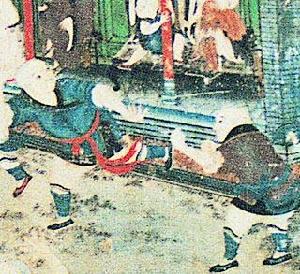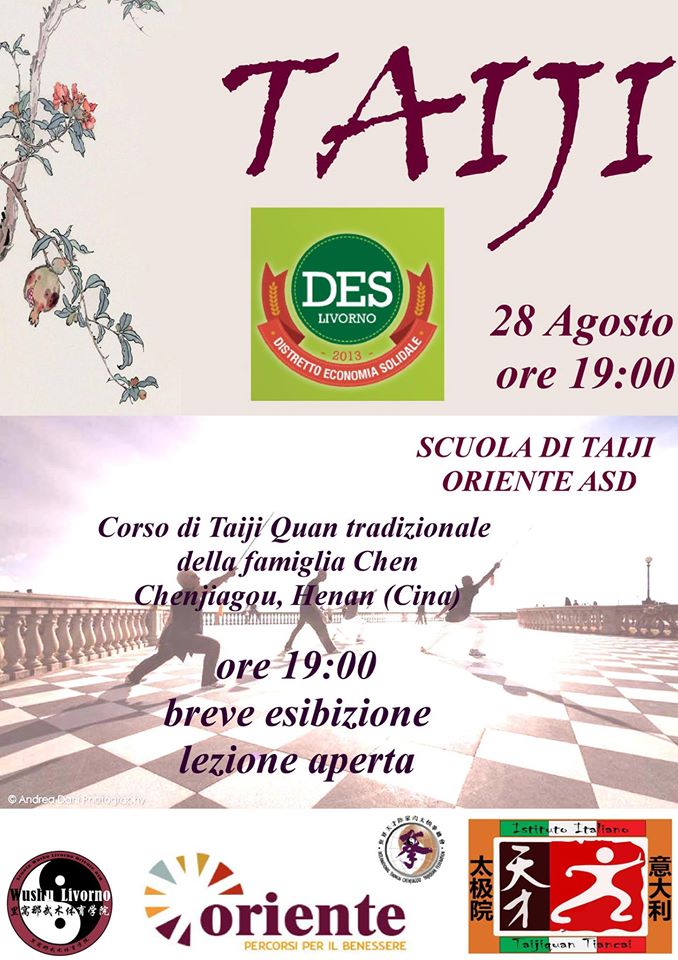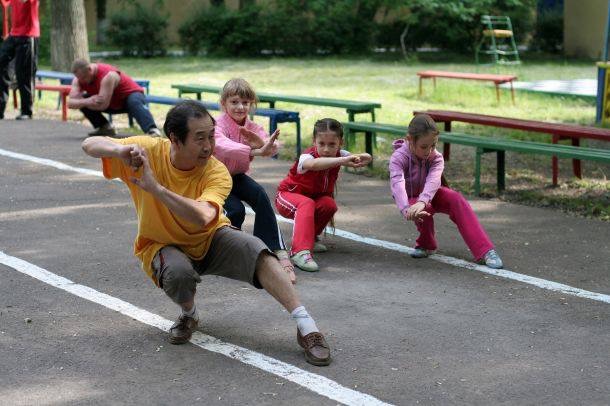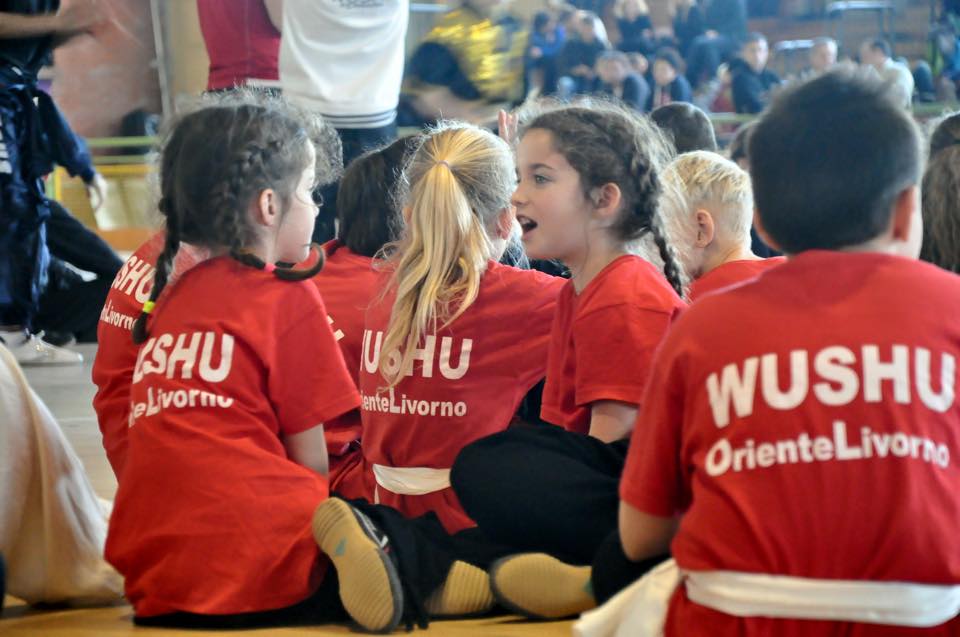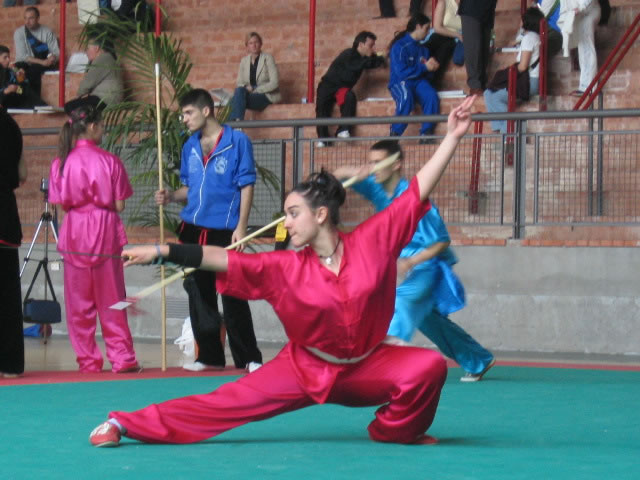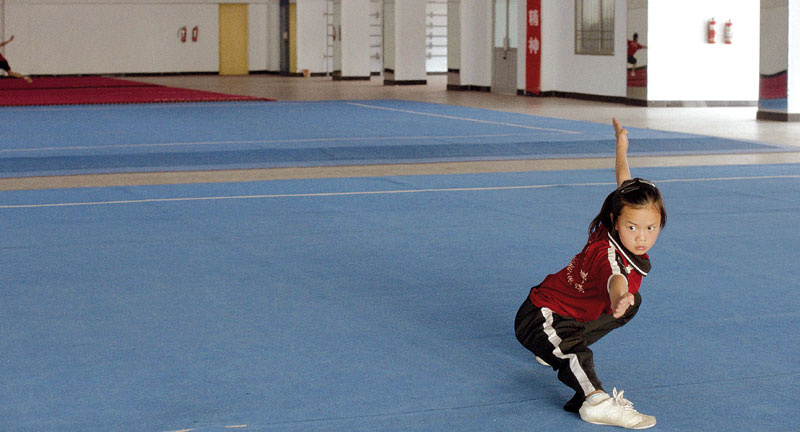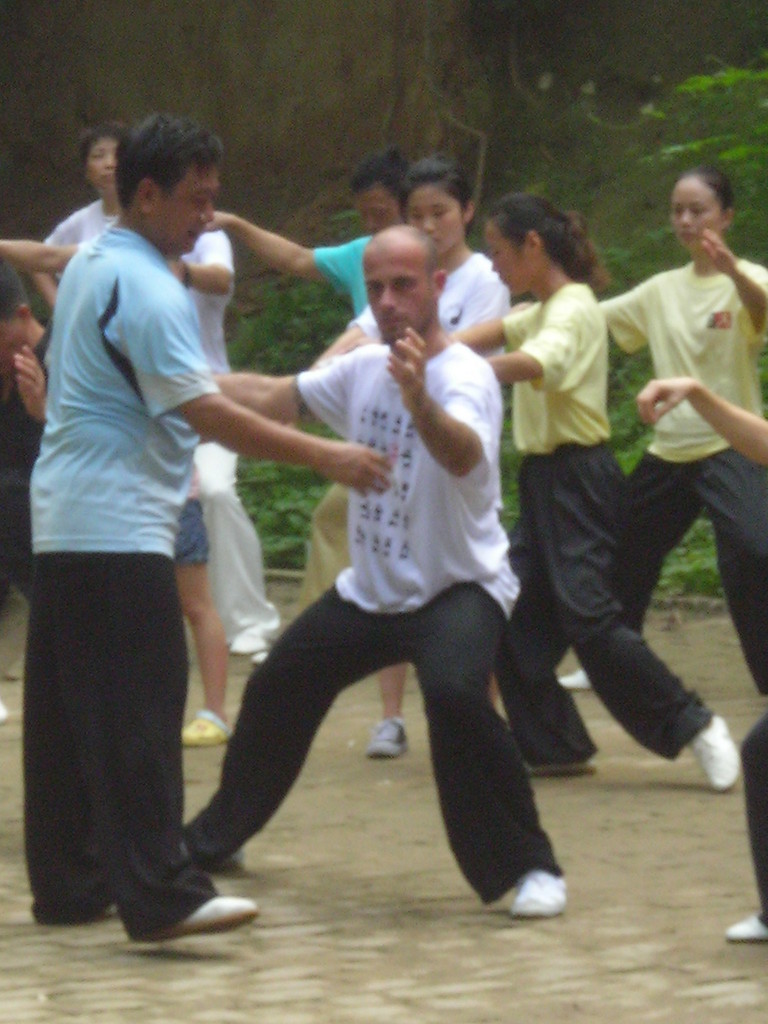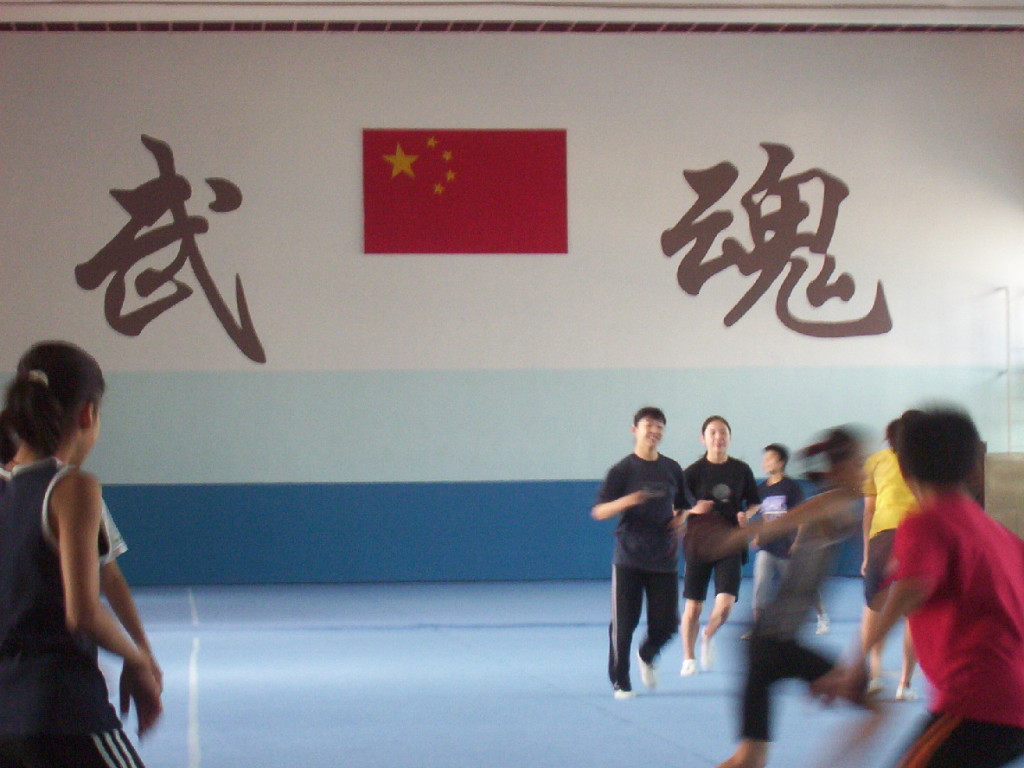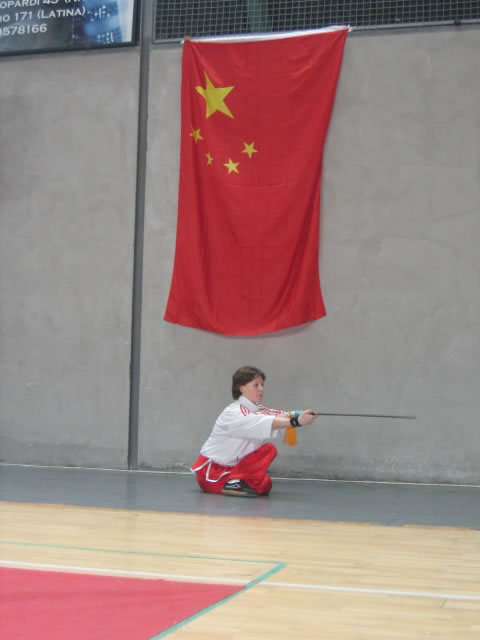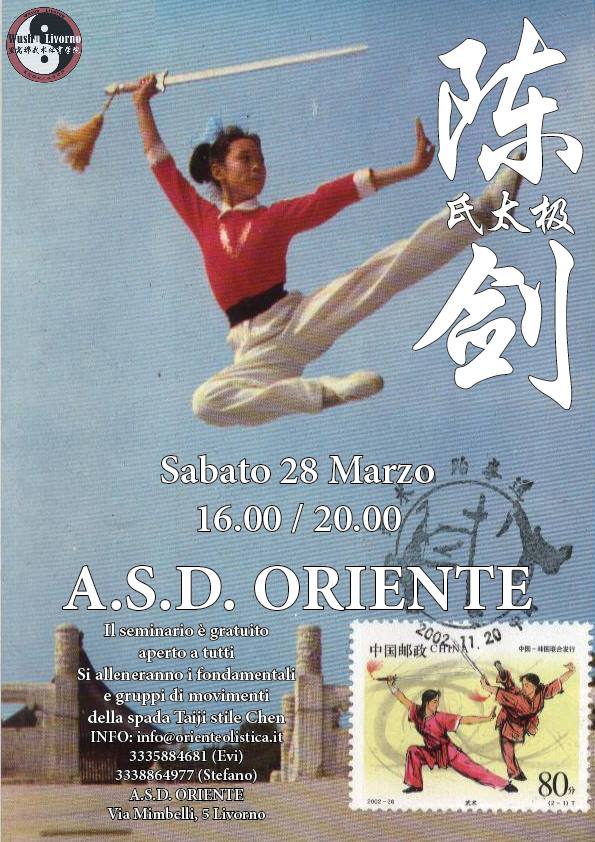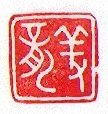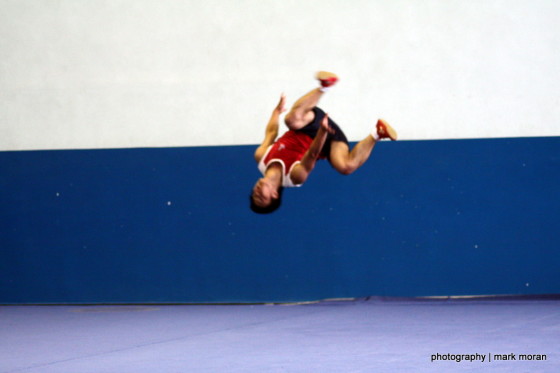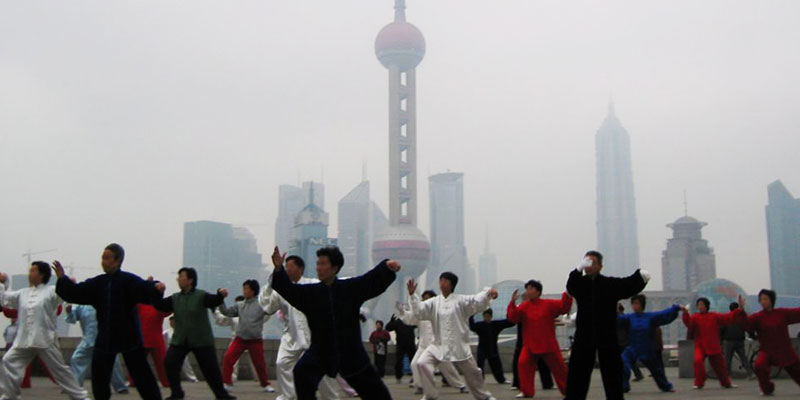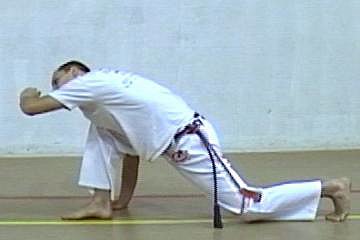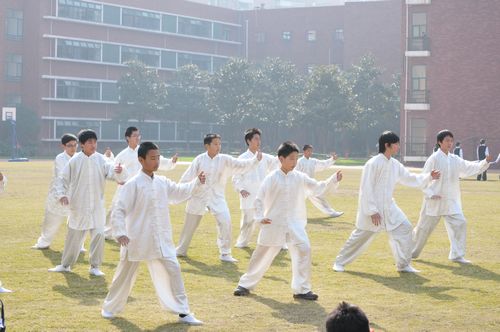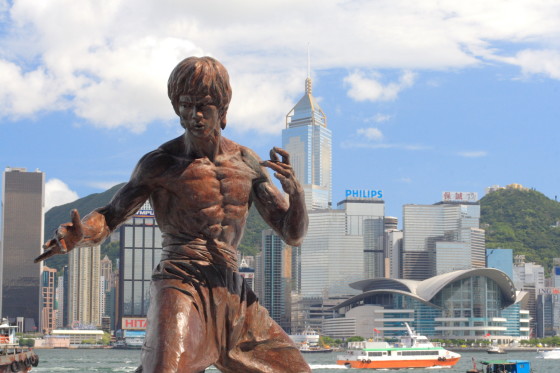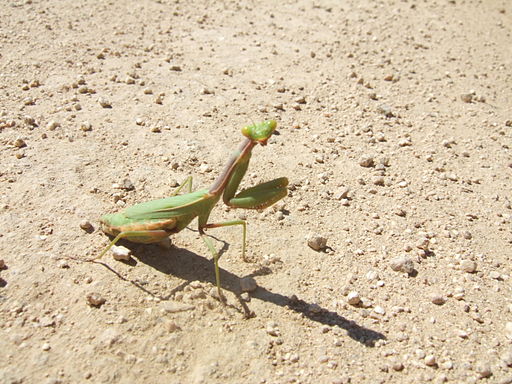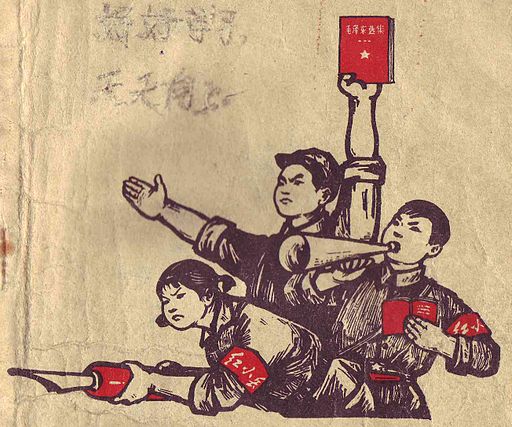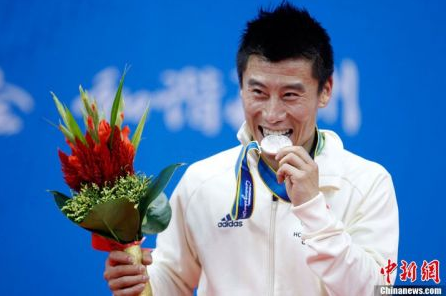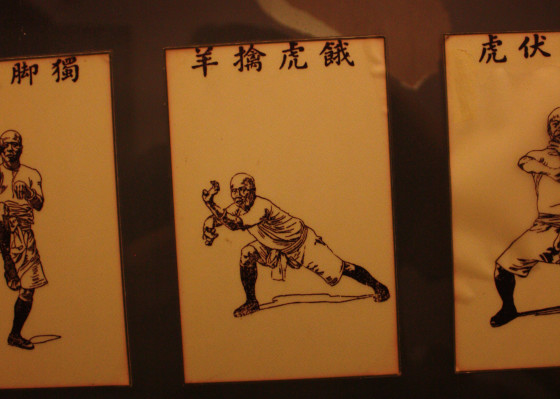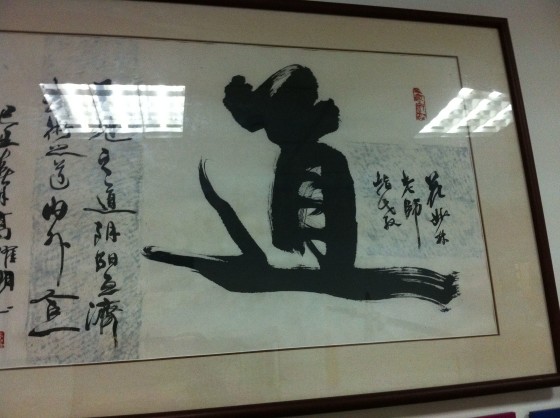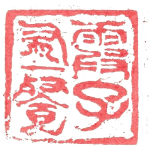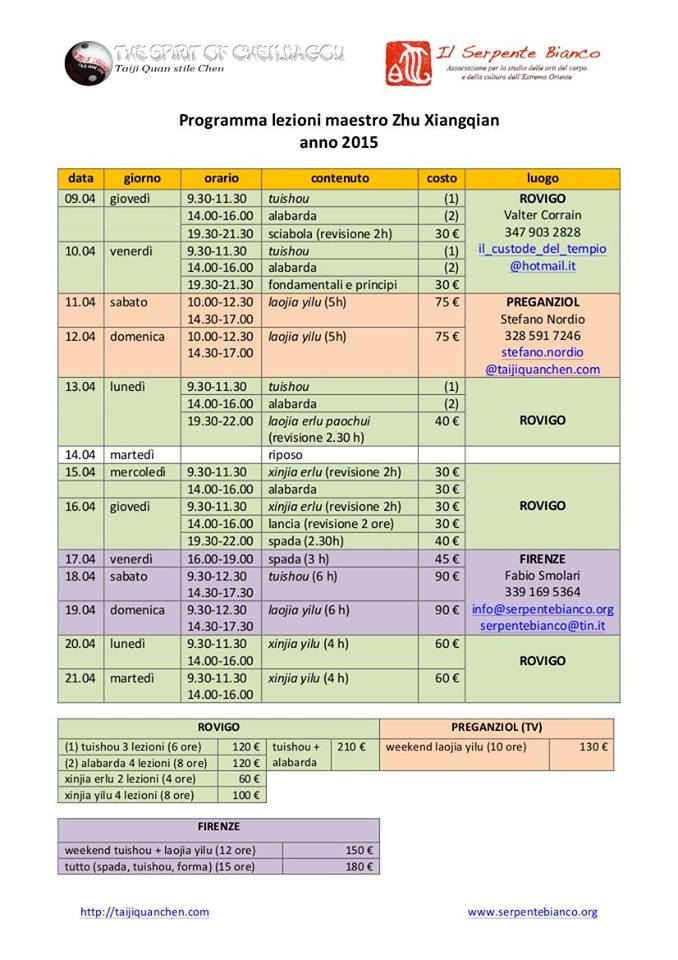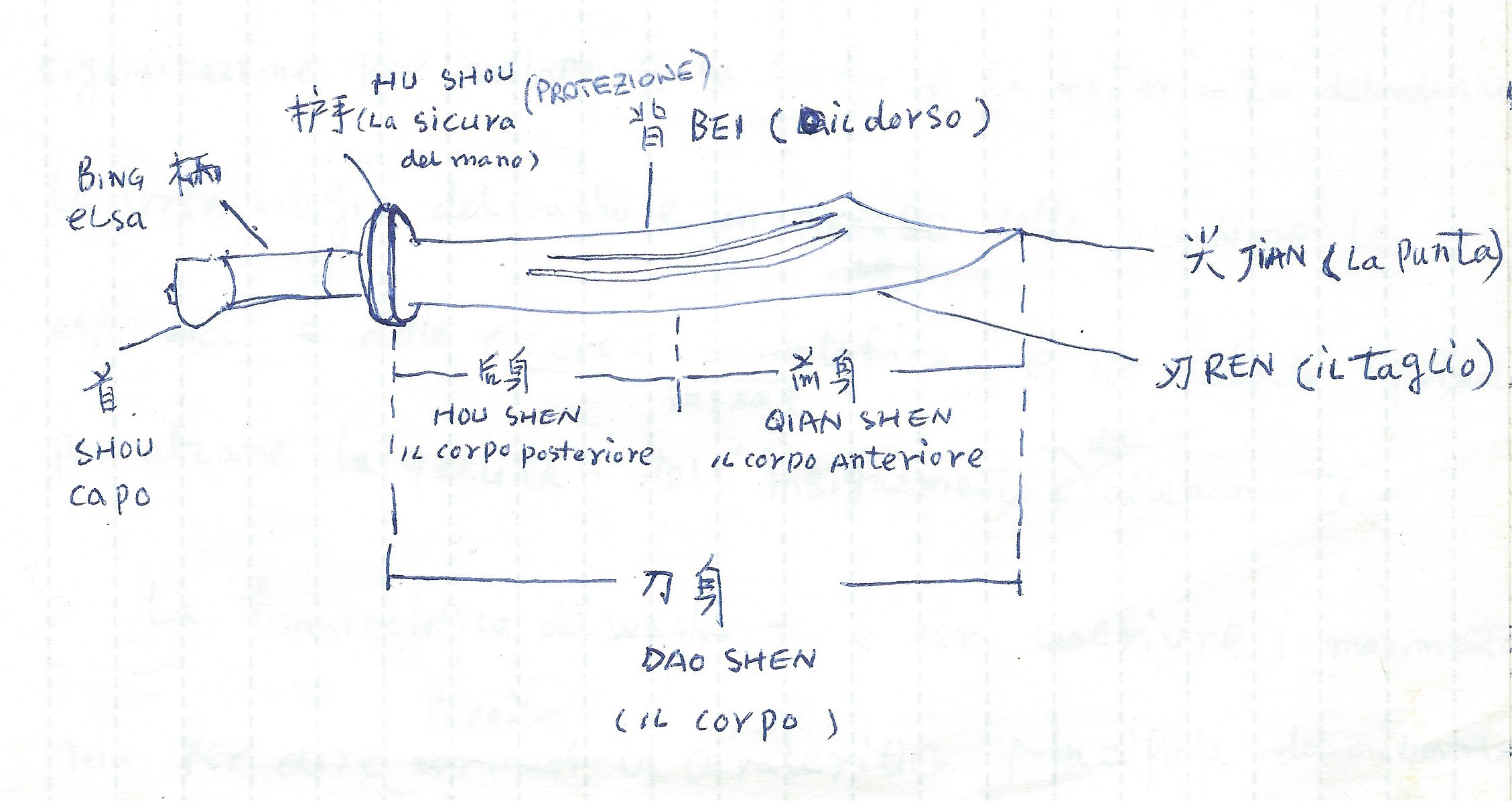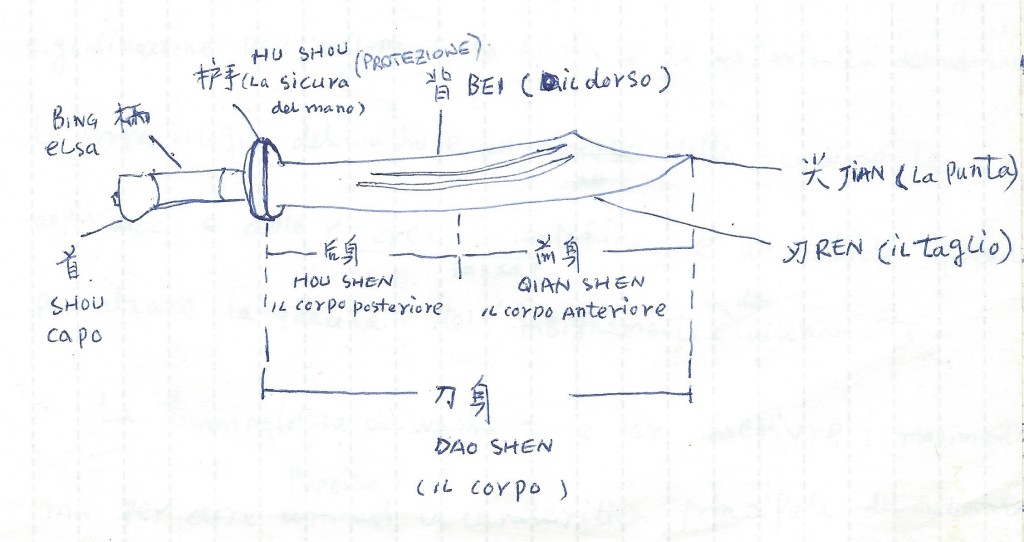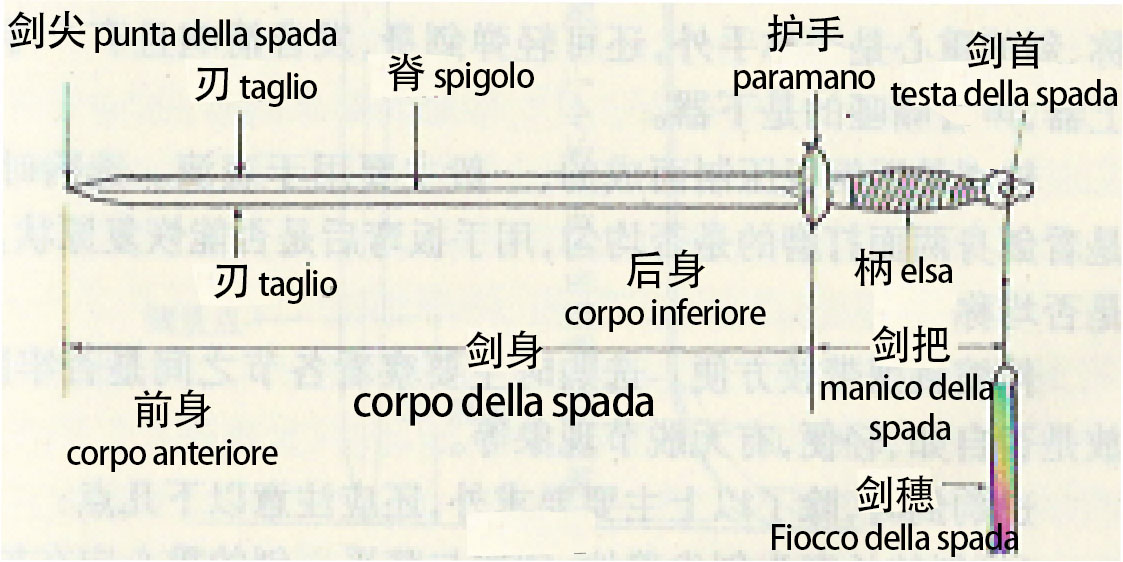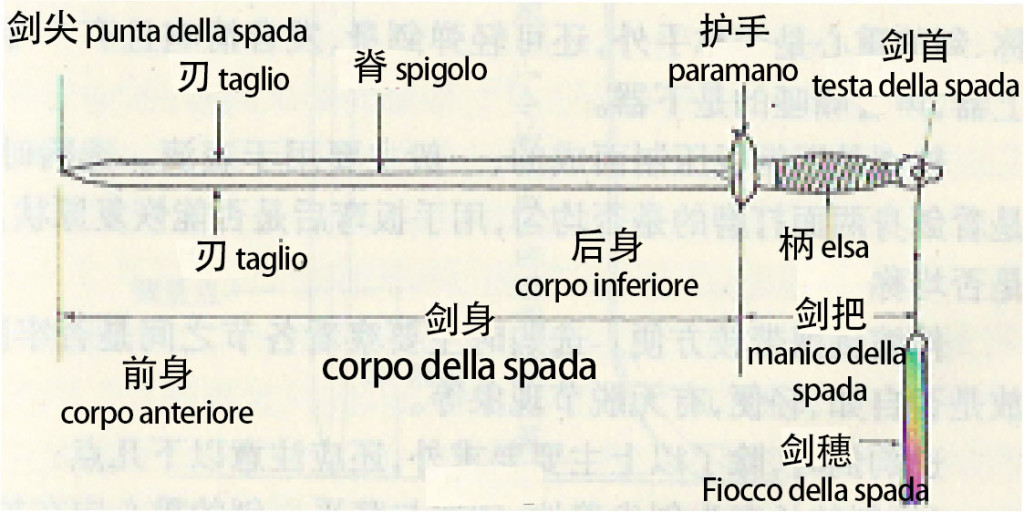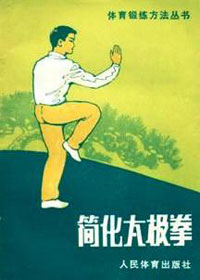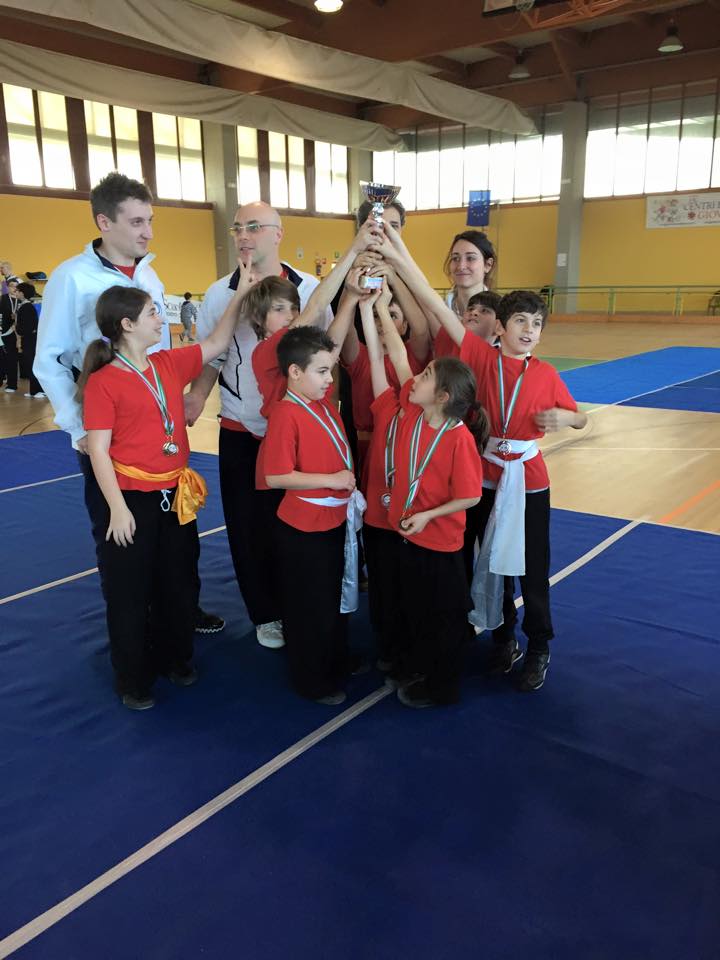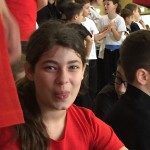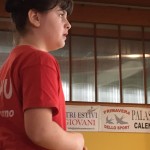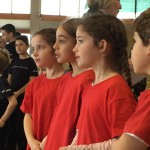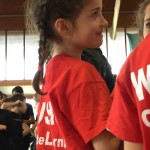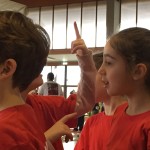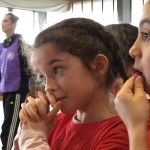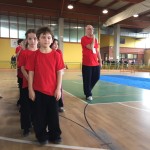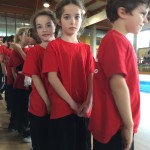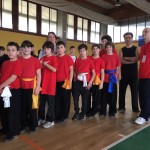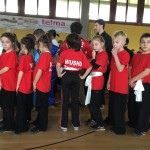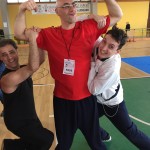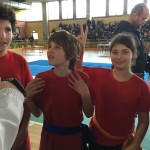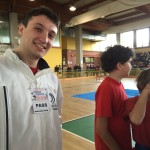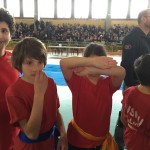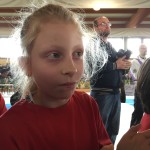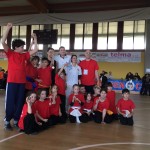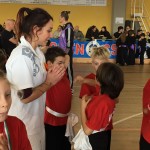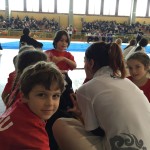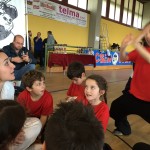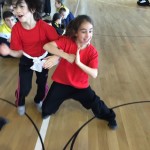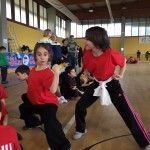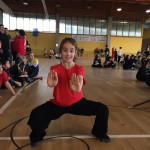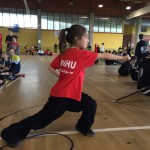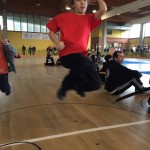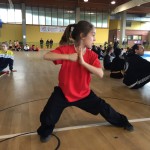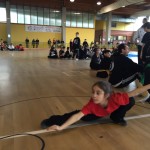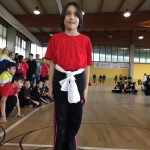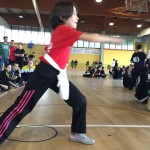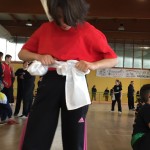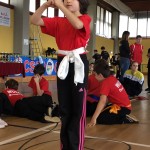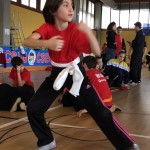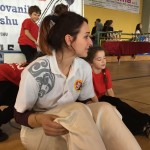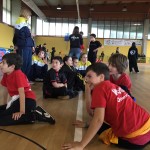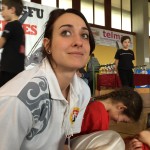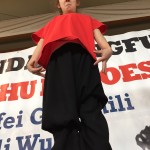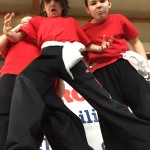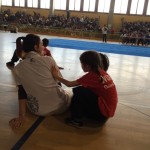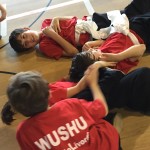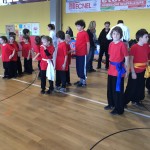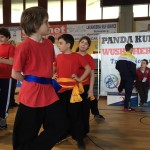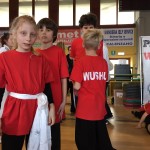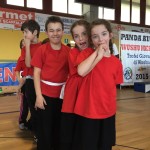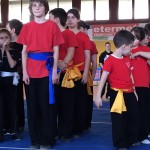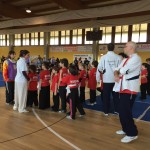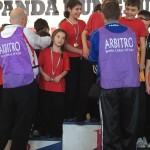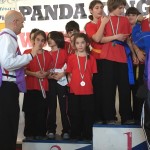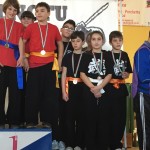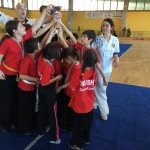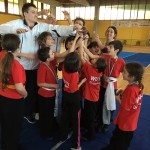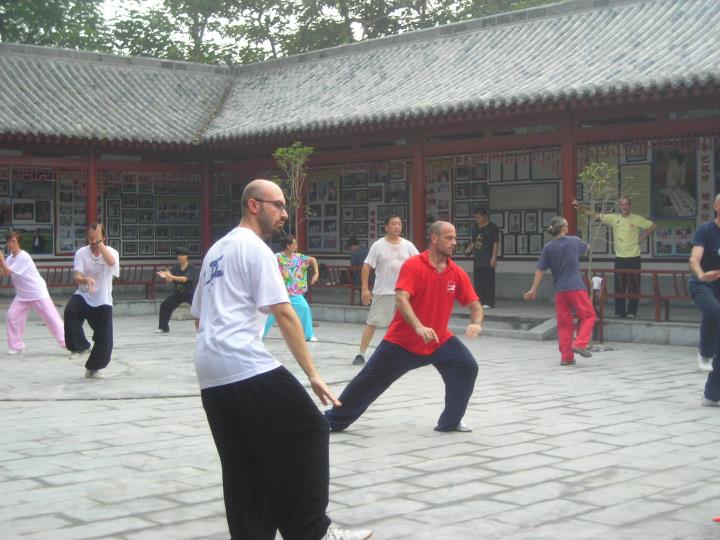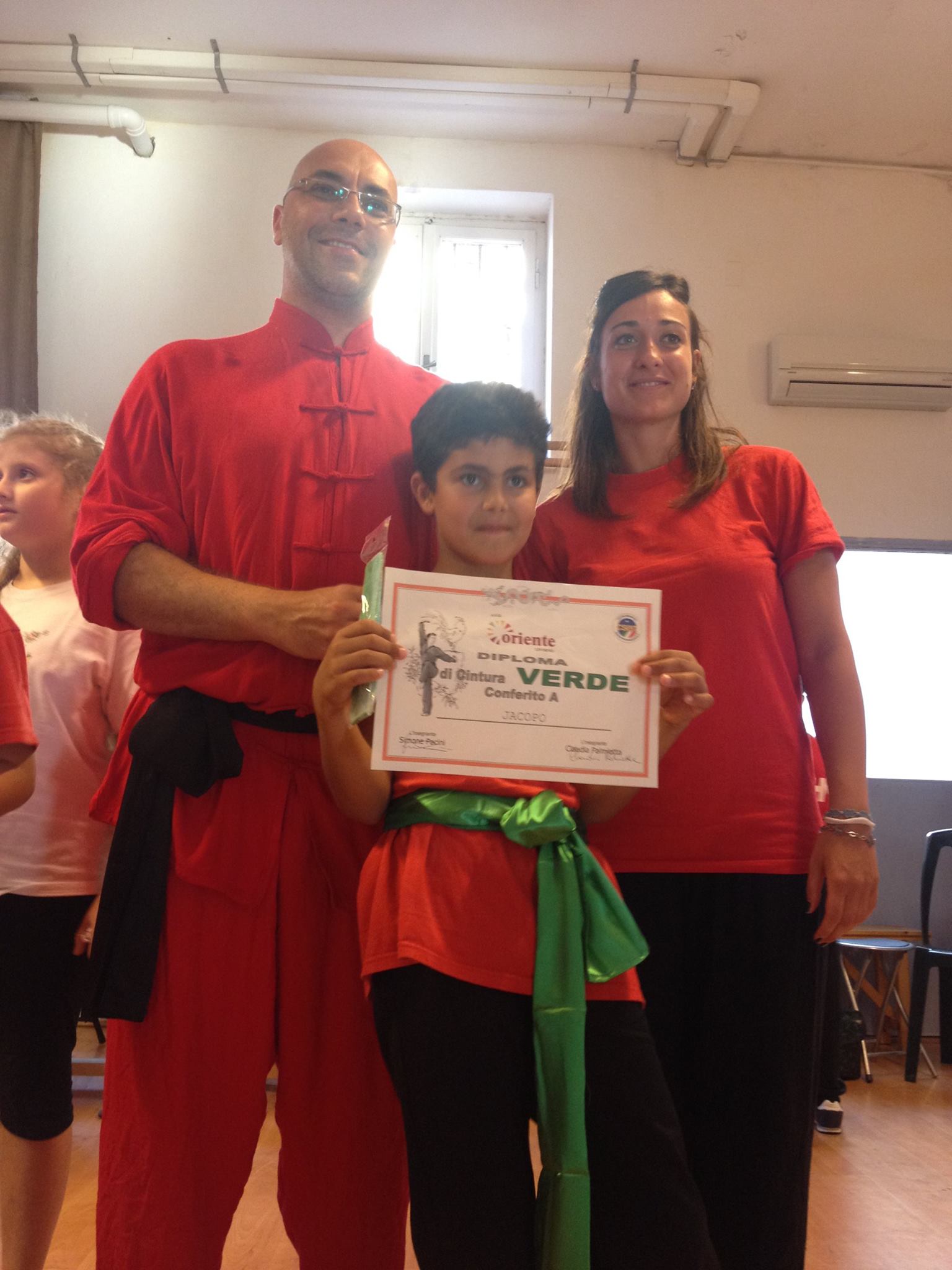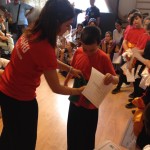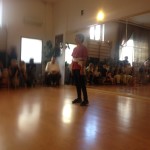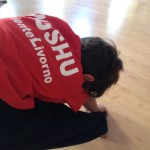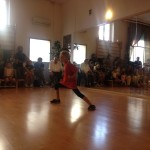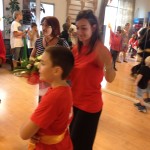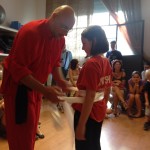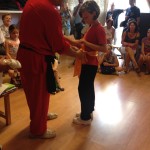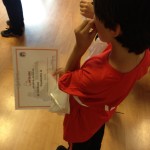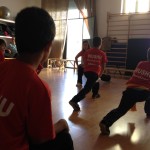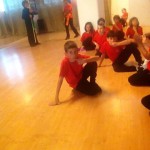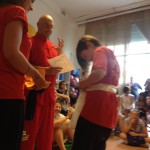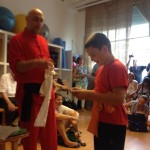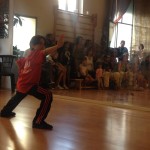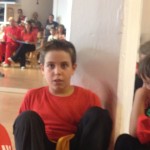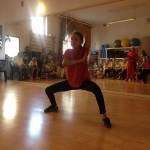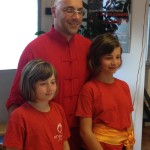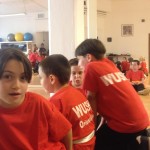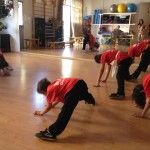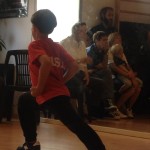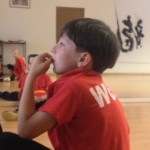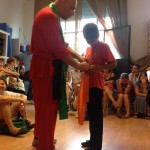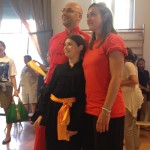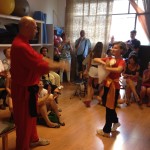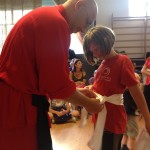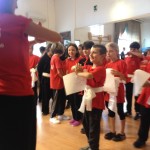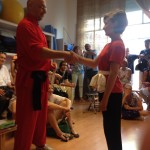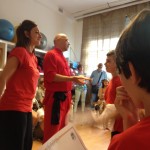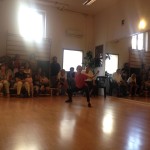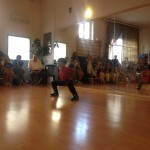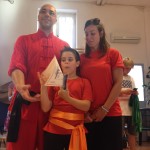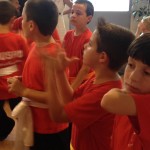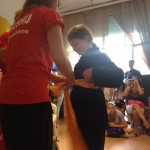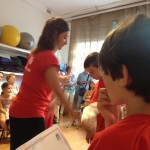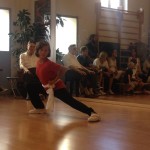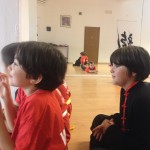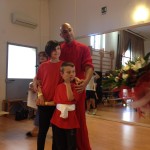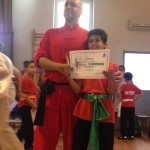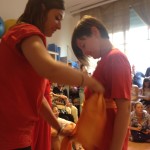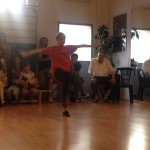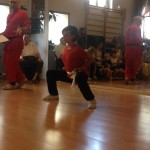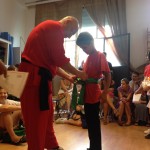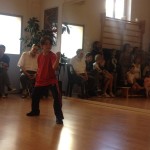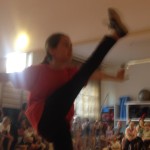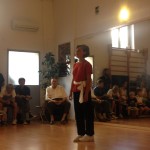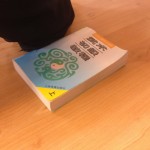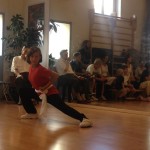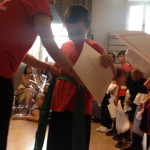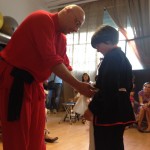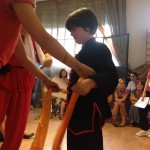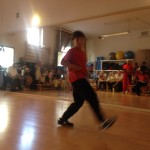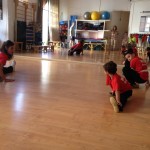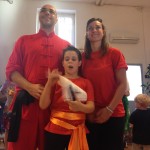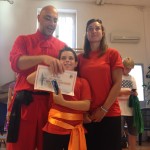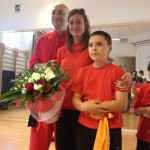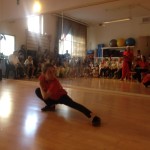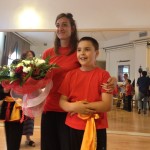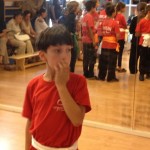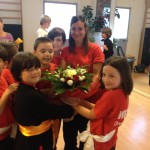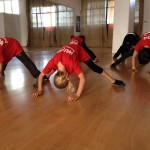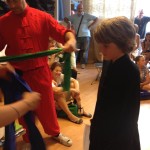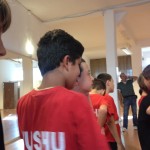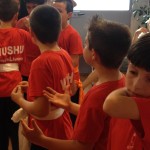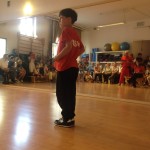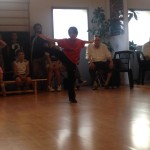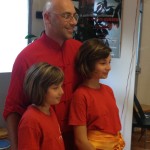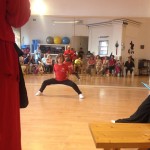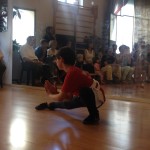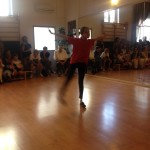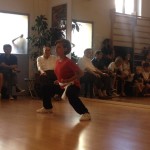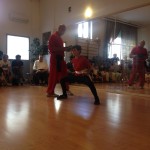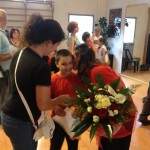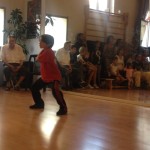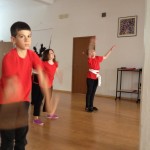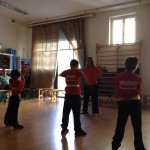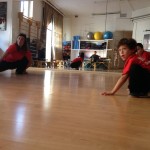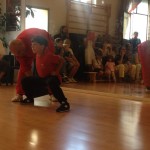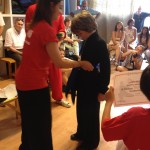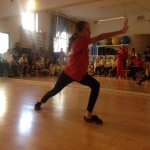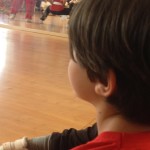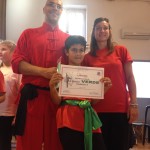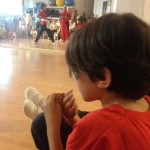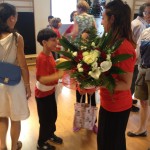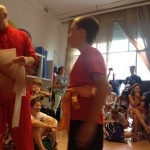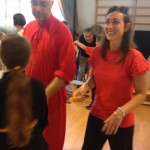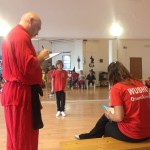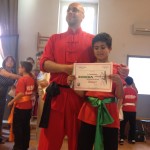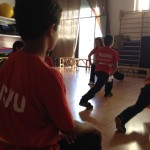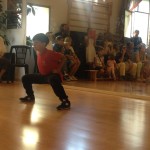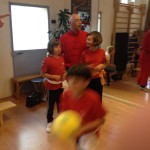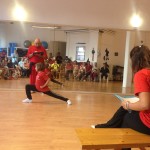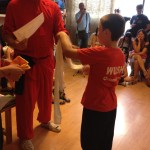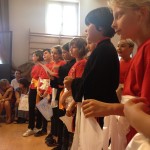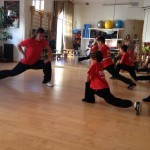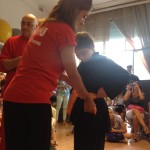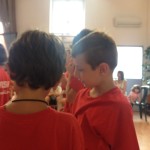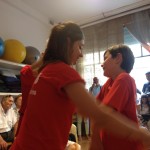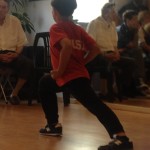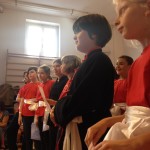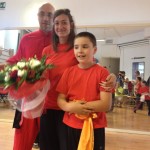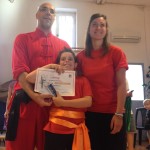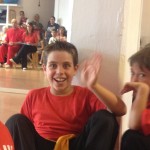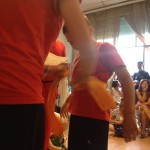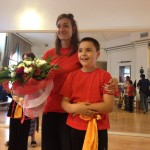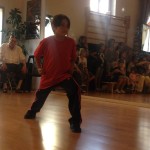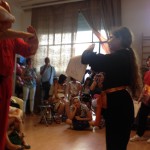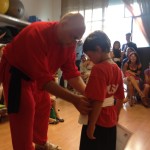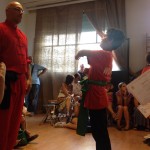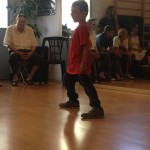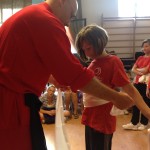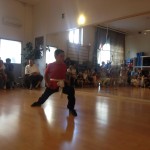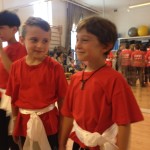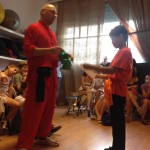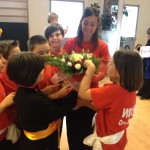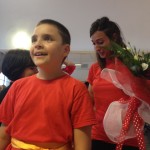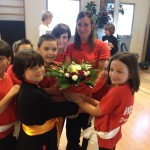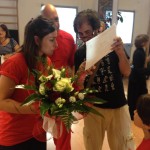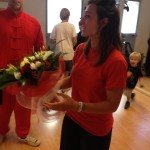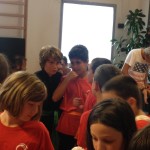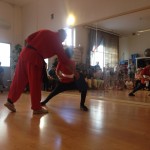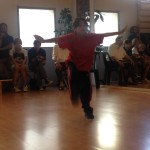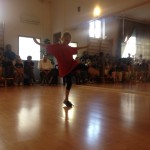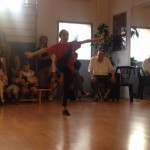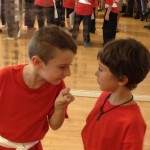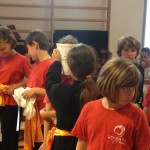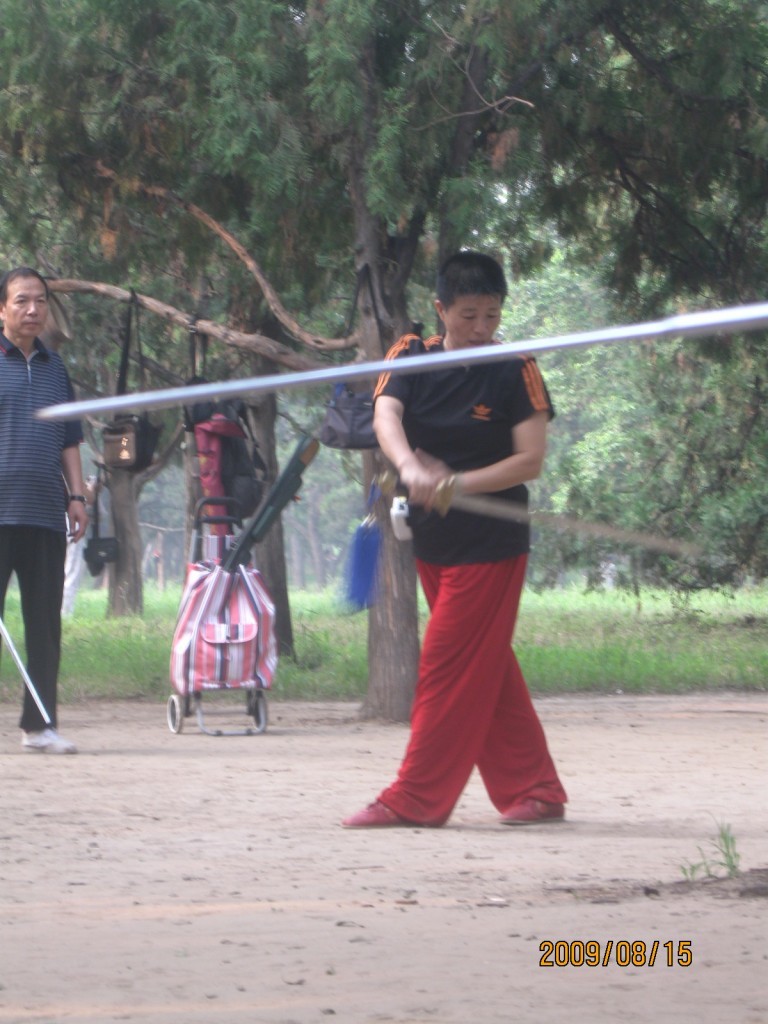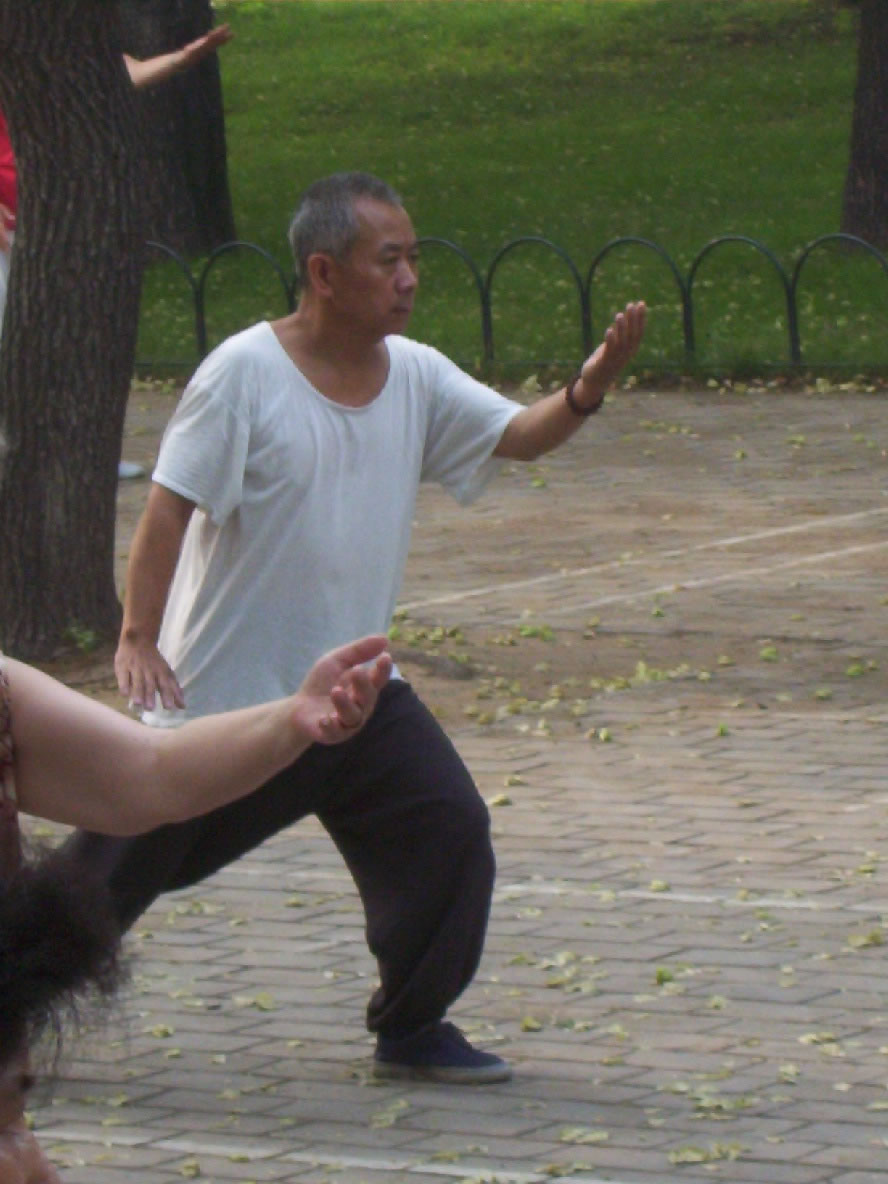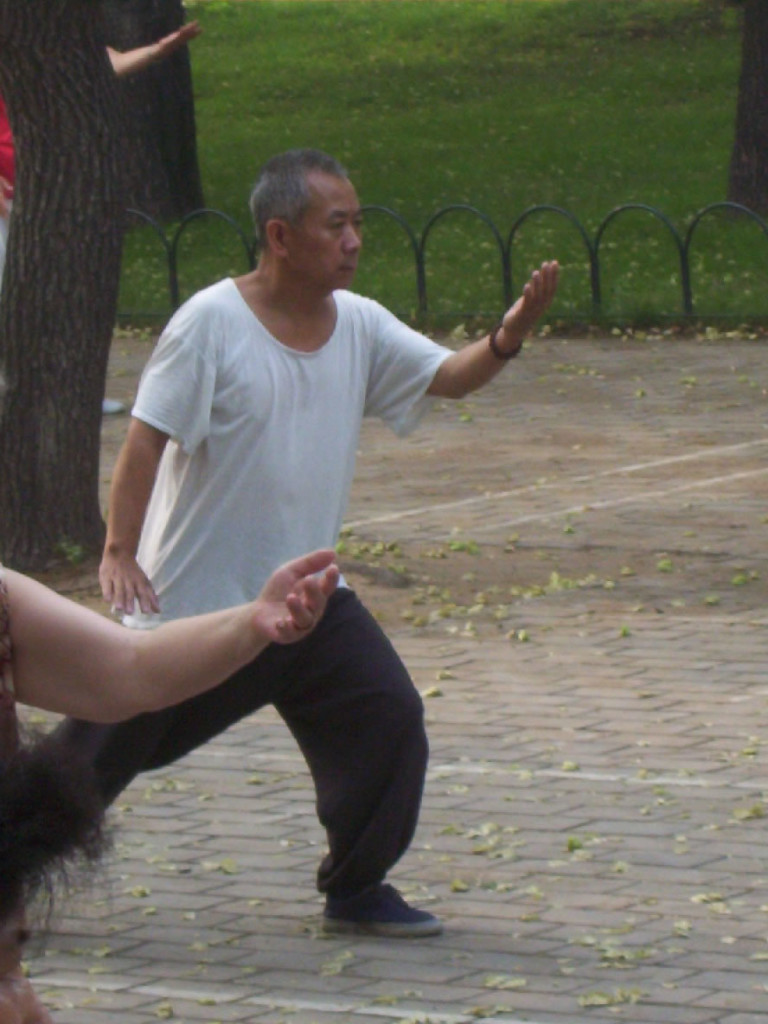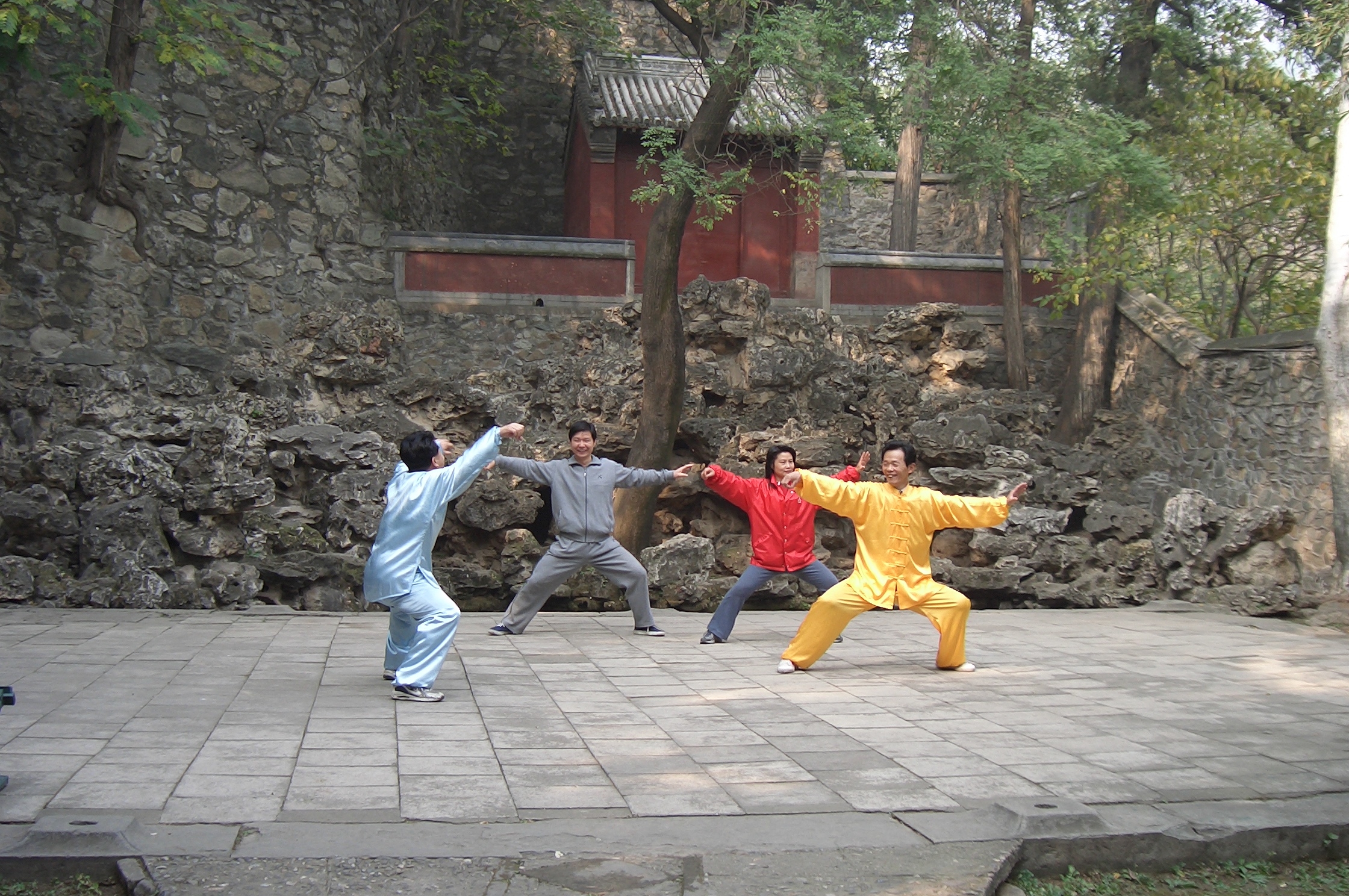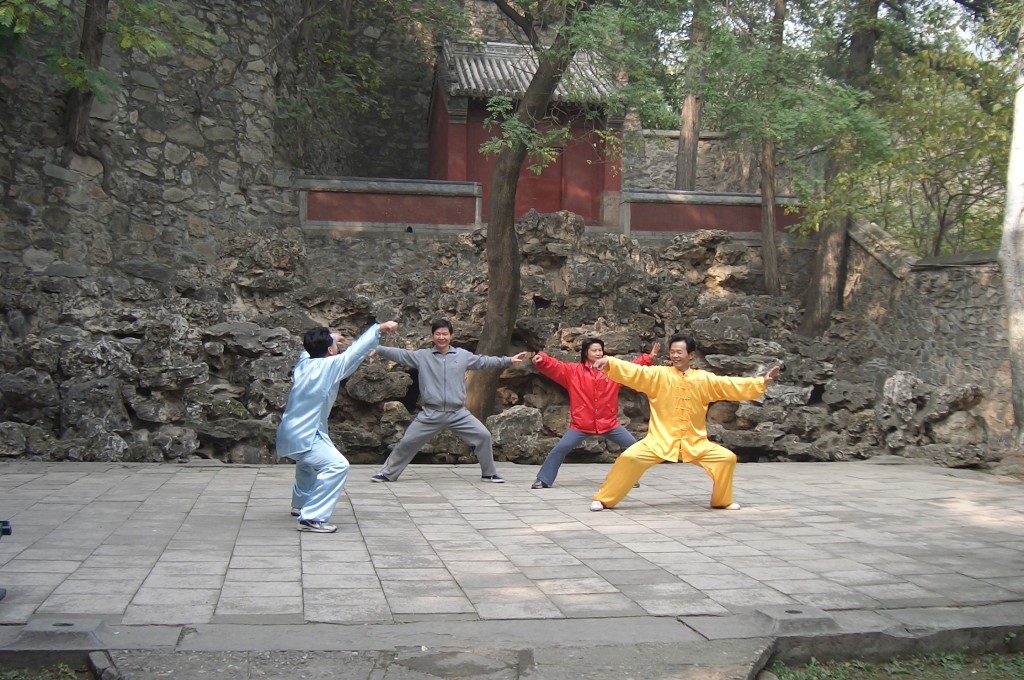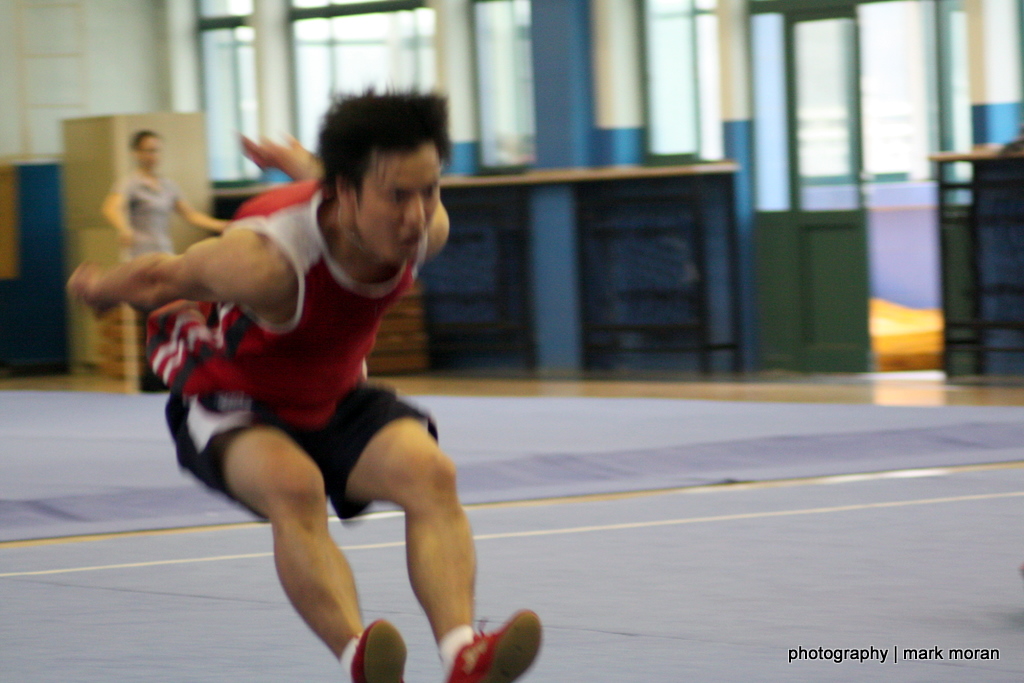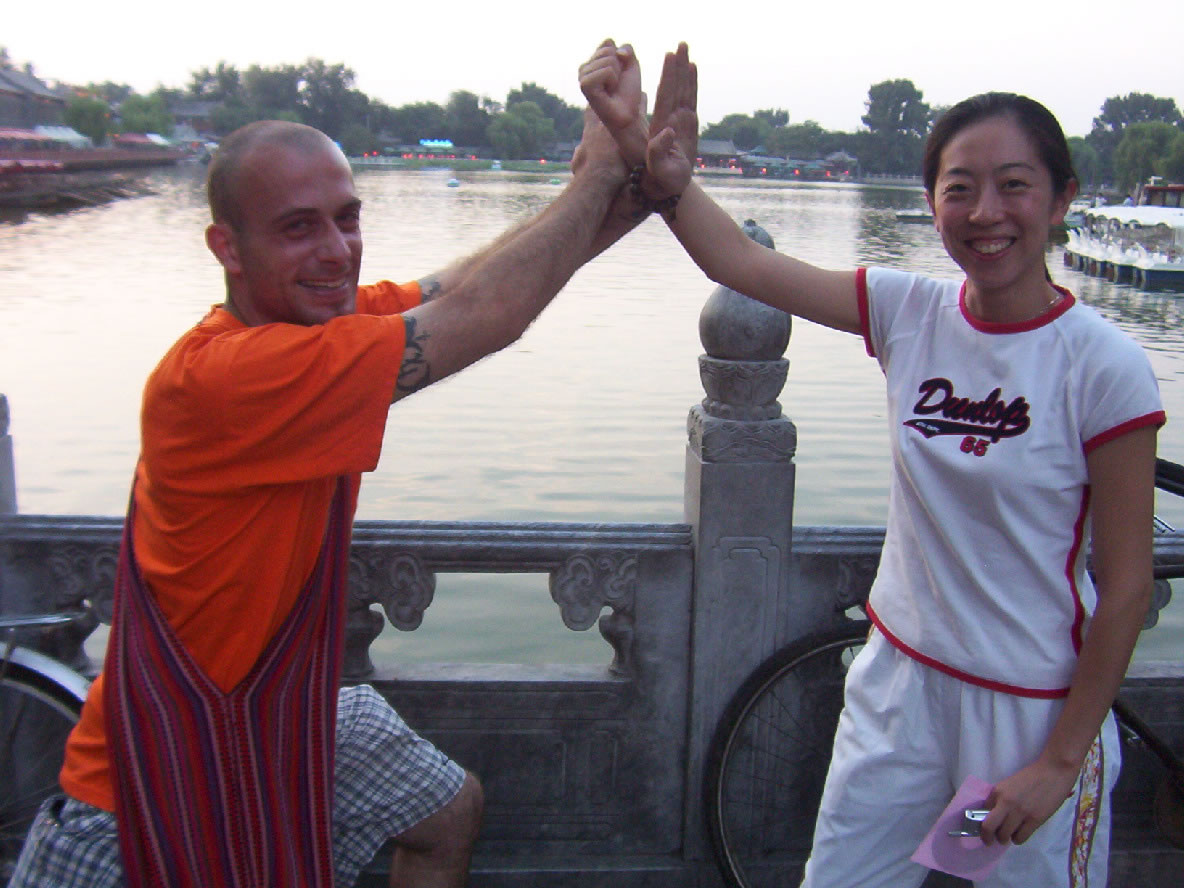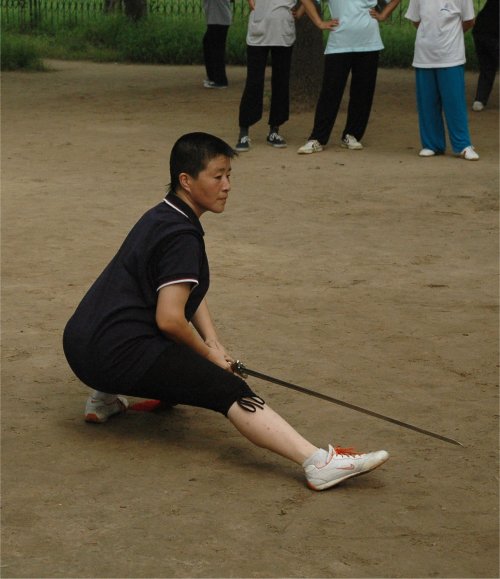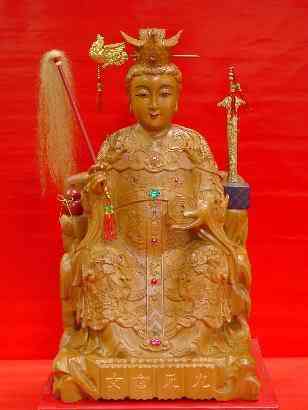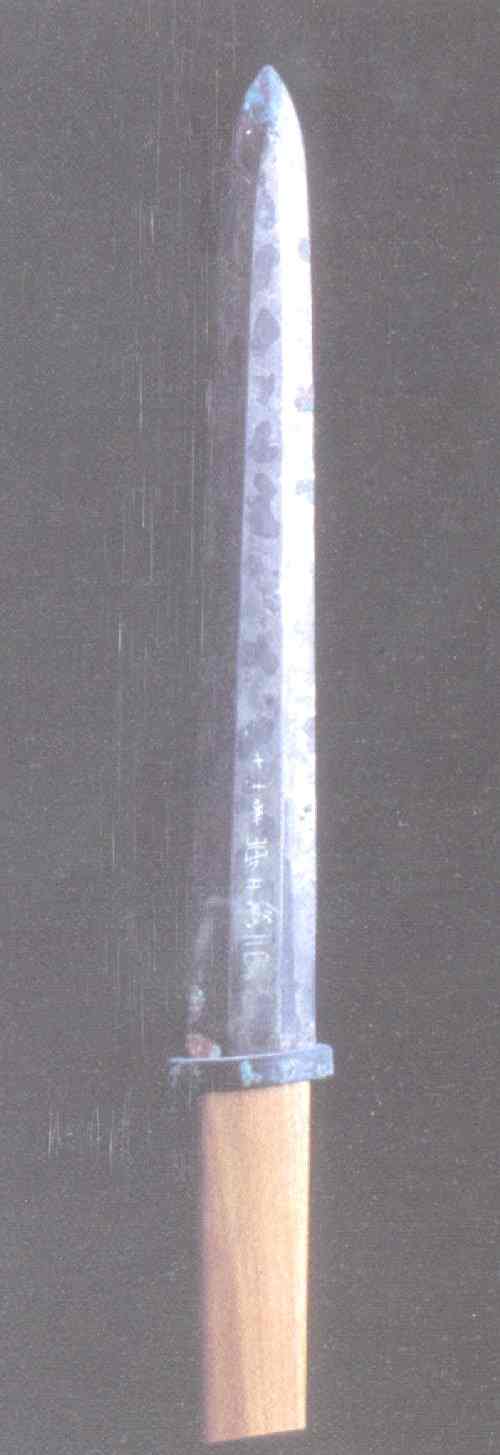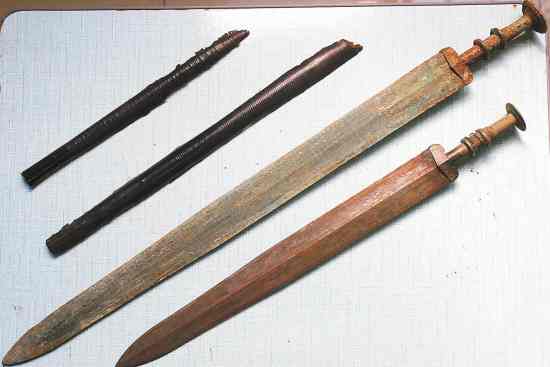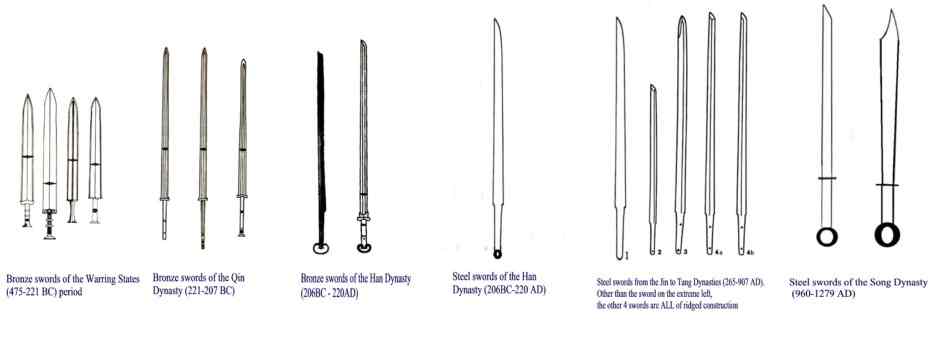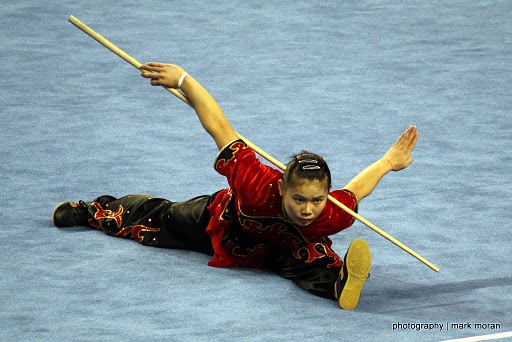–
太極拳使用法
METHODS OF APPLYING TAIJI BOXING
楊澄甫
by Yang Chengfu
[and 董英傑 Dong Yingjie]
[published by 神州國光社發行 Society for Chinese National Glory, Jan, 1931]
[translation by Paul Brennan, Nov, 2011]
–
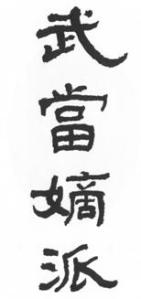
武當嫡派
“Descended from Wudang”
–

楊健侯先師遺像
Photograph of the late Yang Jianhou
–

著者楊澄甫
The author, Yang Chengfu
–

田兆麟
Tian Zhaolin
–

武滙川
Wu Huichuan
–
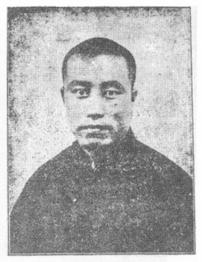
董英傑
Dong Yingjie
–

王旭東
Wang Xudong
–

閆仲魁
Yan Zhongkui
–

李得芳
Li Defang
–

楊振銘
Yang Zhenming
–

姜廷選
Jiang Tingxuan
–

褚桂亭
Chu Guiting
–

李椿年
Li Chunnian
–

徐岱山
Xu Daishan
–

郭蔭棠
Guo Yintang
–

張慶麟
Zhang Qinglin
–

楊開儒
Yang Kairu
–
張三峯先師傳拳譜
ZHANG SANFENG BOXING LINEAGE
三峯師傳山右王宗岳
Zhang Sanfeng imparted to Wang Zongyue of Shanxi.
河南─後又傳陳家溝陳長興 楊露禪 李百魁 及子姪輩
Wang taught in Henan province to Chen Changxing of Chen Family Village, who in turn taught Yang Luchan, Li Baikui, and his sons and nephews.
張松溪 王來咸 為浙江東支派惜已失傳
Wang also taught in Zhejiang province to Zhang Songxi and Wang Laixian, but this branch is extinct.
福魁露禪師傳
Yang Fukui (Luchan) taught:
鳳侯傳子……兆林字振遠
– Fenghou, who taught his son, Zhaolin (called Zhenyuan),
班侯傳……外姓數人
– Banhou, who taught many people outside his family,
健侯傳子……兆淸字澄甫
– Jianhou, who taught his son, Zhaoqing (called Chengfu),
傳……外姓數人
– and many people outside his family.
澄甫老師傳
Students of Yang Chengfu:
楊兆鵬
Yang Zhaopeng
武振海字滙川
Wu Zhenhai (called Huichuan) [photo above]
田兆麟
Tian Zhaolin [photo above]
董英傑
Dong Yingjie [photo above]
王旭東
Wang Xudong [photo above]
閻月川
Yan Yuechuan
牛鏡軒
Niu Jingxuan
田作林
Tian Zuolin
徐岱山
Xu Daishan [photo above]
褚桂亭
Chu Guiting [photo above]
劉論山
Liu Lunshan
李得芳
Li Defang [photo above]
李春年
Li Chunnian [photo above]
陳微明
Chen Weiming
楊鳳岐
Yang Fengqi
張欽霖
Zhang Qinlin
鄭佐平
Zheng Zuoping
王其和
Wang Qihe
崔立志
Cui Lizhi
王鏡淸
Wang Jingqing
楊振聲
Yang Zhensheng
楊振銘
Yang Zhenming [photo above]
楊振基
Yang Zhenji
姜廷選
Jiang Tingxuan [photo above]
陳光愷
Chen Guangkai
張慶麟
Zhang Qinglin [photo above]
王保還
Wang Baohuan
形玉臣
Xing Yuchen
劉盡臣
Liu Jinchen
匡克明
Kuang Keming
楊鴻志
Yang Hongzhi
師孫楊開儒
(having learned first from one of Yang’s students [Tian Zhaolin]) Yang Kairu [photo above]
于化行
Yu Huaxing
女士濮玉與第二人
(woman) Pu Yu (along with the second woman below)
女士滕南璇
(woman) Teng Nanxuan
奚誠甫
Xi Chengfu
朱紉芝
Zhu Renzhi
郭陰棠
Guo Yintang [photo above]
師孫吳萬琳
(having learned first from one of Yang’s students) Wu Wanlin
師孫孫件英
(having learned first from one of Yang’s students) Sun Jianying
李萬程
Li Wancheng
張種交
Zhang Zhongjiao
[Odd that Yan Zhongkui is absent from this list even though he is one of the photographed.]
田兆麟傳─
Students of Tian Zhaolin:
葉大密
Ye Dami
張景淇
Zhang Jingqi
陳一虎
Chen Yihu
施承志
Shi Chengzhi
陳志進
Chen Zhijin
鄭佐平
Zheng Zuoping [also in Yang Chengfu’s list]
楊開儒
Yang Kairu [also in Yang Chengfu’s list]
錢西樵
Qian Xiqiao
陳志遠
Chen Zhiyuan
張强
Zhang Qiang
何瑞明
He Ruiming
沈爾喬
Shen Erqiao
何士鑣
He Shibiao
周學淵
Zhou Xueyuan
周學芬
Zhou Xuefen
張寶鳳
Zhang Baofeng
崇壽永
Chong Shouyong
董英傑傳─
Students of Dong Yingjie:
劉同祿
Liu Tonglu
連忠恕
Lian Zhongshu
張忻
Zhang Xin
陳寧
Chen Ning
顏福廷
Yan Futing
郝奇
Hao Qi
宗之鴻
Zong Zhihong
宗毛三
Zong Maosan
孫僧齡
Sun Sengling
–
太極圖
DIAGRAM OF THE GRAND POLARITY [TAI JI]
 陰 陽
陰 陽
THE PASSIVE [YIN] / THE ACTIVE [YANG]
太極圖之義陰陽相生剛柔相濟千變萬化太極拳即由此而出也推手即太極之圖形
The idea within the Taiji diagram is that passive and active generate each other, hardness and softness assist each other, and the polarities endless transform into each other. Taiji Boxing comes from this, and the pushing hands is the manifestation of this symbol.
–
太極拳原序
ON THE ORIGIN OF TAIJI BOXING
太極拳傳自張眞人,眞人,遼東懿州人,道號三峯,生宋末,身高七尺,鶴骨松姿,面如古月,慈眉善目,修髯如戟,頂作一髻寒暑唯一箬笠,手持佛塵,日行千里,洪武初,至蜀太和山修煉結庵玉虛宮,經書一覽成誦,洪武二十七年,又入湖北武當山,與鄕人論經書談說不倦,一日在屋誦經,有喜雀在院,其鳴如箏,眞人由窗視之,雀在柏樹,如鷹下觀,地上有一長蛇蟠結,仰視,二物相爭,雀鳴聲飛下展翅扇打,長蛇搖首微閃,躱過雀翅,雀自下隨飛樹上,少時性燥,又飛下翅打,長蛇又蜿蜒輕身閃過,仍作盤形,如是多次並未打着,後眞人出,雀飛蛇走,眞人由此而悟,蟠如太極,以柔克剛之理,由按太極變化而組成太極拳,養精氣神,動靜消長,通於易理,故傳之久遠,而功效愈著,北京白雲觀現存有眞人聖像可供瞻仰云。
Taiji Boxing was passed down from the Daoist saint, Zhang. He was from Yizhou in Liaodong. The monastic name he was given was Sanfeng. He was born during the end of the Song Dynasty [ending in 1279]. Standing seven feet tall, he had a crane’s build and a pine’s bearing. His face was like the aged moon, with kindness in his eyes and brows. His beard was as long as a halberd and his hair was in a bun atop his head. Regardless of winter or summer he wore the same wide hat of bamboo. He held a Buddhist duster and walked immense distances in a single day.
At the beginning of Emperor Hongwu’s reign [1368], Zhang went to Mt. Grand Harmony in Sichuan to practice asceticism, joining the Temple of Jade Emptiness monastery, and recited the scriptures after just one reading. In the twenty-seventh year of Hongwu’s reign [1394], Zhang traveled again, going to Mt. Wudang in Hubei, and he tirelessly conversed with the villagers about the scriptures.
One day, while reciting passages in his room, an excited sparrow appeared in the courtyard. Because of its zither-like chirping, the saint looked out his window to watch it. The sparrow was in a cypress tree, gazing down eagle-eyed, while on the ground there was a snake coiling and weaving, looking up at the sparrow. The two animals were fighting. The sparrow cried out and flew down, spreading its wings to give flapping strikes. The snake waved its head to slightly dodge, avoiding the sparrow’s wings. The sparrow returned to the tree to express its annoyance for a while then flew down to try again. The snake again wriggled its nimble body to evade, remaining in its coiled shape. It went on like this many times without a strike. Then Zhang came out and the sparrow flew away and the snake slithered off.
The saint was illumined by this incident. The snake’s coiling was like the taiji symbol and used the principle of softness overcoming hardness. From the taiji’s transformations was devised Taiji Boxing. It cultivates essence, energy, and spirit. Movement and stillness wax and wane as in the theory of the Book of Changes. This is the way it comes down to us from long ago and its effectiveness is increasingly proven. In Beijing’s White Cloud Temple there is still an image of the saint which can be reverenced.
–
楊露禪先師軼事
AN ANECDOTE ABOUT YANG LUCHAN
初師在京師聲聞遐邇,俠來訪者踵接,一日靜坐間,忽有僧來,師自迎出階,見僧貌偉壯,身高六尺許,拱揖道慕意,師亟遜答,僧鶻起出拳直撲師,師略含胸,以右掌抵拳頂拍之,僧如受電擊,跌出屛後猶作拳擊狀,久之乃歛容稱謝曰,僧鹵莽,師仍邀與談,審其名為淸德僧,固少林健壯者也,僧縷縷問,頃出不意猶不得逞何也,師曰,是謂刻刻留心也,曰頃出何其疾也,曰,是謂發勁如放箭也,曰僧雲遊幾省,未有如師者,堅叩太極輕靈之奧,師不答,見有飛燕入簾,低繞近身,即起手速抄之,顧謂僧曰,此鳥馴就人,聊與為戲何如,輒承以右掌而左手撫之,旋縱使去,燕振翼擬起,師微將掌忽隱忽現,燕不能飛去,蓋無論何種雀鳥,必先足蹬勁才能飛,燕足無着力處,遞撲伏,則又撫之使去,復不得起,如是者三,僧大訝曰技何神也,師笑曰,奚足言神,太極行功稍久,通體輕靈一羽不能加,蠅蟲不能落,畧如是狀耳,僧拜服,留談三日乃去。
When Yang was in Beijing, he was heard of everywhere. Fighters crowded upon each other to visit him. One day, in the midst of seated meditation, suddenly a Buddhist monk arrived. Yang personally went to receive him at the stairs. He saw that the monk’s appearance was imposing and strong and that his height was about six feet. When the monk saluted and spoke his esteem, Yang immediately became humble in response. Then the monk suddenly launched out a punch. Yang slightly hollowed his chest and used his right palm to slap the top of the incoming fist. The monk seemed to receive an electric shock and fell away behind a screen while still in the posture of punching. After a while, with a sober expression on his face, he thanked Yang and said, “That was very rude of me.” Yang invited him in anyway and they chatted. He found out that he was called the Pure Integrity Monk and that he was indeed a tough exponent of Shaolin. The monk asked him questions one after another, such as:
“Just now when I attacked you, I took you by surprise, so why was I still unable to succeed?”
Yang said, “This is called ‘paying attention at every moment’.”
“When I attacked you, how is it that you were you so fast?”
Yang said, “This is called ‘issuing power like loosing an arrow’.”
“I have traveled to many provinces but have met no one the likes of you. I sincerely ask the secret to Taiji’s nimbleness and quickness.”
Yang said nothing, seeing a swallow fly through his curtain and then lower in an arc nearby him. He promptly lifted his hand and scooped it up, then looked over at the monk and said, “This bird is tame and unafraid of people, so why not have some fun with it?”
The way he did this was to put it in his right palm while petting it with his left, then took away his left hand to let it fly away, and the swallow flapped its wings and tried to take off, but he was slightly moving his palm to be one moment there and the next moment not, and so the swallow could not fly away. Every kind of bird must first push with its feet to be able to get into the air, but the swallow had nothing to push against. It gave up, so Yang returned to petting it, then gave it another chance, but again it could not get into the air.
After a third round, the monk was astounded and said, “This skill is magical.”
Yang smiled and said, “What’s so magical about it? Practice Taiji for a long time and the whole body will become so nimble and quick that a feather cannot be added and a fly cannot land. That basically sums it up.”
The monk bowed in admiration and continued to converse with Yang for three more days before finally leaving.
–
序
PREFACE [BY DONG YINGJIE]
余幼讀書時,性好武,余祖有老友劉瀛州少林壯者,北方名素著,余求學,劉師曰我年近七十,無能為也,如願學,有廣平楊姓得武當秘傳,惜我年老知之晚矣,僅知皮毛,與介紹楊傳,拜師求學焉,研究十有五年,惜余最魯,略知大槪,諸師兄師弟皆出我上,余今從師歷方從學,遊歷保定,北平,天津,上海,南京,蘇杭,江西,山東,曾見廣東,雲南,陝西,山西,河南,安徽,湖北,湖南,各省武術大家,各處山川古蹟,觀之不已,各省內外武術大家,令人學之不盡,勸同志苦心研究無懈志也,今余始知武術深有奧妙,正在從學研究中,今國家提倡武術,幸吾師又作是書,任縣董英傑喜而為之序。
When I was young and in school, I was interested in martial arts. My grandfather had an old friend, Liu Yingzhou, who was good at Shaolin and was in the north and well known. I went to learn from him, but he told me: “As I am almost seventy, I am not capable. If you want to learn, the Yang family in Guangping have obtained the secret Wudang transmission. Unfortunately in my age I have known it too late and I only understand it superficially, but I recommend the Yang transmission. Go seek to learn from them. I studied for fifteen years, but alas, I am really stupid and I only know the general idea. All of my fellow students, whether elders or juniors, did better than me.”
By now I have learned from teachers everywhere. I traveled to Baoding, Beijing, Tianjin, Shanghai, Nanjing, Suzhou & Hangzhou, Jiangxi, Shandong, visiting Guangdong, Yunnan, Shaanxi & Shanxi, Hebei, Anhui, Hubei & Hunan, to martial arts masters of each province, every place in the land where there are ancient traces of it, observing ceaselessly the masters of internal and external martial arts. It has made me learn without end. I urge my fellow practitioners to work hard and study without slackening in their devotion. Nowadays I am beginning to understand the deeper subtleties of martial arts, directly due to learning and studying. Now the nation is encouraging martial arts and it is a wonderful thing that my teacher has also produced this book.
– written with delight by Dong Yingjie of Ren county
勸諸同志莫懈心
日月穿梭貴如金
朝夕時時要習練
功夫無息得玄眞
I urge all my fellow practitioners not to be lazy.
Work at it day after day, month after month, for it is as valuable as gold.
From morning to eve you should constantly practice.
Work at it unceasingly and what you will obtain will be as precious as jade.
–
序
PREFACE [BY TIAN ZHAOLIN]
技術者,為我國國粹之至寶也,惜多年不振,幾于失傳,幸今國家提倡武術為必要,余踴躍為之序,今楊師南來,與同志互相研究,發展普及起見,余雀躍之至,因余為國民一份子,亦要加入提倡,惜才學最淺,總不免熱心耳,拳有外壯,內壯,余偏愛於內家太極,奥妙筆亦難言,尊師常談,輕則靈,靈則動,動則變,變則化,余苦功從學研究二十有年,不能得百分之一,雖然,余常懷有志竟成,每日在研究中也,田兆麟謹序。
These skills are the greatest treasure of our culture. It is a pity that for so many years they have not been encouraged and many of them have consequently been lost forever. Fortunately nowadays our nation is promoting martial arts as being indispensable, and so I enthusiastically write this preface. Yang Chengfu is now away visiting in the south so he and other practitioners can study with each other, and the growth and spread of these arts is beginning to be seen. I am overjoyed because I get to participate in this national undertaking and I would like to add my own encouragement. It is too bad I am no scholar, but at least I am certainly enthusiastic.
In boxing, there is an external strength and an internal strength. I am partial to the internal school’s Taiji, which has profound writings but is difficult to discuss. I revere this common saying of my teacher’s: “With lightness there is sensitivity, with sensitivity there is movement, with movement there is adaptation, and with adaptation there is transformation.” I have worked hard learning from him for twenty years but I have been unable to master even one percent of it. Although I firmly believe that with a will there is a way, and so I spend every day in the study of it.
– sincerely written by Tian Zhaolin
–
凡例
GENERAL REMARKS [Part 1]
一本書專就已經練習太極拳而尚未明實用者特按名式說明並附圖以表出之
– This volume is geared toward those who already practice Taiji Boxing but do not yet understand its practical functions. Especially pay attention to the explanations for the main postures and the photos which demonstrate them.
一本書下列太極拳應用交手圖式甲乙二人演練時宜就各圖姿勢循序彷行
– There is in this volume a scheme to the practical applications, meaning that when two people practice together, they should do them in sequence.
一本書逐段標明按各式銜接動作以至二人發手之際均用白話表明學者可詳細參閱自有路徑可尋
– Every posture is described step by step through the movements all the way to the point where the two people are expressing the techniques upon one another, which is always described in ordinary language, and students are thereby equipped with a detailed reference and have the means to seek the path.
一甲乙二人合手演習時可輕行緩進實地研習自有得法之處不可躁進率爾逞强以致發生危險彼此反生惡感
– When two people practice together, they can treat it as something frivolous and progress slowly or they can study seriously. When you have a moment of advantage, you must not be anxious to advance or eager to show off. If you do, it will become dangerous for you as you will both oppose each other with anger.
一本書均就單行法解釋之遇有手術相同者從畧
– Individual techniques will be explained only once and repetitions omitted.
一本書附圖應用動作各式方向均以上下前後左右两側表示之不拘定於東西南北以其臨時動作無有一定之方位故也
– The photos exhibit in various directions – up, down, forward, back, left right. Their orientations of north, south, east, west are kept constant because the direction of the movements is not.
一本書各姿勢應用法式僅就一二手術編列說明之其臨時動作變化之妙在好學者深思遠造久練功純自能得其要領非空言所能及也
– In the application models for each posture, only one or two techniques have been compiled. When their situations are explained, the subtlety lies in the movement transitions. To achieve it depends on the good student pondering deeply. With ardent practice over a long period you will naturally obtain the essentials. These are not empty words. It is a realizable goal.
一本書編製各式均用白話挨次淺顯說明以便閱者一目了解
– Each posture is explained in ordinary language so as to make it easy to understand.
一本書編成其中字句難免有遺漏錯誤之處望閱者諒之
– Inevitably there are omissions and errors in the text. When you come across them, forgive.
一此書是楊老師所述拳理同志閱書千萬不要以文字挑之祗應注重拳理如以文法挑之恐有誤自己學拳之門徑願同志諒之
– This book is Yang Chengfu’s transmission of boxing theory. But fellow practitioners who read through it should by no means take the writing too seriously. You should only lay importance on the theory. If you are finicky about the writing, you will likely make mistakes in your own study of the boxing methods. And so I hope you all will pardon the writing.
太極拳本係武當內功拳,欲鍜練身體者可習太極拳,此係柔功,無論男女老幼皆相宜,小兒六歲以上,老者六十歲以外,皆能習學,身體虛弱者更可習學,數月之間漸覺强壯耳,十三勢初學期三個月學會,一年習熟,五年練好,日後愈練愈精,但非眞傳不可,太極拳不得眞傳不過身體畧壯耳,拳理十年終糊塗,焉能知精微奧妙知覺運用,若得眞傳如法練去,金剛羅漢體不難矣,不但體壯,自衛防身之能力庽焉,早晨練拳最相宜,飯後休息半時或一時方可運動,如體質弱者量力練之,不可過,練習一月之後飲食可加多,拳每早晚两次或三次均可,如夏天練拳正燥,千萬不可用凉水洗手,恐其悶火,如冬天練完速穿衣服恐其受凉,練完不可即就坐,可行走五分鐘,使血脈調和
– Taiji Boxing is fundamentally related to Wudang’s boxing of internal skill. If you want to refine the body, you can practice Taiji Boxing. This is a gentle skill and is suitable for all, regardless of man or woman, young or old. Whether under six or over sixty, all can learn. The weak can learn it and after several months gradually become stronger.
When beginning to learn the Thirteen Dynamics solo set, it takes about three months to become acquainted with it, about a year to become familiar with it, and about five years to become good at it. After that, the more your practice the more refined it will be. But without the authentic transmission, that will not be the case. Without the authentic transmission, the only result will be a slightly strengthened body. The boxing theory after ten years would still be confusing. How would you know its profound subtleties? If you obtain the authentic transmission, and if the method is trained, you will easily gain a powerful body. Not only will your body be strengthened, you will also have the ability to defend yourself.
Practice in the morning is the most appropriate. After a meal, rest for a half hour or an hour and then you can exercise. If your physique is weak, practice according to your capacity and do not overdo it. After training for a single month, your appetite will increase. It is adequate to do a set every morning and evening two or three times. When practicing in the peak of summer, never wash with cold water or you may spark a fever. In winter, put on clothes right away after finishing your practice to keep yourself from catching cold. After practicing, you must not sit down but should instead walk around for a few minutes to regulate the circulation.
如用功時須澄心息慮,心無所思,意無所感,專心練拳,太極對敵法甚妙,非不能用,蓋今同志只練皮毛不再學,不能求高師訪明友,勿說太極不能用,亦勿怪授者不授耳,此本係內功與道相合,初學每日可學一两式,不可粗率,初學略難,一月後拳式入門易學耳,每同志初學一两月覺拳甚好,再學三四個月後自覺不如從前,心中煩燥,如有此景像千萬不可懈志,正是進步耳,如今拳未進步,不能自知拳式壞的,人人必由此地位經過,先此警告耳,
– When training, you must calm your mind and consider your breath. Dispel your thoughts and let nothing distract your intent. Focus your mind on the practice. Taiji’s way of dealing with opponents is very subtle but is not useless. Today most people only train superficially and then quit, or are unable to find a skilled teacher or an enlightened colleague. Do not complain that Taiji cannot be applied nor blame your instructors for a lack of instruction. It is fundamentally related to internal skill and is consistent with Daoism. In the beginning you will be able to learn a couple of postures every day, but you must not be sloppy in what you learn and in haste to learn more. In the beginning it will be somewhat difficult, but after a month the postures will be easier to learn. All beginners after a month or two feel their boxing has improved a lot, then after three or four months will feel they are worse than they used to be and become frustrated. When you get to that point, you absolutely must not slacken, for it is a sign you are making progress. If you were not making progress, you would not be able to notice your postures are not good enough. Everyone has to go through this, so we give you forewarning.
–
露禪師原文
YANG LUCHAN’S [COMMENTARY TO A] PRIMARY TEXT
[Original text:]
一舉動周身俱要輕靈,尤須貫串,氣宜皷盪,神宜內歛,毋使有缺陷處,毋使有凸凹處,毋使有斷續處,其根在脚,發于腿,主宰于腰,形于手指,由脚而腿而腰,總須完整一氣,向前退後,乃能得機得勢,有不得機得勢處,身便散亂,其病必於腰腿求之,上下前後左右皆然,凡此皆是意,不在外面,有上即有下有前則有後,有左則有右,如意要向上,即寓下意,若將物掀起,而加以挫之力,斯其根自斷,乃攘之速,而無疑,虛實宜分淸楚,一處有一處虛實,處處總此一虛實,周身節節貫串毋令絲毫間斷耳
Once there is any movement, the entire body should be nimble and alert. There especially needs to be connection from movement to movement. The energy should be roused and the spirit should be collected within. Do not allow there to be cracks or gaps anywhere, pits or protrusions anywhere, breaks in the flow anywhere. Starting from the foot, issue through the leg, directing it at the waist, and expressing it at the fingers. From foot through leg through waist, it must be a fully continuous process, and whether advancing or retreating, you will then catch the opportunity and gain the upper hand. If you miss and your body easily falls into disorder, the problem must be in the waist and legs, so look for it there. This is always so, regardless of the direction of the movement, be it up, down, front, back, left, right. And in all of these cases, the problem is a matter of your intent and does not lie outside of you. With an upward comes a downward, with a forward comes a backward, and with a left comes a right. If your intention wants to go upward, then harbor a downward intention, like when you reach down to lift up an object. You thereby add a setback to the opponent’s own intention, thus he cuts his own root and is defeated quickly and certainly. Empty and full must be distinguished clearly. In each part there is a part that is empty and a part that is full. Everywhere it is always like this, an emptiness and a fullness. Throughout the body, as the movement goes from one section to another there is connection. Do not allow the slightest break in the connection.
長拳者如長江大海,滔滔不絕也,十三勢者掤捋擠按採挒肘靠北八卦也,進步退步左顧右盼中定此五行也,掤捋擠按即乾坤坎離四正方也,採挒肘靠,即巽震兌艮四斜角也,進退顧盼定即金木水火土也,
Long Boxing: it is like a long river flowing into the wide ocean, on and on ceaselessly…
The thirteen dynamics are: warding off, rolling back, pressing, pushing, plucking, rending, elbowing, bumping, advancing, retreating, stepping to the left, stepping to the right, and staying in the center. Warding off, rolling back, pressing, pushing, plucking, rending, elbowing, and bumping relate to the eight trigrams:
☱☰☴
☲ ☵
☳☷☶
Warding off, rolling back, pressing, and pushing correspond to ☰, ☷, ☵, and ☲ in the four principle compass directions [meaning simply that these are the primary techniques]. Plucking, rending, elbowing, and bumping correspond to ☴, ☳, ☱, and ☶ in the four corner directions [i.e. are the secondary techniques]. Advancing, retreating, stepping to the left, stepping to the right, and staying in the center relate to metal, wood, water, fire, and earth – the five elements.
[Commentary:]
原注云,此係武當山張三峯老師遺論,欲天下豪傑延年益壽,不徒作技藝之末也,
This relates to the theory left to us from Zhang Sanfeng of the Wudang Mountains. He wanted all the heroes in the world to live long and not merely gain skill.
一舉動周身俱要輕靈又須貫串
Once there is any movement, the entire body should be nimble and alert. There also needs to be connection from movement to movement.
練拳時不用莽力,方能輕靈,十三式須一氣串成
When practicing the solo set, if you do not use crude effort, you will then be able to be nimble and alert. It must be a single flow throughout.
氣宜皷盪神宜內歛
The energy should be roused and the spirit should be collected within.
氣不滯,則如海風吹浪,靜心凝神,斯為內歛
When the energy is not stagnant, then it is like the sea breeze blowing on the waves. When the mind is calmed and the spirit is concentrated, this is what it means to be collected within.
毋使有缺陷處毋使有凸凹處毋使有斷續處
Do not allow there to be cracks or gaps anywhere, pits or protrusions anywhere, breaks in the flow anywhere.
練拳宜求圓滿,不可參差不齊,宜緩慢而不使間斷
When practicing the solo set, you should seek roundness and fullness. It must not be uneven. It should be done slowly and without interruption.
其根在脚發於腿主宰於腰形於手指由脚而腿而腰總須完整一氣乃能得機得勢
Starting from the foot, issue through the leg, directing it at the waist, and expressing it at the fingers. From foot through leg through waist, it must be a fully continuous process, and you will then catch the opportunity and gain the upper hand.
練法須上下相隨,勁自跟起,行於腿,達於腰由脊而膊,而行於手指,周身一氣,用時進前退後,其勁乃不可限量矣
When practicing, it is necessary for the upper body and lower to coordinate with each other. Power initiates from the heel, goes through the leg to the waist, and from the spine then goes through the arms to the fingers. As long as it is a continuous process through the whole body, then when you apply power, whether advancing or retreating, the power will be immeasurable.
有不得機得勢處身便散亂其病必於腰腿求之上下前後左右皆然凡此皆是意不在外面
If you miss and your body easily falls into disorder, the problem must be in the waist and legs, so look for it there. This is always so, regardless of the direction of the movement, be it up, down, front, back, left, right. And in all of these cases, the problem is a matter of your intent and does not lie outside of you.
病不在外而全在意,意不專則神不聚,即不能得機得勢矣
Problems do not come from outside, they all lie with your intent. If your intent is not concentrated, your spirit will not gather, and you will then be unable to catch the opportunity and gain the upper hand.
有上即有下有前即有後有左即有右如意要向上即寓下意若將物掀起而加以挫之力斯其根自斷乃壞之速而無疑
With an upward comes a downward, with a forward comes a backward, and with a left comes a right. If your intention wants to go upward, then harbor a downward intention, like when you reach down to lift up an object. You thereby add a setback to the opponent’s own intention, thus he cuts his own root and is defeated quickly and certainly.
此言與人對敵搭手時,先將彼搖動猶樹無根立脚不定,則自然倒下矣
Once you cross hands with an opponent, first get him to sway like a rootless tree so he stands on his feet unstably, and then he will naturally topple.
虛實宜分淸楚一處有一處虛實處處總此一虛實
Empty and full must be distinguished clearly. In each part there is a part that is empty and a part that is full. Everywhere it is always like this, an emptiness and a fullness.
與人對敵,每式前虛後實,如放勁則前足坐實後足蹬直,總使虛實淸楚,則變化自能如意矣
When dealing with an opponent, let each of your postures be empty in front and full behind, then when you release power the front leg sits and becomes full while the back leg straightens and becomes empty. If you always ensure that empty and full are clearly distinguished, then when you adjust you will naturally be able to do as you please.
周身節節貫串毋令絲毫間斷耳
Throughout the body, as the movement goes from one section to another there is connection. Do not allow the slightest break in the connection.
周身骨節順合氣須流通意無間斷
Every section of the body should smoothly link to the other, the energy must flow, and the intent should be uninterrupted.
–
太極拳十三式
THE TAIJI BOXING THIRTEEN DYNAMICS SOLO SET
太極起式
[1] TAIJI BEGINNING POSTURE
攬雀尾
[2] CATCH THE SPARROW BY THE TAIL
單鞭
[3] SINGLE WHIP
提手上式
[4] RAISE THE HANDS
白鶴亮翅
[5] WHITE CRANE SHOWS ITS WINGS
摟膝抝步
[6] BRUSH KNEE IN A CROSSED STANCE
手揮琵琶式
[7] PLAY THE LUTE
左右摟膝抝步三個
[8] BRUSH KNEE IN A CROSSED STANCE THREE TIMES – LEFT & RIGHT
手揮琵琶式
[9] PLAY THE LUTE
進步搬攬錘
[10] ADVANCE, PARRY, CATCH, PUNCH
如封似閉
[11] SEALING SHUT
十字手
[12] CROSSED HANDS
抱虎歸山
[13] CAPTURE THE TIGER AND SEND IT BACK TO ITS MOUNTAIN
肘底看錘
[14] BEWARE THE PUNCH UNDER ELBOW
左右倒輦猴
[15] RETREAT, DRIVING AWAY THE MONKEY – LEFT & RIGHT
斜飛式
[16] DIAGONAL FLYING POSTURE
提手上式
[17] RAISE THE HANDS
白鶴亮翅
[18] WHITE CRANE SHOWS ITS WINGS
左摟膝拗步
[19] BRUSH KNEE IN A CROSSED STANCE – LEFT
海底針
[20] NEEDLE UNDER THE SEA
山通臂
[21] MOUNTAIN THROUGH THE ARMS
撇身錘
[22] FLINGING BODY PUNCH
上步搬攬錘
[23] STEP FORWARD, PARRY, CATCH, PUNCH
攬雀尾
[24] CATCH THE SPARROW BY THE TAIL
單鞭
[25] SINGLE WHIP
左右抎手
[26] CLOUDING HANDS – LEFT & RIGHT
單鞭
[27] SINGLE WHIP
高探馬
[28] RISING UP AND REACHING OUT TO THE HORSE
左右分脚
[29] KICK TO THE RIGHT SIDE – LEFT & RIGHT
轉身蹬脚
[30] LEFT TURN, PRESSING KICK
左右摟膝抝步
[31] BRUSH KNEE IN A CROSSED STANCE – LEFT & RIGHT
進步栽錘
[32] ADVANCE, PLANTING PUNCH
翻身二起
[33] TURN AROUND, DOUBLE KICK
左右披身伏虎式
[34] COVER THE BODY WITH FIGHTING TIGER POSTURE – LEFT & RIGHT
囘身蹬脚
[35] TURN AROUND, PRESSING KICK
雙風貫耳
[36] DOUBLE WINDS THROUGH THE EARS
左蹬脚
[37] LEFT PRESSING KICK
轉身右蹬脚
[38] TURN AROUND, PRESSING KICK
上步搬攬錘
[39] STEP FORWARD, PARRY, CATCH, PUNCH
如封似閉
[40] SEALING SHUT
十字手
[41] CROSSED HANDS
抱虎歸山
[42] CAPTURE THE TIGER AND SEND IT BACK TO ITS MOUNTAIN
斜單鞭
[43] DIAGONAL SINGLE WHIP
左右野馬分鬃
[44] WILD HORSE VEERS ITS MANE – LEFT & RIGHT
上步攬雀尾
[45] STEP FORWARD, CATCH THE SPARROW BY THE TAIL
單鞭
[46] SINGLE WHIP
玉女穿梭
[47] MAIDEN WORKS THE SHUTTLE
上步攬雀尾
[48] STEP FORWARD, CATCH THE SPARROW BY THE TAIL
單鞭
[49] SINGLE WHIP
抎手
[50] CLOUDING HANDS
單鞭下勢
[51] SINGLE WHIP, LOW POSTURE
金鷄獨立
[52] GOLDEN ROOSTER STANDS ON ONE LEG
左右倒輦猴
[53] RETREAT, DRIVING AWAY THE MONKEY – LEFT & RIGHT
斜飛式
[54] DIAGONAL FLYING POSTURE
提手上式
[55] RAISE THE HANDS
白鶴亮翅
[56] WHITE CRANE SHOWS ITS WINGS
摟膝抝步
[57] BRUSH KNEE IN A CROSSED STANCE
海底針
[58] NEEDLE UNDER THE SEA
山通臂
[59] MOUNTAIN THROUGH THE ARMS
白蛇吐信
[60] TURN AROUND, WHITE SNAKE FLICKS ITS TONGUE
上步搬攬錘
[61] STEP FORWARD, PARRY, CATCH, PUNCH
進步攬雀尾
[62] ADVANCE, CATCH THE SPARROW BY THE TAIL
單鞭
[63] SINGLE WHIP
抎手
[64] CLOUDING HANDS
單鞭
[65] SINGLE WHIP
高探馬代穿掌
[66] RISING UP AND REACHING OUT TO THE HORSE, CHANGING TO THREADING PALM
轉身十字腿
[67] TURN AROUND, CROSSED-BODY KICK
進步指襠錘
[68] ADVANCE, PUNCH TO THE CROTCH
上勢攬雀尾
[69] STEP FORWARD, CATCH THE SPARROW BY THE TAIL
單鞭下式
[70] SINGLE WHIP, LOW POSTURE
上步七星錘
[71] STEP FORWARD WITH BIG DIPPER PUNCH
退步跨虎式
[72] RETREAT TO SITTING TIGER POSTURE
轉身雙擺蓮
[73] TURN AROUND, DOUBLE-SLAP SWINGING LOTUS KICK
彎弓射虎
[74] BEND THE BOW TO SHOOT THE TIGER
上步搬攬錘
[75] STEP FORWARD, PARRY, CATCH, PUNCH
如封似閉
[76] SEALING SHUT
十字手
[77] CROSSED HANDS
合太極
[78] CLOSING TAIJI
以上太極拳名稱三十七全套七十八個姿式完
The complete seventy-eight posture routine above is comprised of thirty-seven distinct postures.
身法
RULES FOR THE BODY
提起精神
[1] Raise the spirit.
虛靈頂勁
[2] Forcelessly press up your headtop.
含胸拔背
[3] Contain the chest and pull up the back.
鬆肩墜肘
[4] Loosen the shoulders and drop the elbows.
氣沉丹田
[5] Energy sinks to the elixir field.
手與肩平
[6] The hands are at shoulder level.
胯與膝平
[7] The hips are at knee level.
尻道上提
[8] Tuck in the anus.
尾閭中正
[9] The tailbone is centered.
內外相合
[10] Inside and outside merge together.
練法
RULES FOR PRACTICE
不强用力
[1] Do not forcefully apply power.
以心行氣
[2] Use the mind to move energy.
步如貓行
[3] Step like a cat.
上下相隨
[4] The upper body and lower coordinate with each other.
呼吸自然
[5] The breathing is natural.
一線串成
[6] The whole thing is a single thread throughout.
變換在腰
[7] Changes are in the waist.
氣行四肢
[8] Energy travels to the four limbs.
分淸虛實
[9] Clearly distinguish empty and full.
圓轉如意
[10] Turn with roundness and facility.
練演法
TRAINING THE PERFORMANCE OF THE TECHNIQUES:
太極拳起勢預備
TAIJI BOXING BEGINNING POSTURE – PREPARATION
「說明」此為太極拳出勢預備動作之形勢站定時頭宜正直內含頂勁眼向前平視胸微內含脊背拔起不可前俯後仰两肩下沉两肘微坐两手下埀指尖向前掌心向下腰胯稍鬆两足距離與两肩相齊在此時精神內固氣沉丹田一任自然不可造作守我之靜以待敵人之動然人每於此姿勢容易忽畧殊不知無論練法用法俱不得脫此望閱者學者首當於此注意焉
Explanation:
This is Taiji Boxing’s opening posture, the shape you assume in preparation for movement. While standing stably, the head should be held erect, drawn in and pressed up, the gaze straight ahead. The chest is slightly hollowed and the back pulled up. There must be no leaning forward or back. The shoulders sink, the elbows slightly sit, and the hands hang with fingers forward and palms down. The waist and hips loosen, and the feet are shoulder width apart. Spirit is now consolidated within and energy is sinking to the elixir field. Let it happen naturally, for you cannot make it happen. I preserve my stillness to await the opponent’s movement. However, people typically are liable to neglect this posture, ignorant in particular that regardless of whatever technique is being practiced or applied, none of them can be disassociated from this one. I hope the reader or student will give it first priority and pay attention to it.

第一節 攬雀尾掤法
1. CATCH THE SPARROW BY THE TAIL – WARD-OFF TECHNIQUE
「說明」由太極拳出勢起設敵人對面用左手擊我胸部我將右足就原位稍往外轉動坐實隨起左足往前踏出一步屈膝坐實後腿伸直两脚左實右虛同時將左手提起起至胸前手心向內肘尖畧埀即以我之腕貼在彼之肘腕中間用混勁往前往上掤去不可露呆板平直之像則彼之力旣為我移動彼之部位亦自不穩矣
Explanation:
From Taiji Boxing’s opening posture, if an opponent in front of me uses his left hand to strike my chest, I turn my right foot slightly outward where it is and sit full on it, then lift my left foot a step forward, and bend my knee and sit full on it while my rear leg straightens. My feet are now left full, right empty. At the same time, my left hand lifts until in front of my chest, palm inward, elbow slightly hanging, and I use my wrist to stick to his forearm, using a horizontal energy to ward off forward and upward. I must not stiffen and try to match him. The result of all this is that the opponent’s force will thus finish, and then when I move, his position will naturally destabilize.

第二節 攬雀尾捋法
2. CATCH THE SPARROW BY THE TAIL – ROLLBACK TECHNIQUE
「說明」由前勢設敵人用右手擊我右側肋部我即將右足向右前邁出屈膝踏實左脚變虛身亦同時向右抝轉眼隨往前看左右手同時圓轉往前出動右手在前手心側向裏左手在後手心側向下轉至右手心向下左手心向上時速將我右腕裏面貼彼肘上臂部外側左腕外面貼彼肘下臂部外側全身坐在左腿左脚變實右脚變虛往我胸前左側捋之則彼之身法即隨之傾斜矣
Explanation:
From the previous posture, if an opponent uses his right [left] hand to strike my right ribs, I step forward to the right with my right foot, bending the knee to make that foot full as my left foot becomes empty. At the same time, my body turns to the right, my gaze going forward. My hands at the same time turn over and go forward, right hand in front, palm sideways and inward, left hand behind, palm sideways and downward. My right palm now turns downward and my left palm turns upward, the inside of my right wrist quickly sticks by his elbow at the outer side of his upper arm, and the outside of my left wrist sticks by his elbow at the outer side of his lower arm. My whole body sits on my left leg, my left foot becoming full, my right foot becoming empty, as I roll back to the left in front of my chest. The result is that the opponent’s body will lean to the side.

第三節 攬雀尾擠法
3. CATCH THE SPARROW BY THE TAIL – PRESSING TECHNIQUE
「說明」由前勢設敵人往囘抽其臂我即屈右膝右脚變實左腿伸直左脚虛腰身長起隨之前進眼神亦隨往前畧往上看去同時速將右手心翻向上向裏左手心翻向下合於我之右腕上乘其抽臂之際往出擠之則敵必應手而跌矣
Explanation:
From the previous posture, if the opponent pulls back his arm, I promptly bend my right knee, the foot becoming full, straighten my left leg, the foot becoming empty, and lengthen my torso into the forward advance, my gaze following forward and slightly upward. At the same time, I quickly turn over my right palm upward and inward, and turn over my left palm downward and join it to my right wrist. I take advantage of the moment he pulls his arm back by pressing outward. The result is that the opponent will inevitably stumble away.

第四節 攬雀尾按法
4. CATCH THE SPARROW BY THE TAIL – PUSHING TECHNIQUE
「說明」由前勢設敵人乘勢來擠我即將两腕畧往上用提勁手指向前手心向下沉肩墜肘坐腕含胸全身坐於左腿速用两手閉其肘及腕部向前按去屈右膝右脚實伸左腿左脚虛腰亦同時往前進攻眼神隨往前畧往上看去則敵人即往後跌出矣
Explanation:
From the previous posture, if the opponent takes advantage of the momentum and attacks me with a press, I send both my wrists slightly upward with a lifting energy, fingers forward, palms down. I am sinking my shoulders, dropping my elbows, sitting my wrists, hollowing my chest, and my whole body is sitting on my left leg. I quickly use both hands to seal off his forearms and push forward, bending my right knee, making the right foot full, straightening my left leg, making the left foot empty, my torso going forward with the attack, my gaze following forward and slightly upward. The result is that the opponent stumbles back.

第五節 單鞭用法
5. Application of SINGLE WHIP
「說明」由前勢設敵人從我身後來擊我將右手五指合攏下埀作弔手式以稱左手之勢右足就原地向左轉動左足提起往前偏左落下屈膝坐實右腿伸直右脚虛身由右往左進轉同時左手向裏由面前經過往左伸伸至手心朝外時向彼之胸部臂去則敵人必仰身而倒然鬆肩墜肘坐腕眼神隨往前看俱要同時合作自得之
Explanation:
From the previous posture, if an opponent attacks me from behind, I gather together the fingers of my right hand to make a “hanging hand”. My right foot stays where it is but turns to the left. My left foot lifts and goes forward, coming down to the left. I bend the knee and sit full, and my right leg straightens, making my right foot empty. While my body turns from the right to the left, my left hand goes inward, passes my face, and extends to the left. Once the palm is outward, it attacks his chest. The result is that the opponent will inevitably lean back and fall away. [As my palm goes to his chest,] the loosening of my shoulders, dropping of my elbows, sitting of my wrists, and my gaze following forward should all be coordinated with each other.

第六節 提手上式用法
6. Application of RAISE THE HANDS
「說明」由前勢設敵人自右側來擊我即將身由左向右側囘轉左足隨向右移轉右足提向前進步移至左足前脚跟着地脚掌虛懸全身坐在後左腿上胸含背拔腰鬆眼前視同時將两手互相往裏提合两手心側對右手在前左手在後两手矩離約七八寸許提至两腕與敵之肘腕相合時須含蓄其勢以待敵人之變動或即時將右手心反向上用左手掌合於我右腕上擠出亦可其身法步法各動作與前擠法畧同
Explanation:
From the previous posture, if an opponent attacks from my right side, my body turns from the left to the right, my left foot goes along with it and turns to the right, and my right foot lifts and advances a step in front of my left foot, heel touching down, sole lifted. My whole body sits on my left leg, my chest is hollowed, my back is pulled up, my waist is loosened, and my gaze is forward. At the same time, my hands go inward toward each other, lifting and closing in, palms toward each other, right hand forward, left hand behind. The distance between my hands is about seven or eight inches. Once I have lifted until my wrists connect to his elbow and wrist, I must hollow and store in with my posture to await his adjustments. Or I can turn my right palm up and use my left palm to cover my right wrist and apply a pressing technique to send him out, in which case the body method, footwork, and movement is the same as the pressing technique as previously described.

第七節 白鶴亮翅用法
7. Application of WHITE CRANE SHOWS ITS WINGS
「說明」由前勢設敵人從我身前用雙手來擊我速將右脚提起向左前方踏出脚跟着地稍往裏轉膝微屈坐實身隨右脚同時向正面轉左脚移至右脚前脚尖點地两手隨右脚同時動作左手由右而左而上落至胸前手心向下右手隨落隨轉至腹前手心朝上左手手急往下往左側展開彼之右腕右手同時往上往右側展開彼之左腕則彼之力即而分散不整矣
Explanation:
From the previous posture, if the opponent from in front of me [on my left] uses both fists to strike, I quickly lift my right foot and step to the forward left, heel touching down, foot slightly turned inward, then my knee slightly bends and I sit full on the leg. My body is going along with my right foot and turning to face squarely to the left, and my left foot shifts to be in front of my right foot, toes touching down. My hands go along with my right foot, my left hand going from the right to the left, up, then down in front of my chest, palm down, while my right hand lowers in accordance with the turn until in front of my belly, palm up. My left hand continues downward to my left side to spread away his right wrist, while my right hand continues upward to my right side to spread away his left wrist. The result is that the opponent’s force is scattered.

第八節 摟膝抝步用法
8. Application of BRUSH KNEE IN A CROSSED STANCE
「說明」由前勢設敵人從我左側下方用手或足來擊我將身往下一沉實力暫寄於右腿左足提起向前踏出一步屈膝坐實右足變虛左手同時上提由內向下將敵人之手或足摟至左膝外右手亦同時隨下落隨往身後右側圓轉而上至耳旁掌心朝前沉肩墜肘坐腕腰前進眼神亦隨之前看向敵人之胸部伸出按去則敵人自跌
Explanation:
From the previous posture, if the opponent uses his hand or foot to strike me low from my left side, I sink my body, temporarily putting all my strength into my right leg, my left foot lifts and steps forward, I then bend the knee and sit full, and my right foot becomes empty. At the same time, my left hand lifts inward and comes down to brush aside his hand or foot to the left until my hand is to the outside of my left knee. Also at the same time, my right hand goes along by lowering behind me to my right then arcing up to be beside my ear, palm forward. I sink my shoulders, drop my elbows, sit my wrists, advance with my torso, my gaze following forward, and reach out to push his chest. The result is that the opponent naturally stumbles away.

第九節 手揮琵琶式用法
9. Application of PLAY THE LUTE
「說明」由前勢設敵人用右手來擊或按我胸部含胸屈膝坐實左脚隨往後稍提脚跟着地脚掌虛懸右手同時往後合收緣彼腕下繞過即以我之腕黏貼彼之腕隨用手攏合其腕內部往右側下採捺之左手亦同時由左往前往上合收以我掌腕中黏貼彼之肘部往右分錯之或两手心前後側相映如抱琵琶狀蓄我之勢以觀其變
Explanation:
From the previous posture, if the opponent uses his right hand to strike or push my chest, I hollow my chest, bend my [right] knee and sit full, my left foot lifting slightly to the rear, heel touching down, sole pulled up. My right hand at the same time draws back to coil around under his wrist, and using my wrist to stick to his wrist, I take hold to the inside of his wrist and pluck it down to my right side. My left hand at the same time goes forward and upward from my left to gather in, using my palm near the wrist to stick to his elbow and twist it to the right, or both of my hands can move toward each other. It looks like holding a lute. I now contain my posture to observe how he adjusts.

第十節 摟膝抝步用法
10. Application of BRUSH KNEE IN A CROSSED STANCE
(動作及用法與第八節畧同)
The movement and application are similar to 8.

第十一節 右摟膝用法
11. Application of RIGHT BRUSH KNEE
「說明」由前勢設敵人以左手或左足自下方來擊我即將右足向前邁出一步屈膝坐實身隨右足抝轉前進左足不動變虛急將右手屈囘由內將敵人左手或左足摟至右膝外左時同時往身後左側圓轉至耳旁掌心朝前向敵人胸部按去則敵人自倒肩腕及眼神與摟膝拗步同身手足俱要同時合作
Explanation:
From the previous posture, if the opponent uses his left hand or left foot to strike me from below, I promptly lift my right foot and step forward, then bend the knee and sit full, my body going along with my right foot by twisting to advance forward. My left foot stays where it is and becomes empty, my right hand drawing back inward, then brushing aside his left hand or left foot to the right until my hand is to the outside of my right knee. At the same time, [my left hand] goes behind me to my left then arcs until beside my ear, palm forward, then pushes toward his chest. The result is that the opponent naturally topples. My shoulders, wrists, and gaze are the same as in 8. My body, hands, and feet should all be operating together.

第十二節 左摟膝拗步
12. LEFT BRUSH KNEE IN A CROSSED STANCE
動作用法與右摟膝相同
The movement and application are the same as RIGHT BRUSH KNEE.

第十三節 手揮琵琶式
13. PLAY THE LUTE
與第九節同
Same as 9.

第十四 進步搬攔捶用法
14. Application of ADVANCE, PARRY, BLOCK, PUNCH
「說明」由前式設敵人用右手來擊我即將左足微往後左側移動腰膸往左拗轉右足隨往前右側提出變成拗步踏實腰亦隨往右轉两手同時稍往左向右往裏圓轉屈囘右手變拳向敵人腕上粘貼繞手心朝上將敵腕叠住或往右脅旁稍採左手隨腰轉動時由後左側囘轉向上經過左耳旁向前往裏用肘腕中間將敵肘部裏曲用粘合之勁往外搬住手心反向下指尖略埀向上亦可左足隨往前進一步屈膝坐實右拳隨即向敵胸部擊去右足變虛眼前看腰隨進攻則敵人自應手而顚躓矣如敵臂乘我搬時欲往上滑轉我速往上翻手腕攔之可也
Explanation:
From the previous posture, if the opponent uses his right hand to strike me, I promptly shift my left foot slightly back on my left side, my waist twisting to the left. My right foot then lifts and goes forward on my right side, coming down turned outward and I sit full on it, my waist twisting to the right. My hands at the same time go slightly to the left and then arc inward to the right, my right hand drawing back and becoming a fist which sticks to and coils over his wrist, palm up, to either pile upon his wrist or slightly pluck him toward my right flank. While my waist is turning, my left hand returns upward from my rear left, passing my left ear, going forward and inward, and I use my forearm to connect to the inside bend of his elbow and move his arm outward, my palm turned down, fingers slightly hanging over. My left foot is able to advance a step while this is happening, and I bend the knee and sit full as my right fist strikes his chest, my right foot becoming empty. My gaze is forward and my waist advances with the attack. The result is that the opponent is easily made to stumble away. If he takes advantage of the moment I am moving his arm aside and tries to slip his arm over on top of mine, I can quickly flip my hand upward to block it at my wrist.
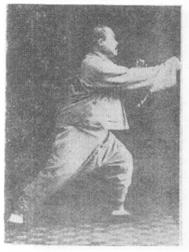
第十五節 如封似閉用法
15. Application of SEALING SHUT
「說明」由前式設敵人以左手握我右拳我即將左手心緣我右肘外面向敵左手腕格去右拳伸開向懷內抽撤撤至两手心朝裏如十字形同時含胸坐胯隨即分開變為两手心向外將敵肘腕封閉左向着其腕右手着其肘急用長勁按出眼前看腰進攻左腿仍屈膝坐實右腿伸直變虛則敵必往後仰仆矣
Explanation:
From the previous posture, if the opponent uses his left hand to grab my right fist, I promptly send my left hand along the outside of my right elbow to obstruct his left wrist. I open my right fist and draw it back toward my chest until both my palms are inward and making an X shape. At the same time, I hollow my chest and sit my hips, spreading my hands and turning them outward to seal off his elbow and wrist, my left hand touching his wrist, my right hand touching his elbow, and quickly applying a long energy, I push him out. My gaze is forward, my waist advances into the attack, and my left leg has again bent at the knee to sit full while my right leg has straightened and become empty. The result is that the opponent inevitably falls back facing upward.

第十六節 十字手用法
16. Application of CROSSED HANDS
「說明」設有敵人由右側自上打下我急往右轉身两脚合步两手由下往上合起作十字形手心朝裏將敵之臂部掤住如敵變雙手按來我即用雙手將敵雙手由內往左右分開手心朝上向下均可同時腰膝稍鬆往下一沉則敵人之力自散而不整矣
Explanation:
If an opponent from my right strikes down from above, I quickly turn my body to the right and bring my feet together, lifting my hands from below to join and make an X shape, palms inward, and ward off his arm. If he changes his attack to a push with both hands, I promptly use both my hands to spread his hands outward from the center, my palms either upward or downward. At the same time, my waist and knees slightly loosen and sink. The result is that the opponent’s force will naturally be scattered.

第十七節 抱虎歸山用法
17. Application of CAPTURE THE TIGER AND SEND IT BACK TO ITS MOUNTAIN
「說明」由前式設敵人自我後面右側用右手從下部擊來或用右足來踢我即往右側轉身出右步屈膝踏實左腿伸直變虛右手隨身轉時將敵右手或足摟至右膝外左手同時由左側往前腕轉運出向敵面部按去如敵又用左手自上打來急用左手腕由敵左手腕下繞過粘住右手同時圓轉提起用腕向敵肘上臂部貼住同時两手往懷內左側合收抱囘則敵人自站不定此時要鬆肩坐肘左足實右足虛
Explanation:
From the previous posture, if an opponent from behind me on my right side uses his right hand to strike me from below, or kicks me with his right foot, I promptly turn my body to the right side and step out with my right foot, bending the knee to sit full as my left leg straightens and becomes empty. While my body turns, my right hand brushes aside his hand or foot to the right until beyond my right knee. My left hand at the same time goes forward from my left side, the wrist rotating, to come out with a push to his face. If he then uses his left hand to strike from above, I quickly use my left wrist to coil around from below his left wrist and stick to it. My right hand at the same time lifts in an arc to stick on top of his elbow with my wrist. At the same time, my hands draw back embracing toward my chest on my left side. The result is that the opponent’s stance will naturally be destabilized. It is important for me to loosen my shoulders and sit my elbows. My left foot is now full, my right foot empty.

第十八節 抱虎歸山內之三式
18. THREE TECHNIQUES WITHIN CAPTURE THE TIGER AND SEND IT BACK TO ITS MOUNTAIN [ROLLBACK, PRESS, PUSH]
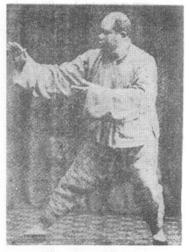


第十九節 肘底看錘用法
19. Application of BEWARE THE PUNCH UNDER ELBOW
「說明」由前勢如敵人自後方用右手來擊我即將右足向左移動坐實身隨之轉動胸含背拔頭頂腰腰鬆左足當身將轉過正面時提起落下脚跟着地脚掌虛朝前两手隨轉身同時動作左手側向裏肘隨肩鬆由左往後側平圓轉轉至正面我之腕臂敵腕臂相交隨自上黏合繞過下面用虎口緊抱其上肘手心向內畧往上托右手隨握拳轉至右脅下虎口朝上向敵人脅部打出眼神前看
Explanation:
From the previous posture, if an opponent from behind me uses his right hand to strike me, I promptly shift my right foot to the left and sit full, my body turning, chest hollowing, back pulling up, headtop pressing up, waist loosening. Before my body has turned to be square to him, my left foot lifts and lowers, heel touching down, sole up to face forward. My hands move along with the turning of my body. My left hand is turning inward, elbow dropping, shoulder loosening, and goes to my left rear in a level arc until I am square to him, and my forearm connects with his forearm. Then from above, my left hand stickily coils around underneath and uses the tiger’s mouth to wrap his elbow, palm inward, and slightly prop it up. My right hand has grasped into a fist and arced to my right ribs, tiger’s mouth upward, and strikes to his flank. My gaze is forward.
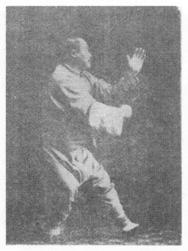
第二十節 倒輦猴左式用法
20. Application of RETREAT, DRIVING AWAY THE MONKEY – LEFT
「說明」由前式敵人用右手當胸打來我即將左手腕中間向敵右肘部裏曲處用半圓黏合沉勁向左往外摟出則敵必隨之往左傾斜左脚隨往後退坐實頭頂肩鬆背拔胸含右脚不動變虛右手同時往後右側環轉而以上備敵人用左手來擊
Explanation:
From the previous posture, the opponent uses his right hand to strike my chest, so I promptly send the inside of my left wrist to the inside of his right elbow, sticking and sinking down in a half circle to brush away outward to the left. The result is that he will inevitably lean to the left. My left foot steps back and I sit full, my head pressing up, shoulders loosening, back pulling up, chest hollowing, and my right foot stays where it is and becomes empty. My right hand at the same time arcs to the right rear and then upward to prepare for the opponent attacking with his left hand.

第二十一節 倒輦猴右式用法
21. Application of RETREAT, DRIVING AWAY THE MONKEY – RIGHT
「說明」由左勢設敵人以左手來擊我即將右手往前畧往下用腕中間粘合敵人肘部裏曲向右往外化出其身法步法與各姿勢均與左式同練法退三步五步七步均可但右手祗至前為止
Explanation:
From the left posture, if the opponent uses his left hand to strike me, I promptly send my right hand forward and slightly downward, using the inside of my wrist to connect with the inside of his elbow and neutralize outward to the right. The methods of body and step are the same as on the left side. When practicing the solo set, you can retreat three steps, five, or seven, so long as your right hand is in front when you stop.

第二十二節 斜飛式用法
22. Application of DIAGONAL FLYING POSTURE
「說明」由前式如敵人自右側面向我上部打來我急用右臂向敵人右臂外側掤右足同時向右側出步如敵人用下壓我臂腕我即乘勢往下稍沉勁隨即將左手上提提至敵腕上面手心向下貼合其腕往我左側略施採意左足暫坐實隨將右手向敵右臂下抽出順勢用腕部側面向敵上脅挒去手心側向裏右脚變實左脚為虛眼神隨去身亦右攻則敵自歪而倒矣
Explanation:
From the previous posture, if an opponent attacks me above from my right side, I quickly use my right arm to ward off to the outside of his right arm, my right foot at the same time stepping out to my right side. If he presses down my right wrist, I take advantage of the momentum, sinking down and promptly lifting my left hand onto his wrist, palm down, sticking to his wrist with an intention of slightly plucking to my left side. I temporarily sit full on my left foot, then thread my right hand under his right arm and, using the side of my wrist, rend away toward his upper flank, palm inward. My right foot is now full, left foot empty. My gaze follows along with my body’s attack to the right. The result is that the opponent naturally leans and topples away.
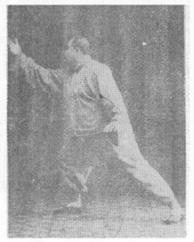
第二十三節 提手用法同前
23. Application of RAISE THE HANDS (same as before)
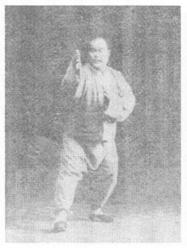
第二十四節 白鵝亮翅用法同前
24. Application of WHITE GOOSE SHOWS ITS WINGS (same as 7)

第二十五節 摟膝拗步用法同前
25. Application of BRUSH KNEE IN A CROSSED STANCE (same as before)

第二十六 海底針用法
26. Application of NEEDLE UNDER THE SEA
「說明」由前式設敵人用右手將我右腕牽動我即屈右肘將手腕往囘一提手心向左左脚隨之收平脚尖點地右脚坐實如敵再將我手腕往下採去我即將右腕順勢鬆勁往下一沉腰隨坐下身往前囘俯下低眼神前視左腿仍虛則敵人之手力自懈
Explanation:
From the previous posture, if an opponent uses his right hand to pull my right wrist, I promptly bend my right elbow and draw back my wrist, lifting it up, palm to the left, my left foot withdrawing, toes touching down, my right foot sitting full. If he again tries to pluck my wrist down, I promptly loosen my wrist and sink down, my waist sitting and my body leaning forward. My gaze is forward and my left leg remains empty. The result is that the opponent’s force is naturally drained away.

第二十七節 扇通臂用法
27. Application of FAN THROUGH THE ARMS
「說明」由前勢設敵人又用右手來擊我同時急將右手由前往上往右提起起至右額角旁隨起隨將手心翻向外以托敵右手之勁左手同時提至胸前用手掌冲開之勁向敵脅部撑去可沉肩墜肘坐腕鬆腰左脚同時向前踏出屈膝坐實脚尖朝前右腿伸直變虛身正向右含騎馬襠式惟眼神隨左手前看則敵人自不能支持矣
Explanation:
From the previous posture, if the opponent now uses his right hand to strike, I quickly lift my right hand up and to the right until beside my right temple, my palm turning outward to prop up his right hand. My left hand at the same time lifts until in front of my chest and, using the palm, thrusts out to brace away his flank. I should be sinking my shoulders, dropping my elbows, sitting my wrists, and loosening my waist. My left leg at the same time steps out forward, bending the knee to sit full, toes forward, right leg straightening and becoming empty. My body is squared to the right almost in a horse-riding stance, but my gaze is in the direction of my left hand. The result is that the opponent is naturally rendered incapable of defending.

第二十八節 撇身捶用法圖
28. Application of FLINGING BODY PUNCH
「說明」由前式設敵人自身後照脊背或脅間用右手打來時我即將右足抬起向後偏右移動落下足尖向前變實右足尖虛向右轉變虛腰身隨轉入正面右手同時由上圜轉向右肋側落下隨握拳用腕部外面手心朝上將敵右手腕叠住同時左手圓轉由左側收囘胸前急向敵人伸去
Explanation:
From the previous posture, if an opponent from behind me uses his right hand to attack my spine or flank, I promptly lift my right foot and shift it to my right rear, bringing it down with the toes forward and it becomes full. My left toes turn to the right and the foot becomes empty as my body turns to be square to him. My right hand at the same time arcs from above to come down beside my right ribs, grasping into a fist, and using the outside of the wrist, palm upward, to pile upon his wrist. At the same time, my left hand arcs from my left side, withdrawing in front of my chest, and then quickly extends toward him.


第二十九節 進步搬攔捶用法
29. Application of ADVANCE, PARRY, BLOCK, PUNCH
說明」由前勢設敵人將被叠之手向左用力撥時我之右手腕稍隨鬆勁急用左肘腕中間向敵右肘裏曲貼往外搬開肘尖略向上手心朝外指尖略向下隨用右捶直向敵之胸部打去此時左足向前邁出一步屈膝坐實右足尖就原地稍向右移轉變虛眼前看腰進攻則敵自往後跌出矣
Explanation:
From the previous posture, if when I have piled onto the opponent’s wrist he forcefully deflects me to my left, my right wrist slightly goes along with it and loosens, and I quickly send my left forearm to connect with the inside bend of his right elbow and move it outward, my elbow slightly up, palm outward, fingers slightly downward. Then I use my right fist to punch straight to his chest, my left foot taking a step forward, the knee bending to sit full, my right foot staying where it is but turning to the right and becoming empty. My gaze is forward and my waist advances with the attack. The result is that the opponent naturally will stumble away.

第三十節 上步攬雀尾用法同前
30. Application of STEP FORWARD, CATCH THE SPARROW BY THE TAIL (same as before)
上為攬雀尾內之捋擠按三式
Includes as before the three techniques of rollback, press, and push.
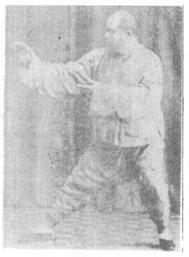


第三十一節 單鞭式用法同前
31. Application of SINGLE WHIP (same as before)
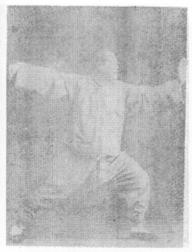
第三十二節 抎手用法右式
32. Application of CLOUDING HANDS – RIGHT
「說明」由前勢設敵人自前面右側用右手擊我胸部或脅部我即將右手落下手心向裏由左而上往右翻轉抎出至敵腕臂外間手心向下往右化去左手同時隨落下手心向下隨往右抎去身亦隨右手拗轉眼神亦同時看去右足往右側挪步坐實左足亦畧有向右移動之意稍虛則敵之位置自然錯亂矣
Explanation:
From the previous posture, if the opponent from in front of me on my right side uses his right hand to strike to my chest or flank, I promptly send my right hand down, palm inward, then from the left going upward to the right, turning over and clouding outward until reaching the outside of his wrist or forearm, my palm down, and neutralizing to the right. My left hand at the same time lowers, palm down, and then clouds to the right, my torso twisting along with my right hand. My gaze at the same time goes outward, my right foot moving a step to the right side and sitting full. My left foot slightly shifts to the right and becomes slightly empty. The result is that the opponent’s position naturally falls into disorder.
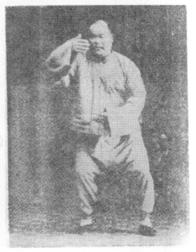
第三十三節 抎手左式
33. CLOUDING HANDS – LEFT
左右用法同自悟方向而已
Same thing in the other direction.

第三十四節 單鞭用法同前
34. Application of SINGLE WHIP (same as before)

第三十五節 高探馬用法圖
35. Application of RISING UP AND REACHING OUT TO THE HORSE
「說明」由單鞭式設敵人用左手自我左腕下繞過往右挑撥我隨將左手腕略鬆勁手心朝上將敵腕叠住往懷內採囘左脚同時提囘脚尖着地鬆腰含胸右腿稍屈膝坐實同時急將右手由後而上圓轉向前往敵人面部用掌探去眼前看脊背略含有探拔前進之意
Explanation:
From the SINGLE WHIP posture, if the opponent uses his left hand to coil around from under my left wrist to prop it up and deflect it to my right, I then slightly loosen my left wrist, palm up, pile it upon his wrist, and draw it back plucking inward. My left foot at the same time lifts and withdraws, toes touching down, while loosening my waist, hollowing my chest, and my right leg slightly bending at the knee and sitting full. At the same time, my right hand quickly arcs up from behind and goes forward to his face, using my palm to strike him away. My gaze is forward and my back is slightly convex with the intent of reaching forward into the attack.

第三十六節 右分脚用法
36. Application of KICK TO THE RIGHT SIDE
「說明」由前勢設敵人用右手接我探出之右腕我隨用右腕閉住敵之右腕墜肘沉肩即將敵左臂向左側捋去同時左手粘住敵人左腕手心向下暗有探勁左脚同時向前左側邁出坐實身隨進將右脚向左提起用脚背向敵人右脅踢去隨將两手向左右分開眼隨右手看去則敵勢自不支
Explanation:
From the previous posture, if the opponent uses his right hand to connect to my right wrist as I stretch it forward, I then use my right wrist to cover his right wrist, dropping my elbows, sinking my shoulders, and promptly plucking his left arm to my left side. At the same time, my left hand sticks to his left wrist, palm down, with a stealthy extending energy. My left foot at the same time steps out forward to the left side and sits full. My body then advances and my right foot lifts to the left and kicks his right flank with the top of the foot, my hands spreading to the sides. My gaze is in the direction of my right hand’s movement. The result is that the opponent naturally cannot hold out against me.


第三十七節 左分脚用法與右同
37. Application of KICK TO THE LEFT SIDE (same as the right)
「說明」三十七圖為左分脚與右式用法練法皆同就是左右方向不同同志將右之方法反左自己領悟就知毋須再贅無論前後凡有同樣圖左右方向自想而知矣
Explanation:
Same as 37 but with left and right reversed and oriented to the left instead of right. Understanding one side, it is not necessary to repeat it for the other. Regardless of what precedes or follows, the photo is the same thing for both sides. As for the orientation to both sides, you will understand if you think about it.


第三十八節 左轉身蹬脚用法
38. Application of LEFT TURN, PRESSING KICK
「說明」由左分脚式設敵人從身後用右手打來我即將身向左正方轉動頂勁含胸拔背鬆腰右脚就原地稍向左轉仍實左腿懸提隨腰轉時脚尖朝下向敵胸部蹬去蹬時用脚跟脚指朝上两手同時隨腰轉時由下往上捧合與左脚蹬出時向左右分開眼神隨往前看去則敵自倒矣
Explanation:
From the posture of KICK TO THE LEFT SIDE, if an opponent strikes at me from behind with his right hand, I promptly turn my body to be facing directly to the left, pressing up my headtop, hollowing my chest, pulling up my back, loosening my waist, my right foot staying where it is but slightly turning to the left and remaining full. My left leg hangs while my body turns, toes down, then kicks out to his chest using the heel, toes up. During the turn, my hands prop up together from below, and during the kick, they spread to the sides, my gaze following forward. The result is that the opponent naturally topples.
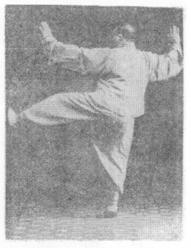
第三十九節 左摟膝用法同前
39. Application of LEFT BRUSH KNEE (same as before)

第四十節 右摟膝用法同前
40. Application of RIGHT BRUSH KNEE (same as before)
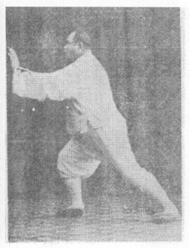
第四十一節 進步栽錘用法
41. Application of ADVANCE, PLANTING PUNCH
「說明」由前式右手摟出時設敵人用右腿踢來我即用左手將敵右腿由裏往左摟開左足同時向前邁出屈膝坐實隨將右手握拳向敵右膝擊之亦可右腿伸直變虛腰身略俯下平曲胸含眼前看則敵自站立不穩矣
Explanation:
When my right hand brushes aside in the previous posture, if the opponent uses his right leg to kick me, I promptly use my left hand to brush aside his leg to my left. My left foot at the same time steps forward and the knee bends to sit full, my right hand grasping into a fist to strike his right knee as my right leg straightens to become empty, my body bending forward but balanced, my chest hollowing, my gaze forward. The result is that the opponent’s stance is naturally destabilized.

第四十二節 翻身撇身錘用法
42. Application of TURN AROUND, FLINGING BODY PUNCH
「說明」由前勢設人用右手自身後來擊我急將身由右往後翻轉轉入正面右手同時提起由左往右圓轉屈肘用腕將敵腕叠住手心朝上暗用採勁左手同時轉過胸前向敵人面部用掌跟挒去左足尖向右稍轉動右腿速提起向前右側落下坐實左腿變虛眼神隨往前看去
Explanation:
From the previous posture, if an opponent uses his right hand to attack me from behind, I quickly turn to my right rear to be square to him. My right hand at the same time lifts and arcs from left to right, bending my elbow and using my wrist to pile upon his wrist, palm up, with a stealthy plucking energy. My left hand at the same time arcs past my chest and, using the heel of the palm, rends away to his face, my left toes slightly turning to the right, my right leg having quickly lifted to the forward right, coming down to sit full, my left leg becoming empty, my gaze following forward.

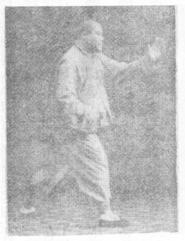
第四十三節 進步搬攔錘用法
43. Application of ADVANCE, PARRY, BLOCK, PUNCH
「說明」由前式設敵人用右臂將我右腕掤起我急將左手腕乘勢將敵右肘裏曲貼合往外搬住右手握拳向敵胸部衝出打去虎口朝上左腿向前邁步屈膝坐實右脚變虛眼前看腰進攻以上身手足各部俱要同時合作則敵必應手而倒矣
Explanation:
From the previous posture, if the opponent uses his right arm to ward off and lift my right wrist, I quickly take advantage of the momentum by sending my left wrist to the inside bend of his right elbow to stick to it and move it outward, my right hand grasping into a fist to thrust to his chest, tiger’s mouth up, my left leg stepping forward, bending at the knee and sitting full, my right leg becoming empty. My gaze is forward and my waist advances with the attack. My upper body, hands, and feet should all act at the same time. The result is that the opponent will easily topple.

第四十四節 右蹬脚用法
44. Application of RIGHT PRESSING KICK
『說明』由前勢設敵人用左手將我右臂向左推出此時將我右腕順勢由敵人手腕下纏裹自右往左挒開隨將右脚向敵人正面蹬出左脚尖同時向左稍轉坐實身亦隨往左轉入正面頭頂背拔眼神隨右脚蹬時看去
Explanation:
From the previous posture, if the opponent uses his left hand to push my right arm out to my left, my right wrist follows the momentum, wraps under his wrist, and rends away from right to left. Then my right foot kicks out toward him. My left foot has slightly turned to the left and sits full, my body turned to be square to my left, my head pressing up, my back pulling up, my gaze following in the direction of my right kick.

第四十五節 左打虎式用法
45. Application of FIGHTING TIGER POSTURE – LEFT
「說明」由前式設敵人由左前方用左手打來我將右足落下左足隨往左側提出屈膝坐實右足變為虛身此時畧成騎馬襠形式面向左正方两手同時落下隨落隨往左合轉用右手將敵左腕扼住往左側下採去左手變拳由左外翻轉上招至左額角旁手心向外急向敵人頭部或背部打去頭頂腰鬆眼神隨左手看去
Explanation:
From the previous posture, if an opponent from my forward [rear] left uses his left hand to strike me, I lower my right foot, step my left foot to my left, bend the knee and sit full, my right foot becoming empty. My body is now almost in a horse-riding stance, square to the left. Both hands at the same time lower and go along with the left turn, my right hand grabbing his left wrist and plucking it down to the left, my left hand becoming a fist and turning over upward from outward on the left to arrive beside my left temple, palm outward, and strike quickly to his head or back. My head is pressing up, my waist is loosening, and my gaze is following in the direction of my left hand.

第四十六節 右打虎式用法
46. Application of FIGHTING TIGER POSTURE – RIGHT
「說明」由左式設敵人自後右側用右手打來我即將右足提起向右側邁去屈膝坐實畧成跨馬式腰隨之往右側前方拗轉左腿變虛两手同時隨落隨往右合轉用左手將敵右腕扼住往右側下採去右手變拳由右外翻轉上招至右額角旁手心向外急向敵人頭部或背部打去頂勁鬆腰眼神隨右手看去
Explanation:
From the left posture, if an opponent from behind me on my right uses his right hand to strike me, I promptly lift my right foot and step out to my right side, bending the knee to sit full, almost making a horse-riding stance, my waist twisting forward to the right, my left leg becoming empty. Both hands lower and go along with the right turn, my left hand grabbing his right wrist and plucking it down to the right, my right hand becoming a fist and turning upward from outward on the right to arrive beside my right temple, palm outward, to quickly strike his head or back. My head is pressing up, my waist is loosening, and my gaze is following in the direction of my right hand.

第四十七節 囘身右蹬脚同前
47. Application of TURN AROUND, RIGHT PRESSING KICK (same as before)

第四十八節 雙風貫耳用法
48. Application of DOUBLE WINDS THROUGH THE EARS
「說明」由前勢設敵人自右側用雙手打來我急將左脚尖稍向右轉仍實右脚同時向右側懸轉膝上提脚尖朝下身同時隨轉速將两手背由上往下將敵人两腕往左右分開叠住頭頂腰鬆背拔胸含隨將两手握拳由下往上向敵人雙耳用虎口貫去右脚同時向前落下變實眼前看身畧有進攻意此時左足變虛
Explanation:
From the previous posture, if the opponent on my right side uses both fists to strike me, I quickly turn my left toes slightly to the right, the foot remaining full, my right foot hanging with the knee up, toes down, my body turning along with the movement, and quickly the backs of my hands go down from above to pile upon his wrists and spread them away to the sides. With my head pressing up, my waist loosening, my back pulling up, my chest hollowing, both my hands then grasp into fists and come up from below to strike his ears with the tiger’s mouths. My right foot at the same time lowers forward and becomes full, my gaze is forward, my torso has a slight intention of advancing into the attack, and my left foot becomes empty.

第四十九節 左蹬脚用法
49. Application of LEFT PRESSING KICK
「說明」由前式設有敵人自左側脅部來擊我急用左手將敵右手臂粘住由裏往外挒開左足同時往前招起照敵胸脅部蹬去右手隨往右分開此時右足在原地微有移動仍坐實頭頂背拔眼神隨往前看去
Explanation:
From the previous posture, if the opponent strikes to my flank from my left side, I quickly use my left hand to stick to his right arm and rend it away from inward to outward. My left foot at the same time lifts forward to kick his chest or flank, my right hand separating away to my right side. My right foot stays where it is, though slightly shifting, and remains full. My head is pressing up, my back pulling up, and my gaze follows forward.

第五十節 轉身蹬脚用法
50. Application of TURN AROUND, PRESSING KICK
「說明」接前式如有敵人從背後左側打來時我急將身往右後邊轉成正面左脚同時隨身轉時收囘隨收隨往右懸轉落下坐實脚尖向前此時右脚掌為一身轉動之樞紐两手合收隨身至正面急用右手腕將敵肘腕粘住自上而下向左挒出右脚同時招起向敵胸脅部踢去左手隨往左分開
Explanation:
Continuing from the previous posture, if an opponent attacks from my left rear, I quickly turn around to the right to face him squarely, my left foot withdrawing to hang while I turn, then coming down to sit full with the toes forward, my right sole being the pivot for the body’s turn. My hands are gathering in until my body is squared, then quickly my right hand sticks to his forearm, and goes down from above and rends away to the left. My right foot at the same time lifts and kicks to his chest or flank, my left hand spreading away to the left.

第五十一節 進步搬攔錘同前
51. ADVANCE, PARRY, BLOCK, PUNCH (same as before)
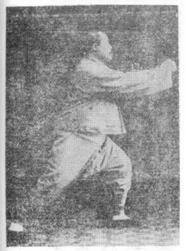
第五十二節 如封似閉同前
52. SEALING SHUT (same as before)

第五十三節 十字手同前
53. CROSSED HANDS (same as before)

第五十四節 抱虎歸山同前
54. CAPTURE THE TIGER AND SEND IT BACK TO ITS MOUNTAIN (same as before)
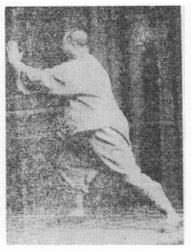
抱虎歸山內之三式(抱與捋不同)
Includes its three techniques of rollback, press, and push. (The capture does not mean the rollback.)
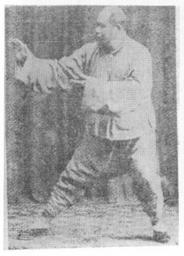


第五十五節 斜單鞭(與前方向不同)
55. DIAGONAL SINGLE WHIP (the orientation different from before)

第五十六節 野馬分鬃右式用法
56. Application of WILD HORSE VEERS ITS MANE – RIGHT
說明」由前式設敵人自右側進左步用左手打來我即將身右轉抽囘右足脚尖虛點地隨用左手將敵左腕牽住往左側下畧有採意同時急上右足屈膝坐實左足變虛隨用右腕向敵腋下分去左手亦隨之鬆開此時身隨進眼前看則敵自歪斜而不能立矣
Explanation:
From the previous posture, if an opponent from my right side advances with his left foot and strikes with his left hand, I quickly turn my body to the right, draw back my right foot, toes lightly touching down, then use my left hand to tug his left wrist with a slight plucking intention down to my left. At the same time I quickly step forward with my right foot, bend the knee to sit full as my left foot becomes empty, and spread my right wrist away to his armpit, my left hand loosening and spreading aside, my body advancing, my gaze forward. The result is that the opponent will naturally lean to the side and be incapable of stability.

第五十七節 野高分鬃左式用法
57. Application of WILD HORSE VEERS ITS MANE – LEFT
「說明」由右式如敵人自左前側方用右手打來我用右手將敵右腕牽制隨進左手左足餘式皆與右同
Explanation:
From the right version of the posture, if the opponent comes from my left side to attack me with his right hand, I use my right hand to tug his right wrist, then advance with my left hand and left foot, the rest the same as on the right side.

第五十八節 攬雀尾
58. CATCH THE SPARROW BY THE TAIL
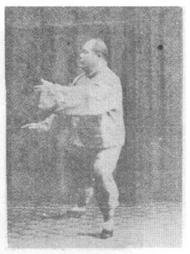

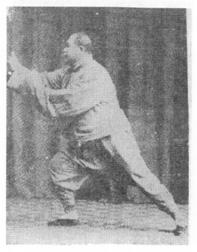

第五十九節 單鞭用法同前
59. Application of SINGLE WHIP (same as before)
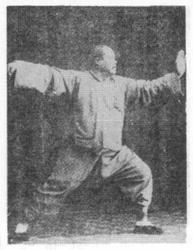
第六十節 玉女穿梭頭一手左式用法
60. Application of MAIDEN WORKS THE SHUTTLE – LEFT
「說明」由單鞭式設敵人從後右側用右手自上打下我即將身右轉右脚隨即提囘左脚前急用右腕將敵右腕外面掤住左脚同時前進屈膝坐實左脚虛再用左腕由敵肘腕裏面往上偏左圓活掤起隨將右手騰出向敵胸脅部按去頭頂腰鬆胸含背拔眼前看則敵自傾
Explanation:
From the SINGLE WHIP posture, if an opponent from behind me on my right side uses his right hand to strike down from above, I promptly turn my body to the right, my right foot lifting and withdrawing in front of my left foot, and I quickly use my right wrist to ward off to the outside of his right wrist. My left foot at the same time advances, bending the knee to sit full as my left [right] foot empties, and I use my left wrist to nimbly ward off upward to the inside of his forearm, my right hand coming away to push to his chest or flank. My head is pressing up, my waist loosening, my chest hollowing, my back pulling up, and my gaze is forward. The result is that the opponent naturally collapses.

第六十一節 玉女穿梭第二手右式用法
61. Application of MAIDEN WORKS THE SHUTTLE – RIGHT
「說明」接前式如敵人由身後右側用右手劈頭打來我即將左脚往裏稍轉右脚同時向後右側出步屈膝坐實身隨向後往右抝轉左脚變虛急用右腕由敵右臂外粘住往上右側掤起隨將左手向敵右脅按去則敵自倒
Explanation:
Continuing from the previous posture, if an opponent from behind me on my right side uses his right hand to chop down to my head, I promptly turn my left foot slightly inward, my right foot stepping out to my right rear, bending the knee and sitting full while my body twists around to the right rear and my left foot becomes empty. I quickly use my right wrist to stick to the outside of his right arm and ward off upward to the right, my left hand pushing to his right flank. The result is that the opponent naturally topples.

第六十二 玉女穿梭
62. MAIDEN WORKS THE SHUTTLE
三式用法與第一式同
Same as 60.
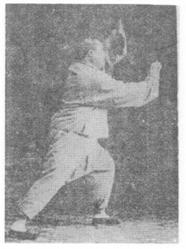
第六十三 玉女穿梭
63. MAIDEN WORKS THE SHUTTLE
四式用法與第二式同
Same as 61.
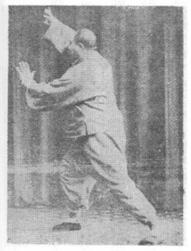
第六十四節 攬雀尾同前
64. CATCH THE SPARROW BY THE TAIL (same as before)




第六十五節 單鞭
65. SINGLE WHIP
無論前後單鞭與抎手二姿式相同練法與用法亦相同
Same as before.

第六十六節 抎手
66. CLOUDING HANDS

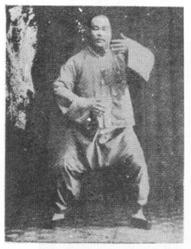
第六十七節 單鞭下式用法
67. Application of SINGLE WHIP, LOW POSTURE
「說明」由單鞭已出之左手如敵人以右手將我左手往外推去或用力握住我即將右腿往後坐下左手同時用圓活裹勁收囘胸前或敵用左手來擊我急用左手將敵左腕扼住往左側下採去亦可右腿與腰身同時坐下以牽彼之力而蓄我之氣
Explanation:
After the SINGLE WHIP’s left hand has come out, if the opponent uses his right hand to push my left hand outward or forcefully grab it, I promptly squat down to the rear on my right leg, my left hand nimbly wrapping to draw back in front of my chest. Or if he uses his left hand to strike, I can quickly use my left hand to grab his left wrist and pluck down to the left [right] as my right leg and body squat. By tugging on his force, I conserve my own energy.


第六十八節 金雞獨立右式用法
68. Application of GOLDEN ROOSTER STANDS ON ONE LEG – RIGHT
由上式如敵人往囘拽其力我即順勢將身向前向上鑽起右腿隨之提起用膝向敵腹部衝去右手隨之前進屈肘指尖朝上以閉敵人左手此時左脚變實穩立頭頂背拔右手隨進時或牽制敵人左右手亦可不必拘執
[Explanation:]
From the previous posture, if the opponent pulls back his energy, I promptly follow his momentum, my body going forward and drilling upward, my right leg lifting and using the knee to thrust into his belly, my right hand coming forward, bending at the elbow, fingers up, to seal off his left hand. My left foot has become full and stands stably, my head is pressing up, my back pulling up. When my right hand comes forward, it can divert either of his hands and is not restricted to one or the other.

第六十九節 金雞獨立左式用法
69. Application of GOLDEN ROOSTER STANDS ON ONE LEG – LEFT
「說明」由右式設敵人用右拳打來我右手沉下速起左手托敵肘提左腿與右理同
Explanation:
From the right posture, if the opponent uses his other hand to strike, my right hand sinks and I quickly lift my left hand to prop up his elbow, lifting my left leg to do as the right has done.

第七十節 倒輦猴同前
70. RETREAT, DRIVING AWAY THE MONKEY (same as before)


第七十一節 斜飛式同前
71. DIAGONAL FLYING POSTURE (same as before)

第七十二節 提手同前
72. RAISE THE HANDS (same as before)

第七十三節 白鶴亮翅同前
73. WHITE CRANE SHOWS ITS WINGS (same as before)

第七十四節 摟膝抝步同前
74. BRUSH KNEE IN A CROSSED STANCE (same as before)

第七十五節 海底針同前
75. NEEDLE UNDER THE SEA (same as before)
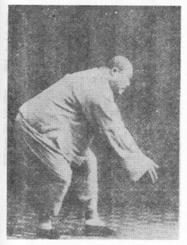
第七十六節 山通背同前
76. MOUNTAIN THROUGH THE BACK (same as 27)

第七十七節 轉身白蛇吐信
77. TURN AROUND WITH WHITE SNAKE FLICKS ITS TONGUE
此式與撇身錘同惟第二式變掌用法在指在掌耳
This is the same as the FLINGING BODY PUNCH, except that in the second photo the fist has opened into a palm, the technique now lying in the fingers and palm.


第七十八節 搬攬錘同前
78. PARRY, CATCH, PUNCH (same as before)

第七十九 攬雀尾式用法同前
79. Application of CATCH THE SPARROW BY THE TAIL (same as before)
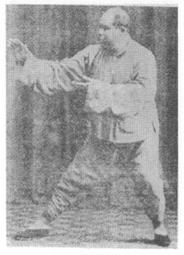


第八十節 單鞭式用法同前
80. Application of SINGLE WHIP (same as before)

第八十一節 抎手用法同前
81. Application of CLOUDING HANDS (same as before)
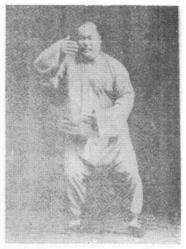

第八十二節 單鞭用法同前
82. Application of SINGLE WHIP (same as before)

第八十三節 高探馬代穿掌
83. RISING UP AND REACHING OUT TO THE HORSE, CHANGING TO THREADING PALM [no explanation given, and palm name changed to PALM STRIKE TO THE FACE further below]

第八十四節 十字單擺蓮用法(即十字腿)
84. Application of CROSSED-BODY SINGLE-SLAP SWINGING LOTUS KICK (called CROSSED-BODY KICK)
「說明」由前式設敵人自身後右邊用右手横混打來我急將身向右正面抝轉左臂同時翻轉屈囘與右臂上下相映時急向身後右側探手由敵右腕裏邊往外粘去同時急將右腿提起用脚背之混勁向敵右脅部踢去則敵必應脚而出矣
Explanation:
From the previous posture, if an opponent from behind me to my right swings at me with his right hand, I quickly twist around to the right to face him squarely, my left arm turning over and drawing in. Once it and my right arm mirror each other above and below, it quickly reaches to my right rear to stick to the inside of his right wrist and take it outward while I quickly lift my right leg and kick sideways with the top of my foot to his right flank. The result is that the opponent must comply with my foot and stumble away.

第八十五節 進步指襠捶用法
85. Application of ADVANCE, PUNCH TO THE CROTCH
「說明」接前式如敵人往囘撤手時我即將右足落下同時左足前進屈膝坐實在此時設敵人再用右足自下來踢急用左手將敵右足往左膝外摟開右手隨即握拳向敵腹部指去身微俯式眼神隨之前看
Explanation:
Continuing from the previous posture, if the opponent draws back his hand, I quickly lower my right foot, step forward with my left foot, bend the knee and sit full. If he is now using his right foot to kick, I quickly use my left hand to brush it aside beyond my left knee, my right hand quickly grasping into a fist and punching to his belly. My body is slightly leaning and my gaze follows forward.

第八十六節 上步攬雀尾用法同前
86. Application of STEP FORWARD, CATCH THE SPARROW BY THE TAIL (same as before)


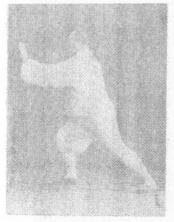
第八十七節 單鞭下式用法同前
87. Application of SINGLE WHIP, LOW POSTURE (same as before)


第八十八節 上步七星用法
88. Application of STEP FORWARD WITH THE BIG DIPPER
由上式設敵人用右手自上劈下我即將身向左前進两手同時集合交叉作七字形手心朝裏掤住向敵用拳直打亦可右腿在两手交叉時提起用脚背踢去左脚變實拔背含胸頭要頂勁眼神往前注視則我身自穩固矣
[Explanation:]
From the previous posture, if the opponent uses his right hand to chop down from above, I quickly advance my body forward to the left, crossing my hands together to make a Big Dipper shape, palms inward, warding off toward him, or I can use fists to strike straight forward. My right leg at the same time kicks out with the top of the foot as my left foot becomes full. I am pulling up my back, hollowing my chest, and my head should be pressing up, my gaze forward, and then my body will naturally be stable.

第八十九節 退步跨虎式用法
89. Application of RETREAT TO SITTING TIGER POSTURE
「說明」由前式設敵人再用雙手從我頭之两旁合擊我即將两腕粘在敵两腕裏邊左手往左側下方沾去右手往右側上方沾起两手心隨之反轉向外右脚隨往後落下坐實腰隨往下沉勁左足隨之稍後提脚尖點地拔背含胸頭頂勁眼神前看
Explanation:
From the previous posture, if the opponent uses both hands together to strike both sides of my head, I promptly send both my wrists to stick to the inside of his wrists, my left hand going out to the lower left, my right hand lifting to my upper right, my palms turning outward. My right foot at the same time comes down to the rear and sits full, my waist sinking down, my left foot slightly lifting, toes touching down. I am pulling up my back, hollowing my chest, and my head is pressing up, my gaze forward.

第九十節 轉身雙擺蓮用法(又名轉脚擺蓮)
90. Application of TURN AROUND, DOUBLE-SLAP SWINGING LOTUS KICK (also called SPIN ON THE FOOT, SWINGING LOTUS KICK)
「說明」由前勢設敵人自我身後用右手打來我即將右脚掌就原地向右後方抝轉身隨圓轉左脚亦隨之懸轉轉至右脚後方落下坐寔同時两手隨身合轉轉至緊挨敵右肘腕粘住隨纏繞腕之裏面往左挒去急用右脚背向敵胸脅部踢去左脚踏實鬆腰頭頂勁眼神向敵人看去右手隨往右分開
Explanation:
From the previous posture, if an opponent from behind me uses his right hand to strike, I promptly spin my body around on my right sole, my left foot hanging during the turn until it comes down behind my right foot and sits full. My hands go along with the spin of my body until they zero in on his right elbow and wrist, then wrap around to the inside of his wrist and rend away to the left as the top of my right foot quickly kicks his chest or flank. My left foot is full, I am loosening my waist, my head is pressing up, my gaze is in the direction of the opponent, and my right hand then spreads away to the right.

第九十一節 彎弓射虎用法
91. Application of BEND THE BOW TO SHOOT THE TIGER
「說明」由前式設敵人往囘撤身時我即將右手隨敵右手粘去隨繞過腕外面握拳打出左手同時沉在敵右肘彎曲處右脚隨往右落下坐實腰下沉勁如騎馬襠樣式左脚變虛
Explanation:
From the previous posture, if the opponent withdraws his body, I promptly stick to his right hand with my right hand, coiling around to the outside of his wrist, making a fist and striking. My left hand at the same time is sinking the bend of his right elbow, while my right foot lowers to the right and sits full, my waist sinking, putting me almost in a horse-riding stance, my left foot becoming empty.

如練法圖與後三十七對圖解說少有不同是各有意思皆對太極變化不能拘一
If there are any differences between these solo practice photos and the sparring photos further below, it is because each case comes with the idea that since Taiji is adaptive, you cannot be restricted to a single method.
第九十二節 進步搬攔捶(用法同前)
92. ADVANCE, PARRY, BLOCK, PUNCH (application same as before)

第九十三節 如封似閉(用法同前)
93. SEALING SHUT (application same as before)

第九十四節 由如封似閉作十字手式同前收式變為合太極
94. From SEALING SHUT, make the CROSSED HANDS posture as before, then change to CLOSING POSTURE.

十三勢歌
THIRTEEN DYNAMICS SONG
十三勢來莫輕視 命意源頭在腰際
變轉虛實須留意 氣遍身軀不少滯
靜中觸動動猶靜 因敵變化示神奇
勢勢存心揆用意 得來不覺費功夫
刻刻留心在腰間 腹內鬆淨氣騰然
尾閭中正神貫頂 滿身輕利頂頭懸
仔細留心向推求 屈伸開合聽自由
入門引路須口授 功夫無息法自休
若言體用何為凖 意氣君來骨肉臣
想推用意終何在 益壽延年不老春
歌兮歌兮百四十 字字眞切義無遺
若不向此推求去 枉費工夫貽嘆息
Do not neglect any of the thirteen dynamics,
their command coming from the lower back.
You must pay attention to the alternation of empty and full,
then energy will flow through the whole body without getting stuck anywhere.
In stillness, movement stirs, and then in moving, seem yet to be in stillness,
for the magic lies in making adjustments based on being receptive to the opponent.
In every movement, very deliberately control it by the use of intention,
for once you achieve that, it will all be effortless.
At every moment, pay attention to your waist,
for if there is complete relaxation within the belly, energy is primed.
The tailbone is centered and spirit penetrates to the headtop,
thus the whole body will be nimble and the headtop will be pulled up as if suspended.
Pay careful attention in your practice that you are letting bending and extending, contracting and expanding, happen as the situation requires.
Beginning the training requires personal instruction,
but mastering the art depends on your own unceasing effort.
Whether we are discussing in terms of theory or function, what is the constant?
It is that mind is sovereign and body is subject.
If you think about it, what is emphasizing the use of intention going to lead you to?
To a longer life and a longer youth.
Repeatedly recite the words above,
all of which speak clearly and hence their ideas come through without confusion.
If you pay no heed to those ideas, you will go astray in your training,
and you will find you have wasted your time and be left with only sighs of regret.
–
[PUSHING HANDS]
(一)
合步推手甲右足在前乙亦右足在前即四正推手
1. Same step pushing hands:
Person A and Person B both have their right foot forward. (This is for exercising the four primary techniques.)
(一)
順步推手甲右足在前乙左足在前為順步
2. Opposite step pushing hands:
A has his right foot forward while B has his left foot forward.
(一)
活步推手或甲乙各進三步或甲或乙各退三步且記進者先進前腿退者先退後足為標準手與前推手同
3. Lively step pushing hands:
One advances three steps while the other retreats three steps. Remember when advancing to start with the front foot and when retreating to start with the back foot. The hands will still be the same as in the previous versions.
(一)
一步推手為合步姿勢甲進右足左足隨進半步乙退後左足一步右足亦隨退半步此為前帶後後帶前甲乙先後均可
4. Single step pushing hands:
A advances his right foot then his left follows a half step. B retreats his left foot then his right follows a half step. This is the front leading the rear and the rear leading the front. It makes no difference who is going forward or back.
以上各種推手手法皆同惟步法不同耳
In all of the versions of pushing hands above, the hand method is the same, and it is only the footwork that varies.
[PLAYING HANDS SONG]
掤捋擠按須認眞
上下相隨人難進
任他巨力來打我
牽動四両撥千斤
引進落空合即出
粘連黏隨不丢頂
Ward-off, rollback, press, and push must be taken seriously.
With coordination between above and below, the opponent will hardly find a way in.
I will let him attack me with as much power as he likes,
for I will tug with four ounces of force to move his of a thousand pounds.
Guiding him in to land on nothing, I then close on him and send him away.
I stick to him and go along with his movement instead of pulling away or crashing in.
推手法圖解
PHOTOGRAPHIC EXPLANATION OF THE PUSHING HANDS EXERCISE
如甲乙二人練習先作右琵琶式對手時無論甲乙右足在前均可其距離寬窄隨人得機得勢為標凖初搭手為接式甲為掤乙為按
Two people practice together, A [Tian Zhaolin (in black)] and B [Dong Yingjie], first making the “lute” posture on the right side. When their hands meet, it does not matter whose right foot starts forward. Their distance from each other will depend on their bodies, timing, and position. They first connect by crossing hands, then A does a ward off while B does a push. [See photo 1:]

[The text for the next three photos was copied from Chen Weiming’s 1925 Taiji manual. This is the main reason for the discrepancy between left and right, since the photos in Chen’s book are of the opposite hands.]
甲隨乙按時腰往囘坐縮以左手腕黏乙肘尖上處亦同時雙手往囘捋此謂之捋如推手第二圖
When A goes along with B’s push, he shrinks away his waist and sits back, using his left [right] wrist to stick on top of B’s elbow, at the same time rolling back with both hands. For the rollback, see photo 2:

乙被甲捋則身傾於左方似不得力而乙之右手隨甲捋之方向送去以左手掌補於右肘灣處向前擠去此謂之擠如三圖
B is being rolled back by A, causing his body to incline to the left [right] side so he cannot generate any power, but while B’s right [left] hand goes out along the direction of A’s rollback, he uses his left [right] palm to assist at the bend of his right [left] elbow and presses forward. For the press, see photo 3:

甲被乙擠似不得力即含胸以左手心黏乙左手背往左化去則乙擠不到身上矣甲之右手同時按乙肘處两手同時向前按去此之謂按如第四圖
A is being pressed by B, but B cannot generate any power because A hollows his chest and uses his left [right] palm to stick to the back of B’s left [right] hand and neutralize it to the left [right] so B’s press cannot get to him. A’s right [left] hand at the same time pushes on B’s [right] elbow and both hands push forward together. For the push, see photo 4:
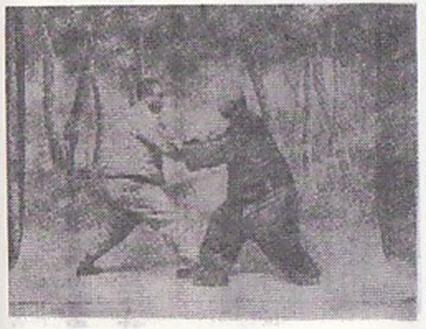
四正推手法
[FOR A MORE DETAILED EXPLANATION, HERE IS THE] PUSHING HANDS METHOD FOR THE FOUR PRIMARY TECHNIQUES [text copied from Xu Yusheng’s 1921 Taiji manual]
四正推手者即两人推手時用捋擠按掤四法向四方周而復始作互相推手之運動也作此法時两人對立作雙搭手右式
Pushing hands with the four primary techniques is when two people are pushing hands using the four techniques of rollback, press, push, and ward-off, which are aligned with the four cardinal directions, repeating the cycle over and over again, back and forth between the two people. To begin, they stand opposite each other and cross their right hands.
甲屈膝後坐屈两臂肘尖下埀(作琵琶式)两手分攬乙之右臂腕肘處向懷內斜下方捋
[1] A bends his knees and sits back, bends his arms so his elbows hang down (making the “lute” posture), his hands grabbing B’s right arm at the elbow and wrist, and he rolls back inward and diagonally downward. [like photo 2, but with left and right reversed]
乙趁勢平屈右肱成九十度角形向甲胸前前擠接其雙腕並以左手移撫肱內以助其勢
[2] B takes advantage of the momentum and bends his right forearm across, making a ninety-degree angle, and presses forward toward A’s chest with his wrists connected, then shifts his left hand to touch the inside of his forearm and assist the power. [like photo 3, left and right reversed]
甲當乙擠肘時含胸腰微左轉雙手趁勢下按乙左膊
[3] Right when B presses with his elbow, A hollows his chest and turns his waist slightly to the left, both hands taking advantage of the momentum and pushing down on B’s left arm. [like photo 4, left and right reversed]
乙即以左臂擠推分作弧線向上運行掤化甲之按力同時右膊亦自下纏上甲之左肘以謝其勢
[4] B then uses his left arm to do a pressing push, bringing it away [from his right arm] in an upward arc to ward off and neutralize A’s pushing force. At the same time, his right arm also coils from below to prop up A’s left elbow and assist the neutralization. [like photo 1, but with roles reversed, left and right still reversed]
乙掤化甲之按力後即趁勢捋甲之左臂
[5] Once B wards off and neutralizes A’s pushing force, he then takes advantage of the momentum and rolls back A’s left arm. [like photo 2, roles reversed, left and right reversed]
甲隨乙之捋勁前擠
[6] A goes along with B’s rollback energy and presses forward. [like photo 3, roles reversed, left and right reversed]
乙隨甲之擠勁下按
[7] B goes along with A’s pressing energy and pushes down. [like photo 4, roles reversed, left and right reversed]
甲即掤化乙之按力後捋自此周而復始運轉不已是謂四正推手法
[8] A then wards off and neutralizes B’s pushing power [like photo 1, left and right reversed] and then rolls back [like photo 2, left and right reversed].
All of this goes round and round without end. This is called the pushing hands method for the four primary techniques.
大捋用法單式圖解
PHOTOGRAPHIC EXPLANATION OF EACH POSTURE IN THE EXERCISE OF LARGE ROLLBACK
第一節 甲為掤化去勁之圖甲前膊為掤肘尖涵去勁
1. Photo of A [Yang Chengfu] doing a ward-off to neutralize B’s attacking energy (A’s forearm is in a ward-off posture, energy filling to his elbow.):
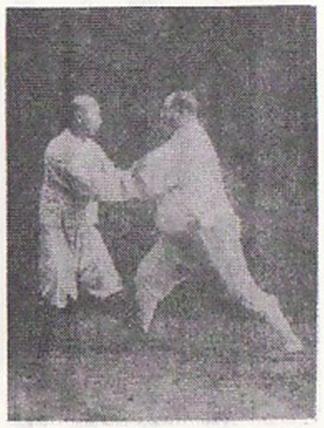
第二節 甲為捋截之圖甲左手為捋為採右手為截两手總式為挒
2. Photo of A doing a rollback and intercept (A’s left hand is rolling back and plucking while his right hand is intercepting. Both hands together are doing a rending technique.):

第三節 甲為採閃之圖甲左手為採為切右手為閃為愰
3. Photo of A doing a pluck and a flashing palm strike (A’s left hand is plucking and cutting away while his right hand is flashing out and surprising B.):

第四節 甲為擠靠之圖甲左手扶處為擠右背尖處為靠
4. Photo of A doing a press and bump (A’s left hand supports with a press while he bumps with his right shoulder.):
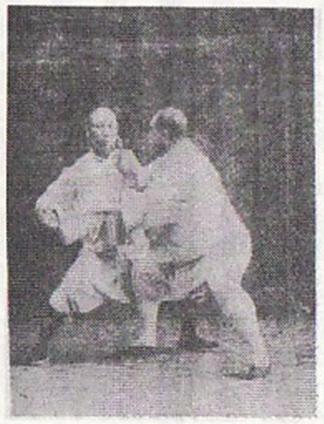
四隅推手法(即大捋)
[FOR A MORE DETAILED EXPLANATION, HERE IS THE] PUSHING HANDS METHOD FOR THE FOUR SECONDARY TECHNIQUES (KNOWN AS LARGE ROLLBACK) [also copied from Xu Yusheng’s 1921 book]
四隅推手者一名大捋即两人推手時用肘靠採挒四法向四斜方周而復始作互相推手之運動以濟四正之所窮也作此法時两人南北對立作雙搭手右式
Pushing hands with the four secondary techniques, also known as Large Rollback, is when two people are pushing hands using the four techniques of elbow, bump, pluck, and rend, which are aligned with the four corner directions, repeating the cycle over and over again, back and forth between the two people. It compensates for the limitations of the four primary techniques. To begin, they stand opposite each other along a north-south line [A facing south, B facing north] and cross their right hands.
甲右足向西北斜邁一步作騎馬式或丁八步右臂平屈右手撫乙之右腕左臂屈肘用下膊骨中處向西北斜捋乙之右臂
[1] A steps his right foot diagonally to the northwest, making a stance between a horse-riding stance and a wide T-stance, with his right arm level and bent, his right hand touching B’s right wrist, his left arm bends at the elbow and uses the middle area of the outer forearm bone to roll back B’s right arm diagonally to the northwest. [like photo 2, left and right reversed]
乙即趁勢左足向走前方橫出一步移右足向甲襠中插襠前邁一步同時右臂伸舒向下肩隨甲之捋勁向甲胸部前靠左手撫右肱內輔助之此時甲乙仍相對立乙面視東北方
[2] B then takes advantage of the momentum and steps his left foot across forward [and to the left], moving his right foot to step forward between A’s legs. At the same time, his right arm extends downward, his shoulder going along with A’s rollback energy, and bumps forward into A’s chest with his left hand assisting by touching the inside of his own right arm. Both people are still facing each other, with B looking toward the northeast. [like photo 4, roles reversed]
甲以左手下按乙之左腕右手按乙之左肘尖下採同時左足由乙之右足外移至乙之襠中
[3] A uses his left hand to push down on B’s left wrist and his right hand to push down on B’s left elbow, plucking down. At the same time, his left foot goes from the outside of B’s right foot to step between B’s legs. [like photo 1, roles reversed]
乙隨甲之採勁右腿向西南方後撤作騎馬式左臂平屈右手撫甲之左腕右臂屈肘用下膊骨中處向西南方斜捋甲之左臂
[4] B goes along with A’s plucking energy and withdraws his right [left] leg to the southwest, making a horse-riding stance, and with his right [left] arm level and bent, his left hand touches A’s left wrist, and his right arm bends at the elbow and uses the middle area of the forearm bone to rollback A’s left arm diagonally to the southwest. [like photo 2, roles reversed]
甲趁勢右足前出一步移左足向乙襠中插襠前邁一步同時左臂伸舒向下肩隨乙之捋勁向乙胸部前靠右手撫左肱內以輔助之此時甲乙仍相對立甲面視東南方
[5] A takes advantage of the momentum and steps his right foot forward, moving his left foot to step forward between B’s legs. At the same time, his left arm extends downward, his shoulder going along with B’s rollback energy, and bumps forward into B’s chest, with his right hand assisting by touching the inside of his own left arm. Both people are again facing each other, with A looking toward the southeast. [like photo 4, left and right reversed]
甲左臂欲上挑乙即隨甲之挑勁左手作掌向甲面部撲擊右手按甲之左肩斜向下挒
[6] A’s left arm wants to lift up. B then goes along with A’s lifting energy, his left hand doing a palm strike toward A’s face while his right hand pushes on A’s left shoulder, diagonally rending downward. [like photo 3, roles reversed, left and right reversed]
甲隨乙之挒勁撤左足向東北方邁左手撫乙之左腕右臂屈肘向東北斜捋乙之左臂
[7] A goes along with B’s rending energy and withdraws his left foot a step to the northeast, his left hand touching B’s left wrist, his right arm bending at the elbow, and rolls back B’s left arm to the northeast. [like photo 2]
乙勢趁上右步移左足向甲襠中前邁左臂隨甲之捋勁用肩向甲胸部前靠右手輔之面視西北方
[8] B takes advantage of the momentum and steps forward with his right foot, moving his left foot to step forward between A’s legs, his left arm going along with A’s rollback energy and using his shoulder to bump forward into A’s chest, his right hand assisting. The direction B is facing is northwest. [like photo 4, roles reversed, left and right reversed]
甲以右手下按乙之右腕左手按乙之右肘尖下採同時右足由乙左足外移至乙襠中
[9] A uses his right hand to push down on B’s right wrist and his left hand to push down on B’s right elbow, plucking down. At the same time, his right foot goes from the outside of B’s left foot to step between B’s legs. [like photo 1, roles reversed, left and right reversed]
乙隨甲之勁採撤右足向東南方邁右手撫甲之右腕左臂屈肘向東南斜捋甲之右臂
[10] B goes along with A’s plucking energy and withdraws his right foot to the southeast, his right hand touching A’s right wrist, and with his left arm bent at the elbow, rolls back A’s right arm diagonally to the southeast. [like photo 2, roles reversed, left and right reversed]
甲趁勢上左步移右足向乙襠中前邁右臂隨乙之捋勁用肩向乙胸部前靠左手輔之面視西南方
[11] A takes advantage of the momentum and steps forward with his left foot, moving his right foot to step forward between A’s legs, his right arm going along with B’s rollback energy, and uses his shoulder to bump forward into B’s chest, his left hand assisting. The direction A is facing is southwest. [like photo 4]
甲右臂欲上挑乙即隨甲之挑勁右手作掌向甲面部撲擊左手按甲之右肩斜向下挒甲退左腿雙手捋乙之右臂腕肘處還右雙搭手式此為一度可繼續為之是謂四隅推手法
[12] A’s right arm wants to lift up. B then goes along with A’s lifting energy, his right hand doing a palm strike toward A’s face while his left hand pushes on A’s right shoulder, diagonally rending downward. [like photo 3, roles reversed]
[1 repeating] A retreats his left [right] leg, and with both hands rolls back B’s right arm at the wrist and elbow area. [like photo 2, left and right reversed]
Both people have returned to the posture of crossing their right hands and this whole sequence may continue. This is called the pushing hands method for the four secondary techniques.
–
大小太極解
THE LARGE TAIJI & THE SMALL TAIJI
天地為一大太極,人身為一小太極,人身為太極之體,不可不練太極之拳,本有之靈而重修之,良有以也,人身如機器,久不磨而生銹,生銹而氣血滯,多生流弊,故人欲鍜煉身體者,必先練太極最相宜,太極練法,以心行氣不用濁力,純任自然,筋骨鮮折曲之苦,皮膚無磋磨之勞,不用力何能有力,蓋太極練功,沉肩墜肘,氣沉丹田,氣能入丹田,為氣總機關,由此分運四體百骸,以氣週流全身,意到氣至,練到此地位,其力不可限量矣,此不用濁力純以神行,功效著矣,先師云,極柔軟然後極堅剛,蓋此意也。
The universe is a grand taiji. A human being is a mini taiji. Since the human body is essentially a taiji, it needs to practice a form of boxing that is a taiji. We are born with a nimbleness which later has to be built up all over again, an inborn talent to make use of. The body is like a piece of machinery which gets rusty after protracted disuse, causing the energy and blood to become stagnant, leading to many destructive effects. Thus if you want to refine your body, you must first practice Taiji to get the best results. The method of training Taiji is to use the mind to move energy and not use awkward effort. Keep it pure and natural, the joints feeling very little contortionist strain and the skin receiving no irritation of friction. But without using strength, how can there be strength? By this means: in the practice of Taiji, sink the shoulders and drop the elbows, sinking energy to the elixir field. If energy can get there, it will be a base of operations and from there move into the limbs and throughout the whole body. With the circulation of energy everywhere, energy arrives wherever it is willed. When your training has reached this condition, your strength will be limitless. In this way, not using awkward effort and only using mental movement, effectiveness will be reached. An earlier teacher said: “Extreme softness becomes extreme hardness.” This is the idea.
–
王宗岳原序
AN ORIGINAL TEXT BY WANG ZONGYUE
以心行氣,務令沉着,乃能收歛入骨,以氣運身,務令順遂,乃能便利從心,精神能提得起,則無遲重之虞,所謂頂頭懸也,意氣須換得靈,乃有圓活之趣,所謂變動虛實也,發勁須沉着,鬆淨須專主一方,立身須中正安舒,撑支八面,行氣如九曲珠,無往不利,(氣遍身軀之謂)運勁如百煉鋼,無堅不摧,形如搏兎之鵠,神如捕鼠之貓,靜如山岳,動如江河,蓄勁如開弓,發勁如放箭,曲中求直,蓄而後發,力由脊發,步隨身換,收即是放,斷而復連,往復須有摺叠,進退須有轉換,極柔軟,然後極堅剛,能呼吸,然後能靈活氣,以直養而無害,勁以曲蓄而有餘,心為令,氣為旗腰為纛,先求開展,後求緊凑,乃可臻于縝密矣。
Use the mind to move energy. You must get your posture to settle. The energy is then able to collect in the bones. Use energy to move the body. You must get your movement to be smooth. The body can then easily obey the mind. If you can raise your spirit, then you will be without worry of being slow or weighed down. The Thirteen Dynamics Song calls for the whole body to be nimble and the headtop to be pulled up as if suspended. The mind must perform alternations nimbly, and then you will have the qualities of roundness and liveliness. The Thirteen Dynamics Song says to pay attention to the alternation of empty and full. When issuing power, you must sink and relax, concentrating it in one direction. Your posture must be straight and comfortable, bracing in all directions. Move energy as though through a winding-path pearl, penetrating even the smallest nook (meaning the energy is everywhere in the body). Wield power like tempered steel, so strong there is nothing tough enough to stand up against it. The shape is like a falcon capturing a rabbit. The spirit is like a cat pouncing on a mouse. In stillness, be like a mountain, and in movement, be like a river. Store power like drawing a bow. Issue power like loosing an arrow. Within curving, seek to be straightening. Store and then issue. Power comes from the spine. Step according to the body’s changes. To gather is to release. Disconnect but stay connected. In the back and forth [of the arms], there must be folding. In the advance and retreat [of the feet], there must be variation. Extreme softness begets extreme hardness. Your ability to be nimble lies in your ability to breathe. By nurturing energy with integrity, it will not be corrupted. By storing power in crooked parts, it will be in abundant supply. The mind makes the command, the energy is its flag, and the waist is its banner. By seeking first the gross movement and then the finer details, you will be able to attain a refined level.
王宗岳原序解明
EXPLANATIONS TO WANG’S TEXT
以心行氣務令沈着乃能收歛入骨
Use the mind to move energy. You must get your posture to settle. The energy is then able to collect in the bones.
平時用功,練十三勢用心使氣緩緩流行於骨外肉內之間,意為嚮導氣隨行,至於練拳姿勢要沈舒,心意要貴靜,心不靜不沈着,不能沈着則氣不收入骨矣,即是外勁也,練太極拳能收歛入骨此眞正太極勁也。
In your daily training of practicing the Thirteen Dynamics solo set, use your mind to get the energy to slowly spread between the bones and muscles. The intent is the guide and the energy follows it. When practicing the solo set, the postures should be settled and comfortable. The mind should have a strong sense of calmness, for if the mind is not calm, there will be no settling. If you cannot have settling, the energy will not collect in the bones, and you will have merely an external strength. When practicing Taiji Boxing, if the energy can collect in the bones, this will be a genuine Taiji strength.
以氣運身務令順遂乃便利從心
Use energy to move the body. You must get your movement to be smooth. The body can then easily obey the mind.
同志想使氣運身流通,必得十三勢敎正無錯,方是先師所傳的拳,姿勢上下順遂,勁不矯揉,氣纔能流通,如姿勢順遂,心中指揮手脚遂心矣。
If you want to get energy to move through the body, it is crucial that the instruction you obtain as to how to do the solo set be precisely correct. Only then is it the boxing passed down from the early teachers. The postures should be smooth in the upper body and lower. There is no forced strength, so the energy can then get through. If the postures are smooth, the mind will command and the hands and feet will obey.
精神能提得起則無遲重之虞所謂頂頭懸也
If you can raise your spirit, then you will be without worry of being slow or weighed down. The Thirteen Dynamics Song calls for the whole body to be nimble and the headtop to be pulled up as if suspended.
精神為一身之主,不但練拳,無論作何事,有精神迅速,必不遲慢,所以講拳必提精神為先,欲要提精神,頭容正直要頂勁,即泥丸宮虛靈勁上昇,此法悟通,就是提精神之法也。
The spirit is the entire body’s director. Not only is this so in the practice of boxing, but in everything you do. With the spirit quick, there will certainly be no slowness. Therefore when discussing boxing, it is essential that raising the spirit is the first thing to be addressed. If you want to raise your spirit, your head is to be upright and should have an energy of pressing up. This is the natural energy of rising at the “clay-pellet palace” [acupoint at the top of the head]. Once you comprehend this principle, you will have the method of raising the spirit.
意氣須換得靈乃有圓活之趣所謂變化虛實也
The mind must perform alternations nimbly, and then you will have the qualities of roundness and liveliness. The Thirteen Dynamics Song says to pay attention to the alternation of empty and full.
意氣即骨外肉內流動物也,至於練拳打手,想得言不出着一種的興趣來,必使流動物滿身能跑,意左即左,意右則右,就是太極有虛有實的一種的變化,意氣的換法,猶如半瓶水,左側則左蕩,右側則右蕩,能如是,不但得圓活之趣,更有手舞足蹈之樂,至此境地,若人阻我練拳,恐欲罷不能也,因知身體受無限之幸福矣。
The mind is something that moves between the bones and muscles. When practicing the solo set or playing hands, the experience feels captivating in a way that words are not quite adequate to explain. You must get the mind to course through the whole body. When the mind goes to the left, the body goes to the left, and when the mind goes to the right, the body goes to the right. These are the transformations of empty and full in Taiji. The alternations of the mind are like a flask half full of water: tip it to the left and it floods the left half, or tip it to the right and it floods the right half. If it can be like this, not only will you have obtained the qualities of roundness and liveliness, there will also be pleasure in the movements of your hands and feet. Once in such a condition, if someone were to try to prevent me from practicing, I doubt they would be able to, because I would be aware that my body is having so much fun.
發勁須沈着鬆靜專主一方
When issuing power, you must sink and relax, concentrating it in one direction.
與人敵先將敵治住,打他一個方向,即敵向歪挒的那個方向,如發勁無論一手肩肘要沈下,心中要鬆靜,發勁專打,敵一個方向,我勁不散,敵不難跌出丈外矣。
When facing an opponent, first get him under your control and then attack him along a single direction, namely the direction in which he is inclining. When you issue power – be it through hand, shoulder, or elbow – you should sink down and mentally relax, issuing power in a focused attack at him along a single direction. So long as my power is not dispersed into many directions, it will not be difficult to send him stumbling away more then ten feet.
立身須中正安舒支撑八面
Your posture must be straight and comfortable, bracing in all directions.
頭容正直尾閭中正身即不偏,心內要舒展,以靜待動之意,腰腿如立軸,膊手如臥輪,圓轉如意,方能當其八面。
When the head is upright and the tailbone is centered, the body will not lean. In the mind there should be a sense of comfort and an intention of awaiting movement with stillness. The waist and thighs move like a vertical pivot while the arms and hands move like a horizontal wheel. With these two mechanisms roundly turning as you please, you will then be able to equalize in all directions.
行氣如九曲珠無微不到
Move energy as though through a winding-path pearl, penetrating even the smallest nook.
九曲珠者即一個珠內有九曲灣也,人身譬如珠,四體百駭無不灣也,能行氣四肢無有一處不到,行氣九曲珠功成矣。
A winding-path pearl is a pearl with a very twisting pathway threaded through it. The human body is like a sphere and the limbs and bones are all laid out along curves. If you can move energy through the limbs without a single place going untouched, you have achieved moving energy as though through a winding-path pearl.
運勁如百鍊鋼何堅不摧
Wield power like tempered steel, so strong there is nothing tough enough to stand up against it.
運勁如百鍊鋼即內勁,非一日之功也,日月練習慢慢磨練出來的,猶如一塊荒鉄,日日錘鍊,慢慢化出一種純鋼來,欲作刀劍鋒利無比,無堅不摧,太極練出來細而有鋼之勁,即鐵人亦能打壞,何妨對敵者為血肉之軀乎。
“Wield power like tempered steel.” This refers to internal power. It cannot be achieved in a single day. Practicing every day for many months, gradually work at it until it develops. It is like a lump of iron ore smelted and hammered day after day until gradually it is turned into pure steel, which if you then wished to use to make a sword, its edge would be the sharpest of all.
“There is nothing tough enough to can stand up against it.” Taiji practice develops a power that is delicate yet steel-like. It could break a man made of iron. So what defense would your flesh-and-blood opponents have?
形如搏兎之鶻神如捕鼠之貓
The shape is like a falcon capturing a rabbit. The spirit is like a cat pouncing on a mouse.
鶻者飛禽也,鷹類也,冬獵用之,此言與人對敵比仿我形式如鷹鶻,見物拿來,眼要吃住敵人,一搭手就可將敵擒到,即如鶻捕物之狀,此喻非罵人也,先師文字如此不得不解之,望諸君勿疑焉,貓像虎形能捕鼠,等鼠伏身坐臥後腿,全身精神貫注鼠洞,如出猛捕之得鼠焉,此言太極有涵胸拔背之勢,如貓捕鼠之形,待機而發,敵得受用矣。
A falcon is a flying hunter, a bird of prey, used as part of winter hunts. When facing an opponent, my bearing is like a bird of prey, which upon seeing an animal, grabs it. Your eyes should eat the opponent. Once you cross hands, you can capture the opponent in the manner of a falcon capturing an animal. This analogy is not meant to make you cruel toward people. The way it is stated in the writings of previous teachers requires clarification and I hope not to leave you all with uncertainties.
In its talent for catching mice, a cat resembles a tiger. Crouching down and lying into its hind legs, it waits for the mouse. Its whole body and spirit is concentrated on the mouse’s hole. If the mouse comes out, the cat savagely pounces and the mouse is caught. This describes the energy in Taiji of containing your chest and pulling up your back. It is the attitude of a cat pouncing on a mouse. By waiting for the opportunity then issuing, the opponent will be on the receiving end.
靜如山岳動若江河
In stillness, be like a mountain, and in movement, be like a river.
用功日久,腿下有根站立如山,人力不可搖動也,江河之喩言各種變化無窮,一手變五手,五手變百手,言其滔滔不絕,如江河之長也。
Once you have worked at it every day over a long period, under your legs there will be a feeling of root and you will stand like a mountain unshakeable by human strength. The river analogy indicates all variety of limitless changes. A single technique changes into five, which then turns into a hundred as it flows on ceaselessly like the length of a river.
蓄勁如張弓發勁如放箭
Store power like drawing a bow. Issue power like loosing an arrow.
蓄者藏也,太極勁不在外藏于內,如敵對手時,內勁如開弓不射之圓滿,猶皮球有氣充之,敵人伏我膊,雖綿軟而不能按下,使敵莫明其妙,敵心疑時,不知我弓上已有箭要發射矣,我如弓敵如箭,出勁之速,敵如箭跌出矣。
To store means to conceal. Power in Taiji is not apparent but rather is stored inside. When facing an opponent, internal power is like fully drawing a bow but not yet loosing the arrow, or like a leather ball filled with air. When he lays hands on my arms, although they are soft he cannot push them down, which baffles him. While he is busy being confused, he does not know my bow is loaded with an arrow that wants to be set free. I am like a bow and he is like an arrow, for due to the suddenness of the power that comes out, he stumbles away fast as an arrow.
曲中求直蓄而後發
力由脊發步隨身換
收即是放放即是收斷而復連
Within curving, seek to be straightening. Store and then issue.
Power comes from the spine. Step according to the body’s changes.
To gather is to release and to release is to gather. Disconnect but stay connected.
此三說總而言之,解說容易明瞭,曲中求直即隨曲就伸之意,蓄而後發力由脊發收是放一理也,就是神如捕鼠之貓之理,一二語道盡學家宜自得之。
The explanation of these three expressions is easy to understand. “Within curving, seek to be straightening.” The idea is that after you bend, you are then to extend. “Store and then issue… Power comes from the spine… To gather is to release.” These phrases all mean the same thing, namely that again the spirit is like a cat catching a mouse. With just these few words, the method is spelled out. You should be able to take it from here and realize for yourself.
往復須有摺疊進退須有轉換
In the back and forth [of the arms], there must be folding. In the advance and retreat [of the feet], there must be variation.
與人對敵或來或往,摺疊即曲肘灣肱之式,摺背敵其身手此係近身使用法,離遠無用,進退不要泥一式,須有轉換隨機變化也。
There are comings and goings when dealing with opponents. Folding means to make a shape in which you bend the elbow and round the arm, turning away his body or hands. This is applied when close and is useless when separated at a distance. When advancing and retreating, you should not maintain the same stance. There must be variation, adapting in response to circumstances.
極柔軟而後極堅剛能呼吸然後能靈活
Extreme softness begets extreme hardness. Your ability to be nimble lies in your ability to breathe.
練十三勢要用柔法,然後功成就生出柔中含藏內勁,呼吸者,蓋吸能提得人起,能使敵後足離地,再呼氣力從脊內發出全身之勁放得人遠出,呼吸靈通,身法然後才能靈活無滯。
When practicing the solo set, it should be done with softness. After you have worked at it for a long time, you will be generating internal power hidden within the softness. “Breathe” means that when you inhale you can lift the opponent, making his rear foot leave the ground, then when you exhale, power comes from the spine, issuing with the power of the whole body, and sends the opponent far away. By mastering breathing, your body’s techniques will then be quick and crisp.
氣以直養而無害勁以曲蓄而有餘
By nurturing energy with integrity, it will not be corrupted. By storing power in crooked parts, it will be in abundant supply.
練太極是養氣之法,非運氣之工作也,何為運氣人心急有力弩氣練法,氣必聚一個地方,放出不易,恐與內有妨碍,何為養氣,孟子云我善養吾浩然之氣,不急不燥,先天氣生,靜心養性,練拳使內精氣神合一,行氣流通九曲珠,如未得到益定無害也,與人敵不使膊伸直,能上下相隨,步隨身換,膊未直而力有餘,敵早跌出,就是勁以曲蓄而有餘。
Practicing Taiji is a method of nurturing energy rather than a project of wielding energy. What is meant by wielding energy? If a person’s training method is impatient, insistent, or angry, the energy will inevitably accumulate in one place and it will be difficult to send an opponent away due to the impeding of it internally. What is nurturing energy? Mengzi said, “I am good at nurturing my noble energy.” By being neither anxious nor impetuous, innate energy will manifest. By calming your mind and restraining your temperament, practicing the boxing will cause essence, energy, and spirit to merge within. By moving energy as though through a winding-path pearl, then even if you have not gained the upper hand, you have kept yourself from corrupting your energy.
When dealing with an opponent, do not let your arms straighten, be able to have coordination between the upper body and lower, and step according to your body’s changes. When your arms are not straightened, there is more power in reserve, and so the opponent will be sent stumbling away that much sooner. This is the meaning of “By storing power in crooked parts, it will be in abundant supply.”
心為令氣為旗腰為纛
The mind makes the command, the energy is its flag, and the waist is its banner.
太極之理猶行軍戰事,必有令旗指揮驅使,練太極亦然,所以心為令,就是以心行氣,能使氣如旗,意之所至,氣即隨之而到,就是心如令氣如旗,腰為纛者即軍中大纛旗也,小旗主動,大旗主靜,拳法腰可作車軸之轉,不能倒挒大纛旗也。
Taiji theory is akin to military operations, in which there needs to be command flags to convey orders. Practicing Taiji is the same kind of thing. The mind makes the command, the mind being what moves the energy. If the energy can be equivalent to a flag, then where the intent goes, the energy will arrive. Therefore the mind is like a commander and the energy is like a flag. The waist as the banner means the large flag at the center of the army. The small flags direct movement and the large flags direct stillness. In the boxing techniques, the waist turns like an axle and must not drop or snap the banner.
先求開展後求緊凑乃可臻於縝密也
By seeking first the gross movement and then the finer details, you will be able to attain a refined level.
開展大也,鬆其筋肉,初學練拳先求姿勢開大,謂能舒筋活血,容易轉弱為强,强而後,研究外能筋骨肉合一,內有精氣神相聚,謂之緊凑,內外兼修,加以動靜變化,自開展而及緊凑,身體强而使用全,可至臻密境矣,如說拳大練小練則誤矣。
The meaning of “gross movement” is to make the posture big and to loosen the muscles. When beginning to learn the solo set, first of all strive for the postures to be opened up quite big, which will loosen the sinews and enliven the blood, making it easier to transform weakness into strength.
Once you have become strengthened, examine your outward ability to integrate sinew, bone, and muscle, while inwardly gathering together essence, energy, and spirit. This phase of the process is the “finer details”. Cultivate the inside and outside simultaneously, adding also the alternations between movement and stillness. Going from gross movement to finer details, strengthening the body and perfecting the applications, you will be able to attain a refined level. If it is suggested the idea of this passage is that the postures of the solo set are to practiced big and then small, that is incorrect.
原文
FURTHER ORIGINAL TEXT
又曰,彼不動,己不動,彼微動,己先動,勁似鬆非鬆,將展未展,勁斷意不斷。
It is also said:
If he takes no action, I take no action, but once he takes even the slightest action, I have already acted. The power seems to relax but [the intent of it] has still not relaxed. The power has expressed but [the intent of it] is not finished expressing. The power finishes but the intent of it continues.
又曰,先在心,後在身,腹鬆氣歛入骨,神舒體靜,刻刻在心,切記一動無有不動,一靜無有不靜,牽動往來,氣貼背歛入脊骨,內固精神,外示安逸,邁步如貓行運,勁如抽絲,全身意在精神,不在氣,在氣則滯,有氣者無力,無氣者純剛氣,若車輪,腰如車軸。
It is also said:
First in the mind, then in the body. The abdomen relaxes completely and then energy collects in the bones. The spirit is comfortable and the body is calm. At every moment be mindful, always remembering: if one part moves, every part moves, and if one part is still, every part is still. As the movement leads back and forth, energy stays near the back and gathers in the spine. Inwardly bolster spirit and outwardly show ease. Step like a cat and move energy as if drawing silk. Throughout the body, the mind should be on the spirit rather than on the energy, for if you are fixated on the energy, your movement will become sluggish. Whenever the mind is on the energy, there will be no power, whereas if you ignore the energy and let it take care of itself, there will be pure strength. The energy is like a wheel and the waist is like an axle.
原文解明
EXPLANATIONS TO THE TEXT
又曰先在心後在身
First in the mind, then in the body.
初學對敵,用心之專,恐不能勝,練成之後,無須有心之變化,身受擊處自能應敵,心中不知,敵跌出矣,即為不知手之舞之,初學在心,成功後在身,猶如初學珠算,心先念歌手操之,後熟心不歌手能如意,亦先在心後在手,拳理亦然。
When you start learning to spar, you will think about everything you do and probably lose. After you have completed the training, you will not have to think about how to adapt, the body will deal with attacks by spontaneously responding without the mind being involved. The opponent will stumble away and you will not be aware of how you did it. The training starts in the mind and ends in the body. It is like learning to use an abacus, in which you start by thinking through the steps to get your fingers to go where they need to go, then after you get used to the patterns, your fingers fly around by themselves – first in the mind, then in the hand. The boxing theory is the same.
腹鬆靜氣歛人骨
The abdomen relaxes completely and then energy collects in the bones.
腹雖注意猶鬆舒,不要鼓勁,氣練入骨,骨肉沉重矣,外如棉花,內似鋼條,猶如綿花裹鐵之理。
Although you get the abdomen to relax, the concentration to do so should not cause energy to be stimulated there, for the energy needs to be taught to go gather in the spine while the rest of the body sinks weightily. Outwardly be like cotton and inwardly be like steel wires, just like the principle of iron within silk.
刻刻在心切記一動無有不動一靜無有不靜
At every moment be mindful, always remembering: if one part moves, every part moves, and if one part is still, every part is still.
刻刻時時也,謹記一動全身之動,不要一部分動,猶火車頭行動,諸車隨動焉,太極動勁要整,雖整而又活焉,如行車無不動矣,身雖動心貴靜,如心一靜全身靜,雖靜又庽動焉,如動要上下相隨至要。
Constantly keep in mind that when one part moves, the whole body moves, and there should not be any part moving by itself. It is like the engine car of a train: all the other cars will move along with it. In Taiji, the moving of energy should be arranged in an orderly way. Yet it should also be lively, in the same way there is no car which is not moving when they are following the engine car. However, while the body moves, the mind wants stillness. Once the mind has any stillness, the whole body becomes still, and although it is stillness, it contains movement ready to start up again. When moving, coordination between the upper body and lower is the most important thing.
牽動往來氣貼背歛入脊骨內固精神外示安逸
As the movement leads back and forth, energy stays near the back and gathers in the spine. Inwardly bolster spirit and outwardly show ease.
牽動往來,即手之舞動,氣吸能入貼與脊背,蓄而待發,氣吸能藏于脊骨即有內固之精神,外表文雅安逸,雖練武而猶文也。
The movement leading back and forth has to do with the balletic movements of the hands [during the pushing hands exercise]. When energy is drawn back and can stay by the spine, store it and wait for the moment to issue it. When it is drawn back and can be stored in the spine, then you are bolstering spirit. By outwardly displaying a refined ease, then although what you are practicing is martial, you appear civil.
邁步如貓行運勁如抽絲
Step like a cat and move energy as if drawing silk.
太極拳步行走,如貓行之輕靈,練拳運勁如抽絲之不斷。
The Taiji Boxing footwork is like the lightness and nimbleness of a cat’s steps. When practicing the solo set, move the energy like drawing an unbroken thread of silk.
全身意在精神不在氣在氣則滯有氣者無力無氣者純剛
Throughout the body, the mind should be on the spirit rather than on the energy, for if you are fixated on the energy, your movement will become sluggish. Whenever the mind is on the energy, there will be no power, whereas if you ignore the energy and let it take care of itself, there will be pure strength.
人身有三寶,曰精,氣,神,太極意在此,不在氣者不在運氣之氣,在氣則滯如運氣澎漲一部份,滯而不靈,有氣者無力,有濁氣者,自覺有力,敵覺我無力,無氣者純剛,無有濁氣即生綿力,意想則力到,如搭手如皮條搭在敵膊,所以我未用力,敵覺我手重如泰山矣,不用直力則巧力生,無濁氣者為純剛。
In the human body there are three treasures: essence, energy, and spirit. The intent in Taiji is upon the spirit. When the mind is not on the energy, this means you are not thinking about moving the energy around. When the mind is on the energy and you become sluggish, this is because when you are thinking about moving the energy around, too much will accumulate in one area, and then once this has made you sluggish you cannot be nimble. When the mind is on the energy, there will be no power because the energy has been corrupted. If I feel I have no power, the opponent will also sense I have no power. When the energy is ignored, there will be pure strength because in the absence of corrupted energy a continuous power is generated. Wherever your intention thinks, the power will arrive there. When crossing hands with an opponent, it is like leather straps have been hung over his arm. Even though I have not yet applied any force, he feels my hands are as heavy as Mt. Tai. By not applying direct force, a skillful power is generated. Being without corrupted energy is pure strength.
氣如車輪腰似車軸
The energy is like a wheel and the waist is like an axle.
全身意氣如車輪流行,腰為一身之主宰,腰如車軸能圓轉,所以拳變化在腰間也。
The energy throughout the body is like the turning of a wheel. Since the waist controls the whole body, it is like an axle moving. Therefore the adaptations in the boxing occur at the waist.
又曰彼不動己不動彼微動己先動
If he takes no action, I take no action, but once he takes even the slightest action, I have already acted.
與敵對搭手自己不動,待對手一動之際,我手動之在先矣。
When crossing hands with an opponent, I take no action. Instead I wait for the moment when he takes any kind of action and my hands are then on their way before he gets going.
似鬆非鬆將展未展勁斷意不斷
The power seems to relax but [the intent of it] has still not relaxed. The power has expressed but [the intent of it] is not finished expressing. The power finishes but the intent of it continues.
太極拳出手,說鬆亦不鬆,伸出亦未直為度,練拳可以不斷有一定之姿勢,能以線串成,如講對敵使用無一定之姿勢發人出去,我之姿勢外形似有所斷,而我意未少懈也,猶如蓮藕拆斷內細絲不斷,以此譬喩容易明瞭,楊老師常言勁斷意不斷,藕斷絲連,蓋此意也。
When expressing with the hands in Taiji Boxing, it is described as relaxed but still not relaxed, and that when extending it is not quite extended all the way. When practicing the solo routine, it can be a continuous series of choreographed postures all strung together, but when facing opponents and applying the techniques, there is no choreography to sending opponents away. Thus outwardly my posture will seem to have finished, but my intent will not be even slightly letting up. It is just like when you break a lotus stalk but the tiny fibers in it are still connected. This analogy makes it easy to understand. Yang Chengfu often said: “The power finishes but the intent continues. The stalk is snapped but the fibers are still connected.” This is the idea.
–
太極指明法
POINTERS TOWARD ENLIGHTENMENT IN TAIJI
用勁不對,不用力不對,綿而有剛對,丢不對,頂不對,不丢不頂對,沾不對,不沾不對,不即不離對,浮不對,重不對,輕靈鬆沈對,胆大不對,胆小不對,胆要壯而心要細對,打人不對,不打人不對,將敵治心服對。
– It is wrong to use force and it is wrong not to use force. It is right to have softness containing hardness.
– It is wrong to run away and it is wrong to crash in. It is right to be neither running away nor crashing in.
– It is wrong to stick to him and it is wrong not to stick to him. It is right to be neither joining nor separating.
– It is wrong to be floating and it is wrong to be heavy. It is right to be light and agile, loosened and settled.
– It is wrong to be reckless and it is wrong to be cowardly. It is right to be bold yet aware.
– It is wrong to fight and it is wrong not to fight. It is right to get him to control himself and give up.
–
凡例
GENERAL REMARKS [Part 2]
一,太極拳術已漸為無人所注重而使用方法尚無專書表示實為缺憾本書即本此意編著形勢具備願與海內人士共同研究之
– In the art of Taiji Boxing, gradually fewer people lay stress on the methods of application, and as yet there is no book concentrating on demonstrating them. Truly this is flawed and hence this volume is based upon this issue. The author’s postures have been provided with the hopes that everyone in the nation may study them together.
一,太極拳使用之精巧本非筆墨所能形容本書三十七圖雖各圖皆說明其用法但神而明仍在乎其人
– Applying Taiji Boxing skillfully is essentially like writing calligraphy fluently. Although the thirty-seven photos that follow all come with explanation as to their methods, the real understanding nevertheless lies within your own body.
一,說中設為甲乙甲為使用之人乙為對敵之人俾易明瞭
– Within the explanations are established an A person and a B person (A is the defender. B is the attacker.) so that you may follow along clearly as you read through them.
一,圖說後凡關於太極拳之理論及源流等並附述之俾便研究但疏畧無當自知不免閱者諒之
– Following the photos and explanations are pieces on Taiji Boxing theory and origins, as well as anecdotes, to more easily facilitate your studies. However, they are somewhat vague and without direct experience will mean little. Pardon this.
–
王宗岳太極論
THE TAIJI TREATISE OF WANG ZONGYUE
太極者無極而生陰陽之母也動之則分靜之則合無過不及隨曲就伸人剛我柔謂之走我順人背謂之黏動急則急應動緩則緩隨雖變化萬端而理為一貫由着熟而漸悟懂勁由懂勁而階及神明然非用力之久不能豁然貫通焉虛領頂勁氣沉丹田不偏不倚忽隱忽現左重則左虛右重則右杳仰之則彌高俯之則彌深進之則愈長退之則愈促一羽不能加蠅蟲不能落人不知我我獨知人英雄所向無敵蓋由此而及也斯技旁門甚多雖勢有區別槪不外乎壯欺弱慢讓快耳有力打無力手慢讓手快是皆先天自然之能非關學力而有也察四两撥千斤之力顯非力勝觀耄耋能禦衆人之形快何能為立及平凖活似車輪偏沉則隨雙重則滯每見數年純功不能運化者率皆自為人制雙重之病未悟耳欲避此病須知陰陽相濟方為懂勁懂勁後愈練愈精默識揣摩漸至從心所欲本是捨己從人多悟舍近求遠所謂差之毫釐謬之千里學者不可不詳辨焉是為論
Taiji is born of wuji, and is the mother of yin and yang. When there is movement, the passive and active aspects become distinct from each other. When there is stillness, they return to being indistinguishable.
Neither going too far nor not far enough, comply and bend then engage and extend. He is hard while I am soft – this is yielding. My energy is smooth while his energy is coarse – this is sticking. If he moves fast, I quickly respond, and if his movement is slow, I leisurely follow. Although there is an endless variety of possible scenarios, there is only one theory throughout.
Once you have engrained these techniques, you will gradually come to identify energies, and then from there you will work your way toward something miraculous. But unless you practice a lot over a long time, you will never have a breakthrough.
Forcelessly press up your headtop. Energy sinks to the elixir field. Neither lean nor slant. Suddenly hide and suddenly appear. When there is pressure on the left, the left empties. When there is pressure on the right, the right disappears. When looking up, it is still higher. When looking down, it is still lower. When advancing, it is even farther. When retreating, it is even nearer. A feather cannot be added and a fly cannot land. The opponent does not understand me, only I understand him. A hero is one who encounters no opposition, and it is through this kind of method that such a condition is achieved.
There are many other schools of boxing arts besides this one. Although the postures are different between them, they generally do not go beyond the strong bullying the weak and the slow yielding to the fast. The strong beating the weak and the slow submitting to the fast are both a matter of inherent natural ability and bear no relation to skill that is learned. Examine the skill of “four ounces moves a thousand pounds”, which is obviously not a victory obtained through strength. Or consider the sight of an old man repelling a group, which could not come from an aggressive speed.
Stand like a scale. Move like a wheel. If you drop one side, you can move. If you have equal pressure on both sides, you will be stuck. We often see one who has practiced hard for many years yet is unable to perform any neutralizations and is generally under the opponent’s control, and the issue here is that this error of double pressure has not yet been understood.
If you want to avoid this error, you must understand that passive and active exchange roles. Once you have this understanding, you will be identifying energies. Once you are identifying energies, then the more you practice, the more efficient your skill will be, and by absorbing through experience and by constantly contemplating, gradually you will reach the point that you can do whatever you want.
The basic of basics is to forget about your plans and simply respond to the opponent. We often make the mistake of ignoring what is right in front of us in favor of something that has nothing to do with our immediate circumstances. For such situations it is said: “Miss by an inch, lose by a mile.” You must understand all this clearly. That is why it has been written down for you.
–
對敵圖
PHOTOS OF DEALING WITH AN OPPONENT
第一式 攬雀尾使用法
1. Application of CATCH THE SPARROW BY THE TAIL
上手為甲下手為乙如二人對敵乙執右拳直打甲之胸部甲自乙右膊下抬起雙手繞外邊轉上與乙膊靠接以意運氣往外推去右足同時往前上一步左足在後蹬勁將乙打出如圖是也
A [Yang Chengfu] is the defender. B is the attacker. If when the two people are opposing each other, B uses his right fist to strike A’s chest, A lifts both hands from below B’s right forearm, turns outward and upward to go against B’s forearm, and using intention to move energy, pushes outward. At the same time, he steps his right foot forward and presses back with his left foot, sending B away. See the photo:

掤捋擠按由攬雀尾內變化換勁化勁是也後編推手法內寫明
Within CATCH THE SPARROW BY THE TAIL, this ward-off changes to rollback, press, and push, but these techniques have already been explained in the pushing hands section.
第二式 單鞭使用法
2. Application of SINGLE WHIP
如上式攬雀尾將人打出如甲身後又來一人如乙自上輪拳太山壓頂打來甲遂速往左方轉身左手托敵人的胸前下部左足弓式右足蹬為直線同時右手在後變為刁手以作沉勁此為單鞭開勁左手迎敵將人打出如圖是也
From the previous posture, if B attacks from behind, wheeling his fist from above with the technique of MT. TAI CRUSHES THE HEAD, A then quickly turns around to the left, his left hand propping to B’s chest or lower, his left leg bending and right leg pressing straight. At the same time, his right hand changes to a hook to make a sinking energy, which generates the spreading power of the whip, the left hand meeting the opponent and sending him away. See the photo:

第三式 提手用法
3. Application of RAISE THE HANDS
拳之打法不一如甲單緶式如乙持左拳以直打來甲含胸雙手往一處合勁敷在乙左膊上往前下方沉打將乙打倒坐在地上如圖此
There is more than one way to strike when fighting. If A is in his SINGLE WHIP posture and B does a straight punch with his left fist, A hollows his chest and closes both hands toward the same place, applying them on top of B’s forearm to go forward and downward with a sinking strike, making B fall back and sit on the ground. See the photo:

即提手用法也提手用法有二提上打沉下打皆可也
This is an application of RAISE THE HANDS, but there is another: in addition to raising upward to strike, you could also sink below to strike.
第四式 白鶴亮翅用法
4. Application of WHITE CRANE SHOWS ITS WINGS
甲如提手式將人打出如乙外功甚大手勁有練抓力的自上抓來甲遂進身上步閃過乙手甲再往上將右膊抬起托乙肘處身法再往上長往外掤勁將乙打出如白鶴亮翅是也如乙或用左手或用右手來抓皆可以白鶴亮翅應之
From the previous posture, if B has trained himself to have a powerful grip and grabs from above, A then advances to evade B’s hand, then lifts his right forearm to prop up B’s elbow, his body expanding upward and outward with a ward-off energy to send B away. It is like a white crane showing its wings. Whether B grabs with his left hand or right, this technique can be used in response. [See the photo:]

第五式 左摟膝抝步用法
5. Application of BRUSH KNEE IN A CROSSED STANCE – LEFT
甲如亮翅式如乙右手自前斜方擊來甲左手自外繞至乙膊前節往下摟去同時甲右手落下向後轉繞至膀尖齊直往乙胸前拍去左足弓右足在後蹬勁如圖是也
If A is in the posture of WHITE CRANE SHOWS IT WINGS and B uses his right hand to strike forward at an angle, A’s left hand comes from the outside, coils around B’s forearm, and brushes it away downward. At the same time, A’s right hand lowers to the rear, turning until the elbow is level and straight, and slaps B’s chest, his left leg bending and his right leg straightening behind. See the photo:

第六式 右摟膝抝步用法
6. Application of BRUSH KNEE IN A CROSS STANCE – RIGHT
如乙若用左手以直打來甲可以用右手摟住乙的左膊甲左手繞自膀尖處伸指掌拍乙胸前要掌心去勁右足弓式左足蹬勁如右摟膝圖是也
If B uses his left hand in a straight strike, A can use his right hand to brush and stick to B’s left forearm as his left hand coils from the elbow, straightens the fingers, and slaps B’s chest as a palm, his right leg bending and his left leg pressing. See the photo:

第七式 琵琶式用法
7. Application of PLAY THE LUTE
如左摟膝式甲立敵人如乙右手自右外方繞裏直打來甲右手隨乙手繞直時甲右手囘勁扣粘乙裏手腕同時甲左手招起托乙的肘尖甲指掌俱要伸開手心用力將乙膊托直將乙的前足尖提起使乙不得力也甲右足坐實左足為虛式如圖是也
If A is in the posture of LEFT BRUSH KNEE and B coils his right hand in from the right side to do a straight punch, A’s right hand follows B’s hand as it coils and straightens, drawing in, covering and sticking to the inside of B’s wrist. At the same time, A’s left hand lures in and props up B’s elbow. A’s fingers should be spread and the palm forcefully prop up B’s forearm, causing B’s front foot to lift and rendering him unable to apply power. A’s right leg sits full, left leg empty. See the photo:

第八式 搬攬錘用法
8. Application of PARRY, CATCH, PUNCH
如甲直立若乙外力甚大而且又快摹右拳打來力重千斤將至臨近甲速含蓄身畧往右邊側乙拳已經打空甲右拳速自乙右拳外方繞乙手腕上沉勁此為稱錘雖小壓千斤理在是也甲左手同時將乙膊搬開甲右拳不落遂直擊乙身上左足同時上步弓式右足為直線如搬攬錘圖是也
If B closes with a very strong and fast punch, A quickly shrinks away his body slightly to the right side so B’s punch lands on nothing, and his right fist quickly turns from the outside of B’s right fist to be on top of it and sinks it down. This is the principle of a slight pressure subduing a heavy punch. At the same time, A’s left hand stops B’s forearm, and lowering his right fist no further, punches straight to B’s body. Also at the same time, his left foot steps forward and his right leg straightens. See the photo:

第九式 如封似閉用法
9. Application of SEALING SHUT
如甲右手打乙,乙用左手封當,甲的左手自己右膊下邊往前比住乙左手腕,甲右手速抽囘,再去按乙左橫肘上,雙手按勁往前推去,左足在前作弓式,右足在後為直線,足根不可欠起,其根在足,如封似閉之圖是也。
When A’s right hand strikes B, if B uses his left hand to block, A’s left hand goes forward under his own right forearm to match B’s left wrist and quickly draws his right hand back to then push on the side of B’s left elbow, and pushes forward with both hands. As the left leg bends, the right leg straightens, but its heel must not lift, for the root is in the feet. See the photo:
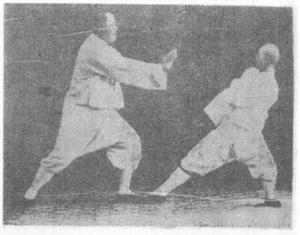
第十式 十字手用法
10. Application of CROSSED HANDS
甲立如乙雙拳打來,甲隨亦雙掌自下往上掤如十字,架開乙雙手如圖是也。
If B strikes with both fists, A then comes from below with both palms to ward off upward in an X shape, propping up both of B’s hands. See the photo:

第十一式 抱虎歸山用法
11. Application of CAPTURE THE TIGER AND SEND IT BACK TO ITS MOUNTAIN
甲立如乙自右後方持拳直擊,甲隨轉趾扭腰,右手往後如右摟膝摟撥乙右膊,將乙身挒歪,同時隨起左手將乙拍倒,右足弓式,左足直線如圖是也,
A is standing. If B comes from the right rear and does a straight strike with his [right] fist, A then turns on his toe and twists his waist, his right hand going to the rear as in the RIGHT BRUSH KNEE posture to brush aside B’s right forearm, causing B’s body to become uncentered. At the same time, he lifts his left hand to slap B away, his right leg bending and his left leg straightening. See the photo:

又第二用法如乙再還左手來擊,甲亦用左手應之,甲速再用右膊拗抱敵人之身腰擒起,猶如壯士捉虎歸山之勢,此二用法也。
Another scenario is that B strikes with his left hand, A then using his left hand to respond to it while quickly using his right hand to wrap around and capture B’s torso in the manner of a hero capturing a tiger and sending it back to its mountain. This is the second version.
第十二式 肘底錘用法
12. Application of PUNCH UNDER ELBOW
甲按手式立,如乙拳法心詭計多,自甲左後方用右拳一打速往囘就退,甲速向左方轉身進步,左手自乙拳上繞下伸進托乙的肘尖,隨用右拳打乙右脅,乙速退,甲速進三步才可打上,如圖是也。
A is standing in the pushing posture. If B’s technique is too sneaky and he gets in a strike with his right fist from A’s left rear and then quickly retreats, A quickly turns to the left and advances a step, his left hand coiling from above to below B’s fist, extending forward to prop up B’s elbow, and uses his right fist to strike B’s right flank. If B quickly retreats, A quickly advances a few steps to be able to strike him. See the photo:

眞用少易,不可泥影。
It is slightly different when actually applying it, for then you must not conceal [the punch].
第十三式 倒輦猴用法
13. Application of RETREAT, DRIVING AWAY THE MONKEY
甲立,如乙用換拳法,左右拳先後直打,如右拳以直打來,右足進一步,隨後左拳打來,左足進步,此為拉鑽錘進步法,甲用倒輦猴破法,退左步左手摟乙的右拳,退右步右手摟乙的左拳,往後如法速退幾步,甲如用換式亦可,左手摟乙右拳時,甲進右拳換打乙胸,甲右手摟乙左拳,甲用左掌還擊可將乙打退,如圖是也。
A is standing. If B is using alternating punches, left and right following each other in straight attacks, advancing the right foot with the right punch and the left foot with the left punch, the technique here being advancing with pulling-and-drilling punches, then A uses RETREAT, DRIVING AWAY THE MONKEY to upset the technique, retreating with his left foot while his left hand brushes aside B’s right fist, then retreating with his right foot while his right hand brushes aside B’s left fist. As A goes back, it seems to be a rapid retreat of several steps. He can also switch up the posture: when his left hand brushes B’s right fist, he can advance with his right fist to strike B’s chest, or when his right hand brushes B’s left fist, he can use his left palm to strike and make B retreat. See the photo:
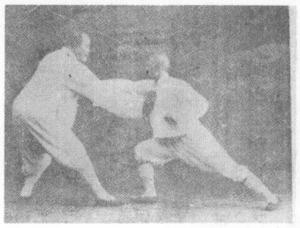
第十四式 斜飛式用法
14. Application of DIAGONAL FLYING POSTURE
甲直立,如乙對敵正面不能進,想換繞側面進打,甲隨繞時,即用右手如大鵬展翅,往斜上方掤去,自乙膊下至身時左足用直勁,右足為弓式,左右手皆能用,如圖是也。
A is standing. If B stands directly in front of him so he cannot advance, he turns sideways to advance with a strike. When A turns, he uses his right arm like a large bird unfurling a wing to ward off diagonally upward under B’s arm, and upon reaching B’s body, his left leg straightens powerfully while his right leg bends. This technique can be applied with either arm. See the photo:

第十五式 海底針用法
15. Application of NEEDLE UNDER THE SEA
如乙手有力握甲右手腕不能脫開,甲用海底針,身足往囘縮勁,右手用力往下伸肱直送下,乙手力無能為,海底針是也
If B’s hand forcefully grabs A’s right wrist so A cannot escape, A employs NEEDLE UNDER THE SEA, his hand and foot shrinking back, his right hand forcefully going downward, extending his forearm until it is straight to send B’s hand away. The strength of B’s hand will not be sufficient for him to do anything about it. This is NEEDLE UNDER THE SEA:

第十六式 山通背用法
16. Application of MOUNTAIN THROUGH THE BACK
甲如海底針式,乙打來,甲由下往上用右手托乙右手腕,甲左手由下向前直推去手心向外,掌指向上,推乙身,右身側面,左足同時進步弓式,右足為後直線,如圖是也。
If B strikes while A is in the posture of NEEDLE UNDER THE SEA, A’s right hand goes up from below to prop up B’s right wrist, and his left hand goes forward from below in a straight push with the palm outward and fingers up, pushing B’s body with his own body sideways. At the same time, A’s right leg advances and bends and his right leg straightens behind. See the photo:

第十七式 撇身捶用法
17. Application of FLINGING BODY PUNCH
如上式乙自後面用右手打來甲速向右轉趾過來,右拳自上落下恰好壓在乙下膊上,甲隨伸左手就是一掌,如圖是也。
From the previous posture, if B strikes with his right hand from behind, A quickly turns around to the right, pointing his toes toward B, his right fist coming down from above to press down on B’s forearm, then extends his left hand to send a palm strike. See the photo:

第十八式 抎手用法
18: Application of CLOUDING HANDS
甲如騎馬式,乙自前面,用右拳打來,甲用右手自左邊往右邊抎去,如乙用左手打來,甲用左手自右往左抎去,領進落空,乙力雖千斤,無所用矣,如圖是也,
If A is in a horse-riding posture and B from in front of him uses his right hand to strike, A uses his right hand to cloud from the left side to the right side (or if B uses his left hand to strike, A uses his left hand to cloud from right to left), guiding B’s attack to land on nothing. Even if B uses a thousand pounds of force, it will be of no use. See the photo:
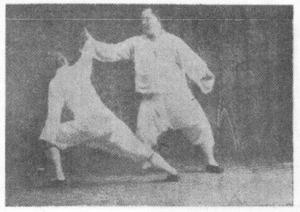
練法橫走,使法正面。
In practice it is a sideways step, but here the application of it is directly in front.
第十九式 高探馬用法
19. Application of RISING UP AND REACHING OUT TO THE HORSE
如乙伸出左拳,甲將左手自外繞至上邊,扣住乙左手腕處往囘拉許,甲右掌自外方伸打乙面,如圖是也。
If B sends out his left fist, A’s left hand from the outside turns over until it is above, then covers B’s left wrist and somewhat pulls it in, while his right palm goes from the outside to extend and strike B’s face. See the photo:

第二十式 分脚用法
20. Application of KICKING TO THE SIDE
甲如高探馬式雙手捋乙左膊,飛起右腿用脚面踢乙腹上,雙手速鬆乙膊,將乙踢倒,如用左分脚式,左邊亦用高探馬,起左脚而踢乙腹上,左右一樣可用,如圖是也。
If A is in the posture of RISING UP AND REACHING OUT TO THE HORSE and is using both hands to roll back B’s left arm, he quickly lifts his right foot and, using the top of the foot, kicks B’s belly, both hands quickly releasing B’s arm for B to be kicked away. If the technique is done on the left side, it also uses the posture of RISING UP AND REACHING OUT TO THE HORSE on the left side and then the left foot is lifted to kick B’s belly. It can be applied on either side. See the photo:

第二十一式 左轉身蹬脚用法
21. Application of TURN TO THE LEFT, PRESSING KICK
如乙自左後方來打,甲向左轉抬左右手分開,甲抬起左脚往乙蹬去,如圖是也。
If B attacks from the left rear, A turns to the left, lifts and spreads his hands, and lifts his left foot and does a pressing kick toward B. See the photo:

第二十二式 進步栽捶用法
22. Application of ADVANCE, PLANTING PUNCH
如甲乙對敵時乙抬脚踢甲的腿甲進左步右手捲拳往下直打乙踢腿七寸骨打脚面亦可左手注意備當乙上邊手為要甲左足弓式右足在後如圖是也
If B lifts his foot to kick A’s leg, A advances with his left foot, rolls up his right hand into a fist, and punches B’s shin or the top of his foot, taking care that his left hand is ready for B’s hand above. A’s left leg bends while his right leg is behind. See the photo:
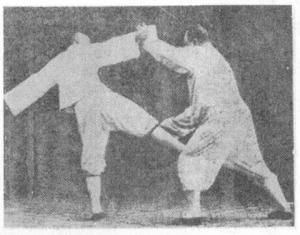
第二十三式 翻身蹬脚用法
23. Application of TURN AROUND, PRESSING KICK
如乙自後方打來速退去,甲翻身見乙往囘退,甲左脚先進一步,隨飛起右脚直踢乙胸前,甲手要分開,如圖是也。
If B attacks from the rear and quickly retreats, A turns around to observe B’s retreat, then first advances with his left foot, and then quickly lifts his right foot to do a straight kick to B’s chest while his hands spread apart. See the photo:
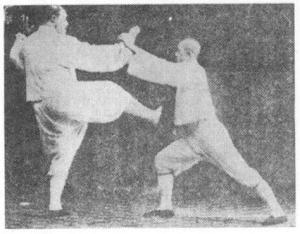
第二十四式 右轉身蹬脚用法
24. Application of TURN TO THE RIGHT, PRESSING KICK
如甲坐伏式乙猛撲來,甲亦用雙手左右分開乙手,起右脚直踢乙腹上,如蹬人不可用勁,如圖是也。
If B fiercely attacks while A is in a crouching posture, A spreads both hands to counter B’s hand, lifting his right foot to do a straight kick to B’s belly. When you do a pressing kick to someone, you must not use force. See the photo:
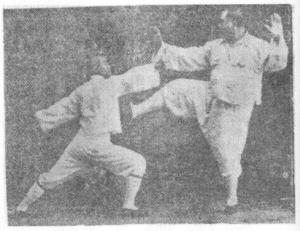
注意 以上自分脚腿用時每式總叙一句,每式雙手如翅飛稱勁,脚須立好為必要。
Make note that the above kicking techniques are to be performed as single actions, that in each case the hands spread like wings, and that it is necessary for the standing foot to be stable.
第二十五式 雙風貫耳用法
25. Application of DOUBLE WINDS THROUGH THE EARS
如乙用雙拳自前打,甲隨涵胸起雙拳,由左右外方繞經上方轉裏對打乙两耳處,右足在前,左足在後,如圖是也。
If B uses both fists to strike from in front, A then hollows his chest and raises both fists, turning them from both sides upward and inward to strike B’s ears, his right leg forward, left leg behind. See the photo:

第二十六式 左右打虎用法
26. Application of FIGHTING TIGER POSTURE – LEFT & RIGHT
如甲乙二人靠右手時,甲左手扣住乙右手腕上按下,舉右拳要打乙項,為右打虎式,右足弓式,左足蹬直,如甲右手扣住乙左手腕,甲舉左拳要打乙項,左足弓式,右足為直線,為左打虎式,此右圖是也。
If A and B cross their right hands and A’s left hand covers B’s right wrist and pushes down, he lifts his right fist to strike to B’s head. This is the posture on the right side, A’s right leg bending and left leg straightening. If A’s right hand covers B’s left wrist, he lifts his left fist to strike to B’s head. A’s left leg bending and right leg straightening, this is the posture on the left side. See the photo [of the right side]:

第二十七式 野馬分鬃用法
27. Application of WILD HORSE VEERS ITS MANE
甲乙對立如乙右拳打來,甲速進右步,乙拳未落之時,甲右手腕抬起掤乙膀根處,往斜上方用勁,左足在後直線,左手随左腿亦可,左手押乙右掌亦可,如圖是也。
A and B stand opposite each other. If B strikes with his right fist, A quickly advances his right foot, and before B’s fist has landed, A’s right wrist lifts to ward off B’s arm, applying power diagonally upward. A’s left leg is straightening behind, and his left hand can follow it to the rear or can press down on B’s right palm. See the photo:

如甲乙對立乙起左手打來甲亦用左脚進一步乙手未落時即抬左手掤乙右膀根處向上方掤去右足蹬勁將乙扔倒
If when A and B face each other, B lifts his left hand to strike, A advances his left foot, and before B’s hand has landed, lifts his left hand to ward off B’s right arm upward and away, his right foot pressing behind, causing B to fall away.
第二十八式 左邊玉女穿梭用法
28. Application of MAIDEN WORKS THE SHUTTLES – LEFT
如甲立乙自右前斜方打拳甲速換式當左足向前一步左手架乙膊甲右掌對乙打去右足在後蹬直如圖是也
If B strikes with his [right] fist from A’s left forward corner, A quickly adjusts his posture by stepping his left foot forward and propping up B’s forearm with his left hand, striking toward B with his right palm, while his right leg behind presses straight. See the photo:
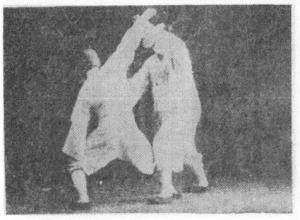
第二十九式 右玉女穿梭用法
28. Application of MAIDEN WORKS THE SHUTTLES – RIGHT
如前式乙自後方打來甲向右方往後轉,右手掤上與身同時轉過,接乙右肘下往上掤起,然後用左掌推乙脅上,右足弓式,左足蹬直如圖是也。
Continuing from the previous posture, if B comes from behind A to strike him, A turns around to his right, warding off upward with his right hand while his body turns, connecting below B’s right elbow with a ward-off lifting up, then uses his left palm to push B’s flank, his right leg bending and left leg pressing straight. See the photo:

穿梭四個有左右不多叙。
Although this technique happens four times, the remainder does not need further description.
第三十式 單下式金鷄獨立用法
30. Application of SINGLE WHIP LOW POSTURE, GOLDEN ROOSTER STANDS ON ONE LEG
如甲單鞭下式乙自前打來,甲起身抬左手至前往上托乙膊右膝蓋隨手起時曲膝直頂乙小腹左足立直微曲如金鷄獨立是也,起左手,起右手,均可隨人所作,或用脚,或用膝,勿拘。
If B strikes forward while A is in a SINGLE WHIP LOW POSTURE, A lifts his body and raises his left hand forward and upward to prop up B’s arm, his right knee going along with it by bending and crashing into B’s lower abdomen. He stands on his left leg, slightly bent, in the manner of a rooster standing on one leg. Either hand may lift depending on what the opponent does, and you can use either your foot or your knee. [See the photo:]

第三十一式 左邊金鷄獨立用法
31. Application of GOLDEN ROOSTER STANDS ON ONE LEG – LEFT
如上式乙用左手以直打來,甲速換式,金鷄獨立抬起左手曲直隔開乙手,甲同時左腿抬至曲膝用足尖踢乙小腹處,如左邊立式圖也,
From the previous posture, if B does a straight strike with his left hand, A quickly changes sides, lifting his left hand with the arm bent to block B’s hand upward. At the same time, his left leg lifts and bends at the knee to kick B’s lower abdomen with his toes. See the photo:
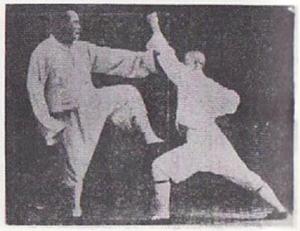
使法與練法不同。
This method of application and the method of practice are different [i.e. kick instead of knee].
第三十二式 迎面掌用法
32. Application of PALM STRIKE TO THE FACE
甲如高探馬式,左手扣乙左手腕,如乙用力上挑甲隨將前右手囘按乙膊往囘領勁,使乙前伏,同時左掌心向上由元處直搠乙面門,左足前進半步,右足後為直線,如圖是也。
If A is in the posture of RISING UP AND REACHING OUT TO THE HORSE with his left hand covering B’s left wrist, and B uses strength to carry upward, A then withdraws his right hand in front to push down and lead in B’s arm, causing him to lean forward. At the same time, A’s left hand, palm facing upward, thrusts directly toward B’s face, left foot advancing a half step, right leg straightening behind. See the photo:

第三十三式 摟膝指襠錘用法
33. Application of BRUSH KNEE, PUNCH TO THE CROTCH
如甲立式乙自前用拳直打,或用右足踢來,甲可用左手摟過膝外方,用右拳往前下方直打乙丹田氣海處,此為指襠錘,如圖是也。
If B uses his fist to strike straight forward, or uses his right foot to kick, A can use his left hand to brush it outward past his knee and apply his right fist forward and downward to strike B’s elixir field or energy sea. This is the PUNCH TO THE CROTCH. See the photo:

第三十四式 上步七星用法
34. Application of STEP FORWARD WITH THE BIG DIPPER
甲立式乙用右手直打來甲用左單鞭式在乙肱上往下沉如乙囘抽手時甲隨時用右手自己肱下打出為上步七星錘,右足上步為虛式,左足為實,如圖是也。
B uses his right hand to do a straight strike. A uses his left SINGLE WHIP posture to sink down B’s forearm. When B pulls back his hand, A seizes the moment and applies his right hand under his own forearm to strike, stepping forward to punch with a Big Dipper shape, his right foot stepping forward into an empty stance, his left foot full. See the photo:

第三十五式 退步跨虎用法
35. Application of RETREAT TO SITTING TIGER POSTURE
甲如前式,乙雙手自左右两方一齊來打,甲將前右足抽囘為實,左足虛式,甲同時亦將雙手左右分開,當住乙雙手此為開勁跨虎,如圖是也。
From the previous posture, both of B’s hands strike in unison from the sides. A withdraws his right foot and sits full on it, his left foot now in an empty stance. At the same time, he spreads both hands to the sides to stop B’s hands. This is the spreading energy of the SITTING TIGER POSTURE. See the photo:

第三十六式 轉脚擺蓮用法
36. Application of SPIN AROUND ON THE FOOT, SWINGING LOTUS KICK
如乙用左拳打來,甲用雙手右在前,左在後,按乙膊用捋法往左邊採勁,甲同時飛右腿揚打乙胸,左足千萬立實,如圖是也。
If B uses his left fist to strike, A uses both hands, right hand in front and left hand behind, to push on B’s arm and apply a plucking technique to the left side. At the same time, A suddenly swings his right leg up to strike B’s chest, the left leg completely stable. See the photo:
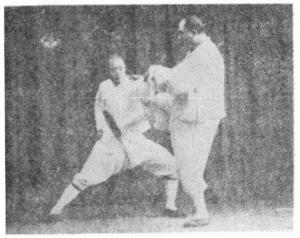
倘敵自後打用轉身擺連腿亦好
If the opponent strikes from behind, applying this technique is also good.
第三十七式 彎弓射虎用法
37. Application of BEND THE BOW TO SHOOT THE TIGER
如乙右掌打來勁大,甲隨用右手靠接住,同時左掌拂乙右肘,可用提勁往右高處粘提,將乙足根領活,然後甲用按勁向斜下打去,此是提高之圖是也。
If B’s right palm strikes with great force, A then uses his right hand to connect with it, at the same time his left palm touching B’s right elbow. He can use lifting energy to stick and lift to the upper right, leading B’s heels to unroot, then uses pushing energy diagonally downward to hit him away. This [the lifting] is exaggerated in the photo:

–
太極用法秘訣
THE TRICK TO APPLYING TAIJI
擎,引,鬆,放,
“Raise, draw in, relax, and release.” [words from Li Yiyu]
敷,蓋,對,呑,
“Spread, cover, match, and engulf.” [from Wu Yuxiang]
以上三十七圖皆使用要法同志不可以為浮言雖然解明與人對敵時亦許手法少易方向不可泥撮影至于千變萬化隨機應敵之時一手可變五手筆難形容同志須細心研究揣摸為要蓋不離掤捋擠按採挒肘靠八法進退顧盼定五行也
Using the above thirty-seven photos, all the applications will have a standard model for you. You must not think their words hollow, and although they are explained clearly, techniques should be few and simple when dealing with opponents, and the directions you turn toward not leave you grasping at shadows. When you are changing endlessly in going along with the situation, one technique can turn into five techniques, and that would be difficult to describe in writing. Fellow practitioners, you must carefully study and ponder over what is essential, that being that you are not to depart from the eight techniques of ward-off, rollback, press, push, pluck, rend, elbow, and bump, nor the five steppings of advance, retreat, left, right, and center.
–
王宗岳遺論解明
EXPLANATIONS TO WANG ZONGYUE’S TREATISE
太極者無極而生陰陽之母也
Taiji is born of wuji, and is the mother of yin and yang.
注意實行解說非作文章也
(Pay attention during your practice, for these explanations are not meant merely to be an essay.)
不動為無極,已動為太極,空氣磨動而生太極遂分陰陽,故練太極先講陰陽,而內包羅萬象,相生相克由此而變化矣,太極本無極生,而陰陽之母也。
When there is no movement, there is no [wu] polarity [ji]. Once there is movement, there is the Grand [tai] Polarity [ji]. From the state of emptiness, energy is awakened, generating taiji, which then divides into the passive and active aspects [yin / yang]. Thus for practicing Taiji, the first thing to talk about is passive and active, because they cover everything. The way they cause each other and overcome each other is the source of all forms of change. Taiji is originally generated from wuji, then is the mother of yin and yang.
動之則分靜之則合
When there is movement, the passive and active aspects become distinct from each other. When there is stillness, they return to being indistinguishable.
練太極,心意一動則分發四肢,太極生两儀四象八卦九宮,即掤捋擠按採挒肘靠進退顧盼定,靜本還無極心神合一,滿身空空洞洞,少有接觸即知。
In the practice of Taiji, when the mind moves, it expresses into the limbs. The Grand Polarity [tai ji] generates the two polarities, which lead to the four manifestations, the eight trigrams, and the nine palaces. These correspond to [the eight:] ward-off, rollback, press, push, pluck, rend, elbow, and bump, as well as [the four:] advancing and retreating, stepping left and right, and [the central of the nine:] staying put in the center. When there is stillness, there is return to the wuji state, in which mind and spirit merge, the entire body becomes an emptiness, and you become sensitive to the smallest contact.
無過不及隨曲就伸
Neither going too far nor not far enough, comply and bend then engage and extend.
無論練拳對敵無過不及,過逾也,不及未到也,過與不及皆失中心點,如敵來攻順化為曲,曲者灣也,如敵攻未呈欲退,我隨彼退時就伸,伸者出手發勁也,過有頂之敝,不及為丢,不能隨曲為抗,不能就伸為之離,謹記丢頂抗離四字,如功能不即不離,方能隨手凑巧。
Be it practicing the solo set or dealing with opponents, neither go too far nor not far enough. Too far means you are going beyond. Not far enough means you are not arriving. In either case, you are becoming uncentered. If the opponent attacks, bend to go along with it and neutralize it. Bending means curving. If the opponent attacks and does not yet want to retreat, I go along with him and then when he retreats I extend. Extending means to send out the hand and issue power. Going too far is the mistake of crashing in. Not going far enough is the mistake of running away. If you cannot comply and bend, you are resisting. If you cannot engage and extend, you are separating. Sincerely take note of these four terms: running away, crashing in, resisting, and separating. If in your practice you can keep yourself from reaching or separating, then you will easily become skillful.
人剛我柔為之走我順人背為之黏
He is hard while I am soft – this is yielding. My energy is smooth while his energy is coarse – this is sticking.
比如二人對敵,人力剛直,我用柔軟之手搭上敵之剛直上,如皮鞭打物然實實搭在他勁上,他相摔開甚難,他交就是膠皮帶纏住他能放能長,如他用大力,我隨粘他手腕往後坐身,手同時不離往懷收轉半個圈為之走化也,向他左方伸手使敵身側不得力,我為順,人為背,黏他不能走脫矣,昔有一軼事,有不法和尚善頭者,與一人較,人知其用羊觝頭之法無敵焉,甚懼,其人見和尚新剃頭,忽想一法,去屋用濕毛巾一條仿焉,和尚施其法,此人用濕毛巾摔搭頭上往下一拉,和尚隨倒,是即以柔克剛之理也。
When dealing with an opponent, if his power is hard and determined, I apply softness and pliancy to my hand and drape it over his hard attack. It is like a whip striking something but is actually draping onto his energy, and if he wants to cast it aside it will be very difficult for him to do. Once we contact, it is as though a belt of rubber wraps around him, tying back his capacity to express power or extend his arm. If he applies a lot of force, I then stick to his [right] wrist and sit to the rear, and without breaking contact I draw him toward my chest and turn a half circle to yield and neutralize, then extend my hand toward his left to turn him sideways and cut off his access to his power. With my energy smooth and his energy now coarse, I stick to him and he cannot get away.
In an old anecdote, a rude monk who was skillful with his head came to compete with a man. The man knew the monk’s butting-ram’s-head technique was undefeated and was very afraid of him. But then he saw the monk’s head had just been shaved and suddenly got an idea. He came out of his house using a wet towel. When the monk executed his technique, the man threw the towel over the monk’s head and pulled down, toppling him. This is the principle of softness subduing hardness.
動急則急應動緩則緩隨
If he moves fast, I quickly respond, and if his movement is slow, I leisurely follow.
今同志知其柔化,不知急應之法,恐難與外功對敵,急快也,緩慢也,如敵來緩則柔化跟隨此理皆明,如敵來甚速柔化烏能取哉,則用太極截勁之法,不後不先之理以應敵,何為截勁,如行兵埋伏突出截擊之,何為不後不先,如敵手已發未到之際,我手截入敵膊未直之時,一發即去,此為迎頭痛擊,動急則急應此非眞傳不可。
You practitioners these days know how to soften and neutralize but you do not know how to quickly respond, and so you will probably have a hard time dealing with opponents from the external school. Quickly means fast. Leisurely means slow. If the opponent attacks slowly, then soften, neutralize, and follow him. This principle makes sense to you all. But if he attacks very fast, what good would softening and neutralizing be? Thus I apply Taiji’s intercepting energy and the principle of “neither after nor before” as a response. What is the intercepting energy? It is like a hiding army suddenly coming out to strike. What does neither after nor before mean? If his hand is on its way but not yet arrived, my hand intercepts his arm before it has straightened, promptly dispelling his attack. This is defeating a frontal assault by way of a frontal assault. “If he moves fast, I quickly respond.” If you do not have the authentic teachings, this cannot be done.
雖變化萬端而理為一貫
Although there is an endless variety of possible scenarios, there is only one theory throughout.
與人對敵,如推手或散手,無論何着數,有大圈,小圈,半個圈,陰陽之奧妙,步法之虛實,太極之陰陽魚,不丢頂之理,循環不息,變化不同,太極之理則一也。
When facing an opponent, be it either pushing hands or sparring, and regardless of the technique, in each case there are these things:
– large circles, small circles, and half circles,
– the subtleties of passive and active,
– emptiness and fullness in the footwork,
– the passive and active fishes swimming in the taiji symbol,
– the principle of neither pulling away nor crashing in,
– and cycling on and on without pause.
The variations are different, but the Taiji theory is the same.
由着而漸悟懂勁由懂勁而階及神明然非用力之久不能豁然貫通焉
Once you have engrained these techniques, you will gradually come to identify energies, and then from there you will work your way toward something miraculous. But unless you practice a lot over a long time, you will never have a breakthrough.
着者拳式也,今同志專悟懂勁,故不能發人,先學姿勢正確,次要熟練,漸學懂勁,古人云,不揣其本而其齊其末,方寸之木,可使高於岑樓,此句先求姿勢後悟懂勁,不難而及神明,神明言拳精巧,豁然貫通,即領悟得拳奧妙,能氣行如九曲珠太極理通焉,非久練久熟,何能及此境耶。
By techniques is meant the postures in the solo set. Nowadays you are all focused on getting to identify energies, and as a result you are unable to send opponents away. But the first step is to learn how to do the postures right, then the next step is to practice them until you are proficient at them, and then from there you will slowly learn to identify energies. Mengzi said, “By ignoring what is fundamental and dealing only with superficialities, you can convince yourself an inch of wood is taller than a tall building.” Taking the hint from this quote, first strive with the postures and later come to identifying energies. It will then be an easier step to achieve a miraculous quality, meaning that your boxing skill has become refined.
Having a breakthrough means to realize the boxing’s subtleties. If you can move energy as though through a winding-path pearl, you understand Taiji theory. Unless you train for a long time, developing your proficiency over a long period, how can you achieve this condition?
虛靈頂勁氣沉丹田不偏不倚
Forcelessly press up your headtop. Energy sinks to the elixir field. Neither lean nor slant.
頂者頭頂也,此處道家稱為泥丸宮,素呼天門,頂勁非用力上頂,要空虛要頭容正直,精神上提,不可氣貫于頂,練久眼目光明,無有頭痛之病,丹田在臍下寸餘即小腹處,一身元氣總聚此地位,行功如氣海發源,環流四肢,氣歸丹田身與氣不偏倚,如偏倚,猶磁瓶盛水瓶歪倒,則水流出矣,丹田偏倚,則氣不能歸聚矣,此說法佛家稱舍利子,道家為練丹,如此練法氣壯多男,工久外有柔軟筋骨,內有堅實腹臟,氣充足,百病不能侵矣。
“Headtop” means the top of the head. Daoists call this place the “clay pellet palace”, but it is more commonly called the “divine gate”. The strength at the headtop is not to be pressed up with effort, it should instead be done forcelessly, and this will straighten the head. Spirit will rise up but energy must not be allowed to penetrate to the headtop. After practicing for a long time, your eyes will shine and you will be immune to headaches.
The elixir field is just over an inch below the navel. It is the lower abdomen area. All of the body’s vitality is gathered in this place. During practice, it is as though the “energy sea” [a nearby acupoint] is the fountainhead from which energy flows to the extremities. When energy is concentrated at the elixir field, the body and energy do not lean in any direction. If they lean, it is like a vase filled with water and the vase tipping over and the water flowing out. If the elixir field leans, then the energy cannot be gathered there. This explanation of the method Buddhists name after Sariputra [He was a disciple of the Buddha, and hence could be an emblem for a purified or transformed person, one who is becoming a buddha. Or the meaning here could have something to do with legends of gems found in monk’s ashes which were claimed to have been left from inside the monk’s body (perhaps adorning the corpse during cremation or added to the ashes by students to honor their master). The Chinese version of the name is Shelizi, meaning “one who gives everything away”, and is here extended from name to noun to represent either these gems or the process of internally “forging” them, as if meditation produces abdominal gems the way the earth produces diamonds.], and Daoists call it “training the elixir” [or “smelting cinnabar”, another case of an external substance attributed internally]. If you train like this, the energy will be strong and hardy, and if you train for a long time, outwardly you will have a lithe physique while internally your organs will be robust. When energy is abundant, illness will have no way in.
忽隱忽現左重則左虛右重則右杳
Suddenly hide and suddenly appear. When there is pressure on the left, the left empties. When there is pressure on the right, the right disappears. [Due to the different contexts of “empty” and “disappear”, this section is referring to facing an opponent with your right side forward and left side back.]
隱者藏也,現者露也,隱現之法,與人對敵,猶神明難測之妙,如敵來擊至我身,我身收朿為忽隱使敵不能施其力,如敵手往囘抽時,我隨跟進為忽現,敵不知我式高低上下,無法敵當我手,練太極如河中小船人步臨其上,必略偏忽隱,又裏步必隨起,忽現,猶龍之變化,能升能降,降則隱而藏形,現能飛升太虛興雲吐露,此理言太極能高低,隱現即忽有忽無之說重者不動也,與人對敵不動可乎,如用拳必以身體活動,手脚靈捷,然後可以迎敵,敵如擊我左方,我身略偏虛無可逞,擊我右方我右肩往收縮使其拳來無所着,我體靈活不可捉摸,即左重左虛,右重右杳。
To “hide” means to conceal. To “appear” means to reveal. The ways of hiding and appearing when dealing with an opponent seem so subtle as to be magically unpredictable. If the opponent comes in to strike me, I shrink in to suddenly hide, causing the opponent to be unable to make use of his power. If he then withdraws his hand, I follow him with an advance to suddenly appear. Not knowing whether my technique will go up or down, nor how high or how low, there is nothing he can oppose it with.
When practicing Taiji, it is like a little boat in a river: when a person takes a step onto it, it will slightly dip, “suddenly hiding”, and once he steps his other foot in, it will then rise, “suddenly appearing”. It is also like the changes of a dragon, which can ascend and descend: when it descends, it hides and conceals its form, and when it appears, it can ascend into the sky, manifesting as clouds. According to this principle, Taiji can be high or low. To hide and appear is to suddenly be or to suddenly not be.
Where there is pressure, there is no movement. When dealing with an opponent, how can you do it without movement? If you apply the boxing, you must be lively with your body and agile with your limbs, and then you will be able to face opponents. If an opponent strikes to my left side, I slightly turn to create an emptiness so he cannot succeed. Then when he strikes to my right side, I draw back my right shoulder, causing his fist to attack nothing. My body is quick and lively, and cannot be figured out. And so for pressure on my left, I empty on my left, and for pressure on my right, I disappear on my right.
仰之則彌高俯之則彌深進之則彌長退之則愈促
When looking up, it is still higher. When looking down, it is still lower.
仰為上,俯為下,敵欲高攻,吾即因而高之而不可及,敵欲押吾下因而降使敵失其重心,與己說,仰之彌高眼上看,心想將敵人擲上房屋,俯之彌深,想將敵人打入地內,班侯先生有軼事,六月某日在村外(即北方收糧地方)場乘凉,突來一人拱手曰,訪問班侯先生居處,答吾即楊某也,其人疾出大食中三指擊之,班侯師見場有草房七尺高,招手說朋友你上去罷將其擲上,又言請下罷速囘醫治,鄉人問曰何能擲其上,曰,仰之彌高,鄉人不解其說,北方有洛萬子從學焉,習數年欲試其技,班侯師曰將你擲出元寶式樣可乎,萬笑曰略試之,較手如言两手两脚朝天,右胯着下如元寶形,入地不能,將胯摔脫矣,醫好至今腿畧顚跛,此人拳甚好其人至今還在,常曰俯之彌深利害極矣。
[When referring to the opponent these phrases mean:]
“Looking up” means going upward. “Looking down” means going downward. If the opponent wants to attack me high, I go higher up and he cannot get to me. If he wants to catch me low, I go lower down and induce him to fall from his center.
When referring to yourself these phrases mean:
“Look up still higher” – gaze upward with your eyes and think of sending the opponent up onto a roof. “Look down still lower” – think of sending him down into the ground. Both looking up and looking down in this manner are illustrated by a couple of anecdotes about Yang Banhou:
[1] One day in July outside a village at a granary in the north, Yang was cooling off on the threshing ground when suddenly a person came up and saluted, saying, “I am looking for the home of Yang Banhou.”
Yang said, “That’s me.”
The man put out his thumb, forefinger, and middle finger in a sudden attack. Yang looked to a thatched roof in the threshing area that was seven feet high, and made an inviting gesture with his hand, saying, “Buddy, you go up there.” Having tossed him on top of it, he then said, “Please come down and hurry to a doctor.”
A villager asked, “How could you throw him up there?”
Yang said it was by “looking up still higher.”
The villager did not know what he was talking about.
[2] Yang had a student in the north named Luo Wanzi who trained for several years and wanted to test his skill. Yang said, “Do you think I can throw you away to be shaped like a gold ingot?”
Luo laughed and said, “You can try.”
They crossed hands and just as Yang had said, Luo, hands and feet pointed up and hips on the ground, was in the shape of a gold ingot. He did not go into the ground of course, which would be impossible, but his hip was dislocated. Although the doctor was good, there is still a slight limp.
Luo’s boxing became excellent. He is still alive and constantly comments that “looking down still lower” is devastating.
進之則愈長退之則愈促
When advancing, it is even farther. When retreating, it is even nearer.
長者進也,促者迫也,與人對敵時,可進不可退,伸手長勁,我手愈進愈長,不進則短,我擊敵,敵退時我進身跟步,促迫敵不能逃也,敵不逃脫我為順敵為背,可能施其機,總言之即粘連黏隨之意義矣。
“Farther” has to do with advancing forward. “Nearer” has to do with pressing in. When dealing with an opponent, if you can advance you must not retreat. Extend the hand with a long energy. The longer my technique advances, the longer the energy. If I do not advance, then I shorten the energy. I attack the opponent, and when he retreats, I advance with my body and follow with my step, pressing in close to him so he cannot get away. Not getting away from me, my energy is smooth while his energy becomes coarse, and I can make use of the opportunity. All of these words have to do with the concept of sticking and following.
一羽不能加蠅虫不能落
A feather cannot be added and a fly cannot land.
練工久感覺靈敏,稍有接觸即知,獨如一鳥毛之輕,我亦不駄,蠅虫之小亦不能着落我身,即便着落琉璃瓶內,光滑不能立足,我以化力,將蠅足分磋矣,如此可謂太極之功成矣,昔班侯先生有一軼事六月行功時,常臥樹蔭下休息,或有風吹一葉落身上不能存留,隨脫流而落地下,自常試己功,解襟仰臥榻上捻金米(即小米)少許置與臍上,聽呼一聲小米猶彈弓射彈一樣,飛射瓦屋頂相接,班侯先生之功可為及矣,同志宜為之。
Once you have worked at it for a long time, your sensitivity will be acute. When there is the smallest contact, you will be aware of it. I will not carry something as light as a feather, and something as small as a fly cannot land on me. When a fly lands inside a glass vase, the surface is too smooth for it to gain any footing, and likewise when I use neutralizing energy, making the fly’s feet slip instead of grip. At this stage you can consider your Taiji skill complete. There is an old anecdote about Yang Banhou to illustrate this:
When practicing in the peak of summer, Yang would often lie down in the shade from a tree to take a rest. One day a breeze took a leaf off and it fell onto his body, but it could not stay on him and slipped off onto the ground.
[Another anecdote:]
Yang would often measure his skill by unbuttoning his jacket and lying back on his bed with a handful of yellow grain (i.e. millet) and put a few of the grains on his navel, and then with a shout it seemed the grains had been shot from a pellet bow and flew up to hit the tile-roofed ceiling.
Yang Banhou’s skill could be considered to be at the summit and you all should emulate him.
人不知我我獨知人英雄所向無敵蓋皆由此而及也
The opponent does not understand me, only I understand him. A hero is one who encounters no opposition, and it is through this kind of method that such a condition is achieved.
與人對敵,不出有一定架式,使敵無處入手,如諸葛用兵或攻或守敵莫能預測,諺云不知我葫蘆賣的是什麼藥,敵不知我練太極有審敵之法,如搭手素熟懂勁,我手有靈動知覺,敵手稍動我早知來意,隨手凑巧以發即出,如離遠用審敵法,以望即知其動作,兵法云,知己知彼百戰百勝,英雄所向無敵,蓋皆由此而及也。
When dealing with an opponent, if you do not come out with predictable postures, you will cause him to have nowhere to get in with his techniques. It is like Zhuge Liang’s strategy of “sometimes attacking, sometimes guarding” so the opponent will be unable to anticipate you. A proverb says, “People don’t know what the medicine in my bottle is when I sell it to them.” The opponent does not know that in the Taiji I practice there are methods of examining him. If upon crossing hands with him I am good at identifying energy, my hands are nimble and sensitive. When he makes the smallest movement with his hand I already know what he is doing, so I go along with his technique to take advantage of it and skillfully send him away. But if he is at a distance from me I apply methods of examining him and use my eyes to know his movement. Sunzi said, “Knowing both self and opponent, you will win every time.” And so “a hero is one who encounters no opposition, and it is through this kind of method that such a condition is achieved”.
斯技旁門甚多雖勢有區別槪不外乎壯欺弱慢讓快耳有力讓無力手慢讓手快此皆先天自然之能非關學力而有也
There are many other schools of boxing arts besides this one. Although the postures are different between them, they generally do not go beyond the strong bullying the weak and the slow yielding to the fast. The strong beating the weak and the slow submitting to the fast are both a matter of inherent natural ability and bear no relation to skill that is learned.
雖拳類繁多,各門姿式用法不同,總而言之,蓋注重手快力大則一也,此種說法,人生就有,非學得也,各拳著名人亦甚多,但未有太極之理之精微奧妙也。
Despite the variety of boxing arts and that each school’s postures and methods of applying them are different, they are all the same in that they emphasize the hands being fast and the strength being great. In this way of going about it, a person makes use of only what he was born with rather than actually learning something. Each boxing art has its famous exponents and they are many, but none of them possess the refined subtlety of Taiji’s theory.
察四両能撥千斤之力顯非力盛
Examine the skill of “four ounces can move a thousand pounds”, which is obviously nothing to do with abundance of strength.
聖人云以力服人者,非心服也,學藝能無力打有力,手慢勝手快,以巧治敵,能使人實地心服,亦不愧學藝之苦心矣,練太極能引進落空,雖千斤力無所用矣,能靈活才有落空之妙,能引進落空,四両撥千斤之妙得矣,昔有一軼事京西有富翁莊宅如城,人稱為小府張宅,其人愛武家有鏢師三十餘人,性且好學,聞廣平府楊祿禪名著,托友武祿靑者往聘,及請至,張見其人瘦小身未五尺,面目忠厚,身衣布衣,遂招待其禮不恭,讌亦不盛,祿禪先師會意,遂自酌自飲不顧其他,張不悅曰,常聞武哥談先生盛名,不知太極能打人乎,祿禪知謙不成,遂曰有三種人不可打,張問何為三種,答曰,銅鑄的,鐵打的,木作的,此三種人不容易打,其外無論,張曰敝舍卅餘人冠者劉敎師,力能舉五百斤與戲可乎,答曰無妨一試,劉某來式猛如泰山,拳風颼聲,臨近,祿禪以右手引其落空,以左手拍之,其人跌出三丈外,張撫拳笑曰,先生眞神技矣,遂使厨夫,從新換滿漢盛讌,恭敬如師,劉力為牛,不巧安能敵手,由此知彼顯非力盛,之能為功也。
A wise man [Mengzi – Mengzi, chapter 2a] said: “You can conquer people with force but it doesn’t change their minds.” Learning the art of being able to defeat strength without strength, of defeating speed with slowness, and of using skill to manipulate the opponent, you can indeed cause him to change his mind, and you will feel all the hard work you put into to learning it was worthwhile. By practicing Taiji, you can draw the opponent in to land on nothing, and then even a thousand pounds of force will be useless to him. If you can be nimble, you will then possess the subtlety of landing his attacks on nothing. If you can draw him in to land on nothing, you will then obtain the subtlety of four ounces moving a thousand pounds. To illustrate, here is an old anecdote [about Yang Luchan]:
In the western part of Beijing there was a rich man whose mansion was like a whole town and people nicknamed it “the mini-prefecture of Zhang’s house”. He was a huge fan of martial arts, keeping more than thirty bodyguards in his home, and he also adored learning it himself. So when he heard of the famous practitioner Yang Luchan of Guangping prefecture, he sent his friend Wu Luching to go invite him to the mansion.
When the request had brought Yang to him, Zhang saw he was a thin little man, hardly even five feet tall, with a naive-looking face, and wearing the clothes of commoners. Zhang thus received him with a discourteous manner and gave him a banquet that was by no means grand. Yang took the hint and correspondingly poured his own wine to drink on his own and ignored everyone.
This in turn annoyed Zhang, who then said, “Often have I heard my martial brothers here gossiping about your great reputation, but I wonder if Taiji can actually be used in a fight with anyone.”
Aware that modesty would not convince him otherwise, Yang said, “It is useless in a fight against three kinds of people.”
Zhang asked, “And what are they?”
Yang answered, “People made of bronze, iron, or wood. They’re hard to fight with. But the rest are easy.”
Zhang said, “Well, in my house there’s more than thirty. Teacher Liu is the best among them. His strength can lift five hundred pounds. Could you show us with him?”
Yang replied, “Might as well give it a try.”
Liu fiercely attacked, bearing down on Yang like a mountain, with his fists whooshing like the wind. As Liu closed in, Yang used his right hand to draw in the attack to land on nothing and with his left hand made a slap. Liu stumbled away more than thirty feet.
Zhang saluted, smiling, and said, “You truly have a magical skill.” Then he called for his cooks to start over and give a real banquet, replacing Manchurian dishes for proper Chinese ones, and respected Yang as a master.
Liu had the strength of an ox, but not having skill he could be no opposition. The phrase “obviously nothing to do with abundance of strength” will now make sense.
觀耄耋能禦衆之形快何能為
Or consider the sight of an old man repelling a group, which could not come from an aggressive speed.
七八十歲為耄耋,能禦衆人,指練拳言,不練拳,即年壯,敵一二人難矣,用功人自學拳日起,至老未脫功夫,日久筋骨內壯,氣血充足,故七八十歲能敵衆人,猶戰定軍山老黃忠言,人老馬不老,馬老刀不老,其言甚壯,練太極拳人老精神不老,能敵多人,槪此意也,昔建侯太師遺事,有日天雨初晴,院泥水中一小路,可容一人行,門生趙某立其間觀天,不知老先生自屋出,行趙後焉,欲為戲伸右膊輕輕押趙右肩上,趙某覺似大樑押肩,身灣曲側坐,移出路,老先生笑而不言,行出,又一日足立院中言與衆捕為戲,有門生八九人齊擁上來,見老先生幾个轉身,衆人齊跌出,有丈餘的亦有八九尺遠的,老先生年近八十,耄耋禦衆,非妄言也,快何能為,此快字言無着數之快謂之忙亂,忙亂之快無所用矣,非快不好,快而有法然後可用矣。
Seventy years old, eighty years old – that is an old man. If he can repel a group, this shows he has trained in the boxing. One who does not train, though he be robust of youth, has a hard time dealing with even one or two opponents. A studious person who continues his training until old age without a break will over time have developed a hearty physique and good circulation, and thus that seventy or eighty year old man will be able to repel a crowd. It is like at the battle of Mt. Dingjun, when the old general Huang Zhong said, “Though a man be old, his horse is not old, and even if his horse is old, his saber is not old.” These are very potent words, for when you practice Taiji Boxing, your body may age but your spirit will not age, and you will be able to match a large number. This is the general idea here, and to illustrate, here are a couple of old anecdotes about Yang Jianhou:
One day it had been raining and the sky was starting to clear up. The muddy water in the courtyard had a little path in it that would admit one person to walk along at a time. One of Yang’s disciples, Zhao, stopped in the middle of the path to observe the sky. But he had not noticed that Yang had come out of the house and was walking along the path right behind him, and so Yang felt like playing a prank on him. He extended his right arm and gently pressed down on Zhao’s right shoulder. Zhao felt like a huge roof beam was crushing his shoulder, so his body bent sideways and he sat down out of the dry path. Yang laughed but made no comment and continued along the path.
Another occasion, Yang stood in the middle of the courtyard and, just for fun, told his group of pupils to seize him. There were eight or nine of them and together they swarmed in upon him. They then saw him twist his body a few times and they all went stumbling away eight, nine, ten feet or more. As he was nearly eighty years old then, it makes “an old man repelling a group” no exaggeration.
“Could not come from an aggressive speed” means an uncalculating kind of speed which would be better termed as haste. When speed is rushed and disordered, it is useless. It is not good to lack speed, but speed needs technique for it to be of any use.
立如平凖活似車輪
Stand like a scale. Move like a wheel.
立如平凖,即立身中立不偏,方能支撑八面,即乾坤坎離巽震兌艮即四正四斜方向也,活似車輪言氣循環不息,古人云得其環中以應無窮,腰如車軸四肢如車輪,如腰不能作車軸,四肢不能動轉,自己想使車軸轉,可多澆油腰軸油滿方好,同志細細體會,自得之,勿須敎也。
Standing like a scale means the body stands centered and not leaning. You will then be able to brace in all directions, like you are at the center of the eight trigrams. To move like a wheel means that the energy circles without interruption. An ancient man [Zhuangzi] said: “Occupy the center of the circle to respond without limitations.” With the waist like an axle, the limbs are moved like a wheel. If the waist cannot be an axle, the limbs cannot be turned like a wheel. If you want to get the axle to turn, you can loosen your waist to oil the axle, the slipperier the better. You will learn this through experience and obtain it yourself, so I need not be instructing you here.
偏沉則隨雙重則滯
If you drop one side, you can move. If you have equal pressure on both sides, you will be stuck.
前說有車輪之比,猶如用一脚蹬輪偏,自然隨之而下,何為雙重猶如右脚蹬上右方,左脚蹬上左方,两力平均自滯而不轉動,此理甚明,勿須細說。
Building on the wheel analogy, if you use a foot to press down one side of a wheel, it will automatically move with the wheel and slip down off of it. To “have equal pressure on both sides” is, according to this analogy, like the right foot pressing down on the right side of the wheel while the left foot is pressing down on the left side of the wheel. With equal force on both sides the wheel is jammed up and does not move. Now that this principle is quite clear, I need not go into further detail about it.
每見數年純功不能運化者率皆自為人制雙重之病未悟耳
We often see one who has practiced hard for many years yet is unable to perform any neutralizations and is generally under the opponent’s control, and the issue here is that this error of double pressure has not yet been understood.
最淺解說,同志得許多宜處,譬如有幾人練太極日日用功五六年,與人較反被敵制,同志問曰你用功五六年可為純工矣,何其不勝,請表演十三式觀之,見其練法騎馬坐襠握拳恕目咬牙,力大如牛,氣也未敢出,此為雙重練法,同志笑曰,專駕未悟雙重之病耳,又一人曰,我不用力練五六年,為何連十歲頑童也打不倒,同志請其演十三式,見其練法毫不着力,浮如鵝毛,手足未敢伸,眼亦未敢開大,同志笑曰,尊駕為雙浮悞矣,雙重為病,雙浮亦為病,衆笑曰,却實練法何能得之。
The simplest explanations will get you the most.
There were several students who practiced Taiji every day for five years or so but always ended up getting controlled by opponents.
The instructor asked, “You guys have been working at this for five years or so and it could be said that you’ve worked hard, so why do you lose? Please demonstrate the solo set and I’ll take a look.” The instructor saw that they were forcing their stances to be too deep, squeezing their fists too tight, glaring fiercely with their eyes, and clenching their jaws. Although they were strong as oxes, this was preventing their energy from expressing. This manner of training is “double pressure”. The instructor laughed and told them, “You have not understood the error of double pressure.”
Another student then said, “I’ve been working at not using exertion for five years or so, and why can’t I even defeat a ten year old boy?”
So the instructor asked him to demonstrate the solo set too, and saw that he had no strength and was floating like goose feathers, too timid to extend his hands and feet or even fully open his eyes. The instructor laughed and told him, “You are making the error of double vacuum. Just as double pressure is an error, so too is double vacuum.”
Everyone laughed and said, “Sheesh, can we ever get it right?”
預避此病
If you want to avoid this error,…
雙重雙浮之病,預避此病,現今易耳,有此拳書容易知之,此書閱法先閱一遍,拳理甚多,不能一閱就全懂,日後可練十日拳閱一日書,慢慢此書功效大著矣。如有一節悟明料難,可問高明老師可也。
This means the error of double pressure, implying also the corresponding error of double vacuum. If you have been wanting to fix these errors, it is finally easy to do so, because this book makes it easier for you to understand them. When reading through the book the first time, it contains so many principles you will not be able to grasp it all in that single reading. So practice every day, reading through the book once a week, and gradually its contents will have a marked effect. If you come across a section of the material that is difficult for you to understand, you can ask a knowledgeable teacher for help in making sense of it.
須知陰陽粘即是走走即是粘陰不離陽陽不離陰陰陽相濟方為懂勁
… you must understand passive and active. In sticking there is yielding and in yielding there is sticking. The active does not depart from the passive and the passive does not depart from the active, for the passive and active exchange roles. Once you have this understanding, you will be identifying energies.
陰陽即虛實,總而言之,粘連走化懂敵之來勁,前解甚多不必多叙。
Passive and active means empty and full. It all comes down to: stick and connect, yield and neutralize, and identify the opponent’s energies of attack. Each of these concepts have been explained earlier, so it is not necessary to waffle on about them again here.
懂勁後愈練愈精默識揣摩漸至從心所欲
Once you are identifying energies, then the more you practice, the more efficient your skill will be, and by absorbing through experience and by constantly contemplating, gradually you will reach the point that you can do whatever you want.
能懂敵之來勁,加以日日習練即久練久熟之意,揣摩就是悟想老師敎的使用法,極熟,出手心想即至,從心所欲得之矣。
Once you are able to identify the opponent’s attacking energies, make it a part of your daily practice, for the training and the skill that comes from it takes a long time. Constant contemplation means to have your mind on Yang’s applications when practicing the movements. When you are very skilled at them, the techniques will happen as you will them and you will have obtained the ability to do whatever you want.
本是捨己從人
The basic of basics is to forget about your plans and simply respond to the opponent.
與敵對手,知要隨人所動,不要自動,吾師澄甫先生常言由己則滯,從人則活,能從人便得落空之妙,由己不能由己,能從人就能由己,此理極確實,極奧妙,同志功夫練不到此地位,恐不易知耳,此說極明顯,佛經云,我說牛頭有角,即明顯之意也。
When dealing with an opponent, understand that you should act according to his movements and should not act from yourself. Yang Chengfu often says, “Acting from yourself gets you stuck. Following the opponent keeps you free to move.” If you can follow the opponent, you will then obtain the subtlety of getting his attacks to land on nothing. If you try to act from yourself, you will not even be able to act from yourself. You can only act from yourself in the context of following the opponent. This principle is very true but very subtle, and if you do not achieve this condition through your own practice, I fear it will not be easy to understand. These words are very clear, but it as the Buddhist sutras say, “I say a bull’s head has horns”, indicating obviousness. [The meaning amounts to this: “There is nothing more I can do to demonstrate the truth of the bull’s head having horns than by stating it, and if you cannot then see it to be the case, you are not looking at the bull. Relating to your practice, you will understand the theory if you practice, but if you do not practice, it will not matter how much I explain it.”]
多誤捨近求遠所謂差之釐毫謬逾千里學者不可不詳辨焉是為論
We often make the mistake of ignoring what is right in front of us in favor of something that has nothing to do with our immediate circumstances. For such situations it is said: “Miss by an inch, lose by a mile.” You must understand all this clearly. That is why it has been written down for you.
與敵對手,多是不用近,而用遠,靜以待動,機到即發為近,出手慌忙,上下尋處擊敵為遠,太極之巧,分寸之大,釐毫之小,所以不可差也,如差釐毫,如千里之遠,練拳對手同志不可不注意焉,此先師王宗岳傳太極拳之要論。
When dealing with opponents, people often do not make use of what is right in front of them and instead apply techniques that have no relation to what is going on. When you patiently wait for his actions and express power when the moment is right, you are paying close attention to the situation. When your hands are hurrying all over the place up and down in search of a spot to strike him, you are doing something that has nothing to do with the situation. The area in which Taiji techniques operate is maybe the width of a hair and widens to perhaps no bigger than an inch, and so there is not much of a window for miscalculation. If you are wrong by a hair, you might as well be a thousand miles away. Whether practicing the solo set or working with a partner, you must always keep this in mind.
This essay is the essential Taiji Boxing theory passed down from Wang Zongyue.
–
論太極
DISCOURSES ON TAIJI
審敵法
WAYS OF EXAMINING OPPONENTS
與人對敵先觀其體格大小,如身體大必有莽力,我以巧應之,如其身體瘦小必巧,我以力攻之,此為遇弱者力取,遇强者智取,無論其人大小,如彼高式,我可以低式,如彼低式,我可以高式,此為高低陰陽之法也。
When facing an opponent, the first thing to notice is whether his build is large or small. If large, he is surely very strong, and so I will use skill as the appropriate answer to it. If small, he is surely skillful, and so I will vigorously attack. This is the defeating of weakness by way of strength and the defeating of strength by way of strategy. Whether he is large or small, when his posture is high I should use a low posture, and when his posture is low I should use a high posture. This is the way of high and low, of passive and active.
欲觀敵力之動作先觀其眼目情形,次觀其身手,如敵想用打拳,先觀其肩尖必凸起或觀其後撤如敵欲用脚蹬,其身必先昃,理之所在以定情形,如能先知,何其不勝,如敵喜色交手,我以柔化之,如敵怒目突來其心不善我用力十分擊之,此為出乎爾者,反乎爾者,望敵無怨,練太極人先禮後兵。
If you want to see what the opponent is up to, look first at what is going on in his eyes and then at his body and hands. If he wants to use his fists to strike, you will first see his shoulder stick up or see him cock his punch. If he wants to use his foot to kick, his body will first lean to the side. The signs are there with which to be sure of the situation. If you can know ahead of time what he is going to do, how can you lose?
If the opponent crosses hands with me in a pleasant manner, I use softness and neutralize him. But if he glares at me angrily and suddenly charges, his heart is not kind and I will apply power to strike him full on. This is the situation of tit for tat. Looking upon the opponent with no enmity, one who practices Taiji is polite at first and is martial only as a second line of defense.
與人對敵出乎快慢不等,如敵手慢我使沾連黏隨手,如敵手快亂打,我心要靜,胆要壯,觀其最後來近之手,我專注一方或左右化之而還擊,常言不慌不忙順手牽羊,為太極動急則急應,動緩則緩隨之理。
When dealing with opponents, some opponents are fast and others are slow. If he is slow, I am caused to stick to him and go along with his movement. If he is fast and throws out a flurry of blows, I should stay calm and keep my courage up. Watching for his decisive attack to get near, I focus along one direction or neutralize to either side, then strike back. It is often said: “Be not flustered or hasty, for it is the gentle hand that guides the goat.” It is this Taiji principle: “If he moves fast, I quickly respond, and if his movement is slow, I leisurely follow”.
與人對敵其法不一,如敵來近,上搭手下進步,走即粘,粘即走,如敵竄躍為能不敢來近,我以十三式擇一式等之,不要遂其竄躍,如虎待鹿之理,敵為卦外之行走,我為太極之中點,我主靜穩也,敵主動燥也,燥火上升而不能忍,十分鐘定來攻擊,此為相生相克,敵不難而入內圈矣,此太極生两儀四象八卦定而不可移也。
When dealing with opponents, the methods of opponents will vary. When the opponent comes in, bring your hand up to cross him above and step forward to crowd him below, yielding by sticking and sticking by yielding. If the opponent jumps away and is too wary to come back right away, I switch to a different posture from the solo set and wait for him. I should not pursue his retreat but instead be like a tiger waiting for its chance to pounce on a deer. While he walks at circle’s edge, I am at the center. I hold to steadiness while he holds to restlessness. When his restlessness increases until he wears himself out, I attack him with full stability. He has thus generated the means for me to overcome him, and he now presents no difficulty and I enter through his guard. This is the Grand Polarity [tai ji] generating its two polarities which exponentiate into the four manifestations and the eight trigrams while itself remaining stable and immovable.
太極用功法有三,分天盤,人盤,地盤,先練順,次練勁,後練巧,先開展,後緊凑,如此練法然後可用矣。
The Taiji training method has three levels: sky, mankind, ground. The first step is to practice it until it is smooth, the next step to practice it until it is powerful, the final step to practice it until it is skillful. Begin with the gross movement, then later, the finer details. If you train in this way, you will then be able to apply it.
此書解說許多笑談,以助同志習拳之精神,文字雖粗拳理實傳,其談雖笑,其事却然,非敢荒言以欺諸君也,同志按書練習得其道矣。
In this volume, the explanations are often told in a lighthearted manner to help you get to the boxing’s essence. The writing may be crude but the boxing theory is true in its transmission. Although the text is sometimes frivolous, the content is authentic. We do not dare to use exaggerations to deceive you all. By practicing according to this book, you will obtain the method.
評論
A COMMENT
有人言文武當老師,其傳必留一手不傳,我言之則不然,無論學文學武,有朋友學,有門生學,两說,為朋友久而能敬,為門生百年不忘師傅,無論文武為師,不盡心相授,是無天理,惟練武人以義氣當先,未盡所學半途而廢,如說為師不肯盡授,留一手之說,其理甚怪。論太極不在外形之姿式全在內理勁與氣耳理通之後自悟神而化之可成全功
There are people who say that teachers of either civic arts or martial arts inevitably keep something back and do not teach everything. I say this is not the case. Regardless of civic or martial, be it friends or students who are learning, there are two things to be said: a long friendship will generate esteem for the teacher, and a student will for his whole life not forget his guru. Regardless of civic or martial, for a teacher not to do his best to pass on his knowledge would be unnatural. It is down to the martial arts practitioners who, having started with putting such a premium on loyalty, go only halfway and then quit. To say in such a case that it is a matter of the teacher being unwilling to teach everything and is keeping something back is a rather odd notion. In regard to Taiji, it is not a matter of the external postures, it lies entirely within the theory of power and energy. Once you have understood the theory, from realization comes the spiritual and the transformative. Then you can say the whole achievement has been attained.
[EARLY WRITINGS]
(一)八門五步
[1] THE EIGHT GATES & FIVE STEPS – PART 1
方位 八門
position / gate:
掤 南 坎
warding off – S / ☵
捋 西 離
rolling back – W / ☲
擠 東 兌
pressing – E / ☱
按 北 震
pushing – N / ☳
採 西北 巽
plucking – NW / ☴
挒 東南 乾
rending – SE / ☰
肘 東北 坤
elbowing – NE / ☷
靠 西南 艮
bumping – SW / ☶
[Compared to the eight trigrams displayed earlier, here a different arrangement is being used:
☰☵☶
☱ ☲
☷☳☴
The common factor between the two arrangements is that the four primary techniques are always aligned in the cardinal directions and the four secondary techniques always in the corners, despite being individually assigned to different trigrams. This indicates the techniques are not to be attributed to specific trigrams and unique characteristics interpreted therefrom, but that the use of the trigrams as a symbol is intended only to point out which techniques are primary and secondary. The eight trigrams in this way are not meant as symbols but as a single symbol, a concise compass rather than an elaborate map.]
方位八門乃為陰陽顚倒之理周而復始隨其所行也總之四正四隅不可不知也夫掤捋擠按是四正之手採挒肘靠是四隅之手合隅正之手得門位之卦以身分步五行在意支撑八面五行進步火退步水左顧木右盼金定之方中土也夫進退為水火之步顧盼為金木之步以中土為樞機之軸懷藏八卦脚趾五行手步八五其數十三出于自然十三勢也名之曰八門五步
The positions of the eight gates are based on the principle of the passive and active aspects inverting each other [these active / passive relations being: warding off / pushing, pressing / rolling back, rending / plucking, elbowing / bumping], cycling round and round, following each other in their process. All of the four compass techniques and four corner techniques must be understood. Warding off, rolling back, pressing, and pushing are the four compass techniques. Plucking, rending, elbowing, and bumping are the four corner techniques. Combining compass and corner thus positions the trigrams. The body makes its steps according to the five elements, bracing in all directions. The five elements are: advance (fire), retreat (water), step to the left (wood), step to the right (metal), and stay in the center (earth). Advancing and retreating are the steppings of water and fire, left and right are the steppings of metal and wood, and the central earth is the axis of all of them. Embrace the eight trigrams as you step through the five elements. Techniques plus steps equals eight plus five, amounting to thirteen, and is expressed naturally as the Thirteen Dynamics, known as the Eight Gates & Five Steps.
(二)八門五步用功法
[2] THE EIGHT GATES & FIVE STEPS – PART 2: TRAINING METHOD
八卦五行是人生成固有之良必先明知覺運動四字之根由知覺運動得之後而后方能懂勁由懂勁後自能接及神明矣然用功之初要知知覺運動雖固有之良亦甚難得於我也
The eight trigrams and five elements are innate in us. You must first understand that they are based on moving with awareness. Once you have achieved moving with awareness, then you will be able to identify energies. Once you can identify energies, then you will be able to be miraculous. But in the beginning of training, you should understand moving with awareness. Although it is innate, it is hard to master.
粘黏連隨
[3] STICK, ADHERE, CONNECT, FOLLOW
粘者提上拔高之謂也
黏者留戀繾綣之謂也
連者舍己無離之謂也
隨者彼走此應之謂也
要之人之知覺運動非明粘黏連隨不可斯粘黏連隨之功夫亦甚細矣
Sticking means to lift up high.
Adhering means to stay and be attached.
Connecting means to let go of yourself and not separate from the opponent.
Following means to follow him wherever he goes.
If you want to move with awareness and yet you do not understand sticking, adhering, connecting, and following, it will be beyond your reach, for it is a very subtle skill.
頂匾丢抗
[4] CRASHING IN, SHALLOWNESS, RUNNING AWAY, RESISTANCE
頂者出頭之謂也
匾者不及之謂也
丢者離開之謂也
抗者太過之謂也
要知於此四字之病不但粘黏連隨斷亦不明知覺運動也初學對手不可不知也更不可不知此病所難者粘黏連隨而不許頂匾丢抗是所不易也
Crashing in means sticking your head out.
Shallowness means not enough pressure.
Running away means separating.
Resistance means too much pressure.
You should understand the errors that these four terms describe. Not only will they interrupt sticking, adhering, connecting, and following, they will also prevent you from moving with awareness. When beginning to work with a partner, you must understand these words and understand these errors. The difficulty of sticking, adhering, connecting, and following is in preventing crashing in, shallowness, running away, and resistance. This is not easy.
對待無病
[5] FIGHTING WITHOUT MISTAKES
頂匾丢抗失於對待也所以謂之病者卽失粘黏連隨何以得知覺運動卽不知己焉能知人所謂對待不以頂匾丢抗相對於人也要以粘黏連隨等待人也能如是不但對待無病知覺運動亦自然得矣可以進於懂勁之功矣
Crashing in, shallowness, running away, and resistance will lose in a fight, and so they are called mistakes. Without sticking, adhering, connecting, and following, how can you achieve moving with awareness? If you do not know yourself, how can you know your opponent? Therefore when fighting, do not use crashing in, shallowness, running away, or resistance, use sticking, adhering, connecting, and following. Then not only will you be without mistakes, but moving with awareness will be automatically achieved and you can progress to the skill of identifying energies.
對待用功法守中土
[6] PRACTICING MAINTAINING THE CENTRAL GROUND IN FIGHTING
定之方中足有根
先明四正進退身
掤捋擠按自四手
須費功夫得其眞
身形腰頂皆可以
粘黏連隨意氣均
運動知覺來相應
神是君位骨肉臣
分明火候七十二
天然乃武並乃文
When standing centered, the feet should be rooted.
Start by understanding the four core techniques, then advancing and retreating.
The four techniques are ward-off, rollback, press, and push.
You have to do a lot of work to get them to be real.
For the body’s posture, the waist and headtop should both be correct.
When sticking, adhering, connecting, and following, the intention and energy are to be uniform throughout.
Movement and awareness answer each other.
Mind is sovereign and body is subject.
When you get the degree just right,
you will naturally have both the civil and martial. [i.e. If the “degree” is not right, there is “overcooking” or “undercooking”, in which case too civil would be undercooked and too martial would be overcooked.]
身形腰頂
[7] THE BODY’S POSTURE – THE WAIST & HEADTOP
身形腰頂豈可無
缺一何必費功夫
腰頂窮研生不已
身形順我自伸舒
舍此眞理終何極
十年數載亦糊塗
For your body’s posture, how could your waist and headtop be ignored?
To neglect either would make all your work be in vain.
Waist and headtop are to be exhaustively studied for your whole life.
When your body’s posture is natural, it will naturally be extended and comfortable.
If you dismiss this truth, how will you end up
but that after ten years you will still be confused?
太極圈
[8] TAIJI’S CIRCLING [as in the circles of the pushing hands exercise]
退圈容易進圈難
不離腰頂後與前
所難中土不離位
退易進難仔細研
此為動工非站定
倚身進退並比肩
能如水磨催急緩
雲龍風虎象周全
要用天盤從此覓
久而久之出天然
Circling while retreating is easy, but circling while advancing is difficult,
so do not get sloppy with your waist and headtop when going forward or back.
It is hard to stay in the central position,
so the ease of retreat and difficulty of advance are to be carefully studied.
As this is a matter of movement rather than stance,
stay close to the opponent while advancing or retreating.
It can be like a watermill as it speeds up or slows down,
or like the dragon-like clouds or tiger-like winds winding all around.
If you use the example of the sky to help you seek this,
after a long time it will be natural.
太極上下名天地
[9] IN TAIJI, ABOVE & BELOW ARE CALLED SKY & GROUND
四手上下分天地
採挒肘靠有由去
採天靠地相應求
何患上下不旣濟
若使挒肘習遠離
迷了乾坤遺歎惜
此說亦明天地盤
進用肘挒歸人字
Four techniques divide into above and below, sky and ground:
plucking, rending, elbowing, and bumping each having their source [pluck & rend based in sky, elbow & bump based in ground].
When plucking and bumping are coordinated with each other,
there is no worry of above and below coming out of joint.
But if rending and elbowing are not coordinated with each other,
you will lose the relationship between sky and ground and be left with sighs of regret.
As this explanation is clearly about the realms of sky and ground,
when advancing using elbowing or rending, return to the position of mankind [i.e. the proper range, the balanced position, man being the middle zone between sky and ground].
八五十三勢長拳解
[10] THE LONG BOXING OF THE THIRTEEN DYNAMICS OF EIGHT GATES & FIVE STEPS
自己用功式式用成之後合之為長滔滔不斷周而復始所以名長拳也不得有直勁恐日久入于滑拳也又恐入於硬拳也决不可失其綿軟周身往復精神意氣之本用久自然貫通無往不至何堅不摧也於人對待四字當先亦自八門五步而來站四手四手碾磨進退四手中四手上下四手三才四手由下乘長拳四手起大開大展練至緊凑伸屈自由之功則升至中上成矣雖綿有剛
In your own training of each posture, once you have learned them all, they are joined together to make a long routine, flowing on and on without interruption, one posture after another, and thus it is called Long Boxing. If you do not obtain a consistent energy, it may after a while turn instead into either “slippery boxing” or “stiff boxing”. You assuredly must not lose your pliability, the whole body returning to its foundation of mind and spirit. After practicing over a long time, you will naturally have a breakthrough and attain everything you have been working toward, and nothing will be strong enough to stand up against you.
When working with a partner, the four techniques of ward-off, rollback, press, and push are the first thing to work on that comes from the thirteen dynamics. Stand in one place and do the four techniques rolling in circles, then do them advancing and retreating, doing them at a middle height. Then do them higher and lower as well, practicing at all three heights. Start from the bottom, working your way through the solo set. Then begin working with the four techniques, open and expanded at first, then focusing on the finer details until the skill of extending and contracting is fluent, and you will have ascended through the midway of attainment, and then will continue to the top, having a hardness even though soft.
太極陰陽顚倒解
[11] INVERSION OF THE PASSIVE & ACTIVE ASPECTS
陽乾天日火離放出發對開臣肉用器身武立命方呼上進隅陰坤地水月坎卷入蓄待合君骨體理心文盡性圓吸下退正
Examples of the active / passive:
the Creative ☰ / the Receptive ☷
sky / ground
sun / moon
fire / water
the Clinging ☲ / the Abysmal ☵
releasing / wrapping
exiting / entering
issuing / storing
offense / defense
opening / closing
subject / sovereign
muscle / bone
the practice / the theory
the machinery itself / the operating principle
body / mind
martial / civil
dedicated to / absorbed in
square / round
exhale / inhale
up / down
advance / retreat
oblique / direct
蓋顚倒之理水火二字詳之則可明如火炎上水潤下者水能使火在下而用水在上則為顚倒然非有法治之則不得矣譬如水入鼎內而置火之上鼎中之水得火以然之不但水不能下潤藉火氣水必有温時火雖炎上得鼎以隔之是為有極之地不使炎上炎火無止息亦不使潤下之水永滲漏此所謂水火旣濟之理也顚倒之理也若使任其火炎上來水潤下必至水火分為二則為水火來濟也故云分而為二合之為一之理也故云一而二二而一總斯理為三天地人也明此陰陽顚倒之理則可與言道知道不可須臾離則可與言人能以人弘道知道不遠人則可與言天地同體上天下地人在其中矣苟能參天察地與日月合其明與五嶽四凟華朽四時之錯行與草木並枯榮明鬼神之吉凶知人事之興衰則可言乾坤為一大天地人為一小天地也天如人之身心致知格物於天地之知能則可言人之良知良能若思不失固有其功用浩然正氣直養無害攸久無疆矣所謂人身成一小天地者天也性也地也命人也虛靈也神也若不明之者烏能配天地為三乎然非盡性立命窮神達化之功胡為乎來哉
The principle of inversion can be explained with water and fire. Left to their own devices, fire rises and water sinks, but if water is placed above fire then they are in an inverted state. Of course, if not done properly there would be no inverted state, [just a fire put out and some water made into steam,] and so it has to be a situation of water being put in a pot and then placed over a fire. When the water in the pot receives the fire’s heat, not only will it not be able to sink away, it will also absorb the fire’s heat and inevitably become warm, and although the fire is rising to the pot, it is stopped there and goes no further. By not allowing the fire to rise freely or the water to sink away, this is water and fire as in the hexagram After Completion [made of water ☵ on top of fire ☲], and is the principle of inversion. If the fire is allowed to rise freely and the water to sink away, the result will of course be that the water and fire will go their separate ways as two entities, and this is water and fire as in the hexagram Before Completion [made of fire ☲ on top of water ☵]. So goes the principle that in separating they become two and in joining they become one, and thus it is said that one becomes two, then two becomes one, which totals three, namely sky, ground, and mankind.
Once you understand this principle of passive and active inverting, then the Way can be discussed. Once you understand the Way cannot be departed from for a moment, then human beings can be discussed, and it is through human beings that the Way can be glorified. Once you understand that the Way is not far away from human beings, then the universe can be discussed. It is all one entity of sky above, ground below, and mankind in the middle. If you can examine the world, and be one with the shine of the sun and moon, with the grandeur and erosion of the landscape, with the cycling of the seasons, with the growth and decay of plants, and be illumined to the favors and frownings of spirits, and know the rise and fall of human affairs, then can be discussed the larger universe made of polarities and the smaller universe that is a human being. To understand the human body and mind, study the awareness and abilities of things in Nature. Then the human awareness and abilities that come from Nature can be discussed. If you do not forget your innate talents, nor your vast energy, constantly nurturing it and never harming it, you will survive indefinitely. And so it is said that a human being is a small universe. The sky represents your nature, the ground represents your life, and your naturalness represents your spirit. If you do not understand this, how will you be a blending of sky and ground to make a third? Unless you express your nature and sustain your life, the work of spiritual enlightenment and transformation has nothing to build on and cannot come to fruition.
太極分文武三成解
[12] THE SEPARATION OF CIVIL & MARTIAL INTO THREE ACCOMPLISHMENTS IN TAIJI
蓋言道者非自修身無由得也然又分為三乘之修法乘者成也上乘即大成也下乘即小成也中乘即誠之者成也法分三修成功一也文修於內武修於外體育內也武事外也其修法內外表裏成功集大成即上乘也由體育之文而得武事之武或由武事之武而得體育之文即中乘也然獨知體育之不知武事而成者或專武事不為體育而成者即小成也
As far as the Way goes, without cultivating the self, there is no source from which to obtain it. It is separated into three vehicles for cultivation, “vehicle” meaning accomplishment. The higher vehicle takes you to the top. The lower vehicle gets you to the bottom. The middle vehicle is to succeed via sincerity. The methods are separated into three kinds of cultivation, though the accomplishments are the same.
Civil cultivation is internal. Martial cultivation is external. Physical training is internal. Martial affairs are external. When the cultivation methods, the skills of internal and external, surface and interior, are merged, this is a grand accomplishment, the top.
When one obtains the martial through the civil training or obtains the civil through the martial training, this is the middle.
When one knows only the civil training but knows nothing of the martial part of it or focuses on only the martial part of it but does not do the civil training, this is the bottom.
太極輕重浮沈解
[13] TAIJI’S LIGHTNESS & HEAVINESS, FLOATING & SINKING
雙重為病干於填實與沈不同也雙沈不為病自爾騰虛與重不一也雙浮為病祗如漂渺與輕不例也雙輕不為病天然淸靈與浮不等也半輕半重不為病偏輕偏重為病半者半有著落也所以不為病偏者偏無着落也所以為病偏無着落必失方圓半有著落豈出方圓半浮半沈為病失於不及也偏浮偏沈失於太過也半重偏重滯而不正也半輕偏輕靈而不圓也半沈偏沈虛而不正也半浮偏浮茫而不圓也夫雙輕不近於浮則為輕靈雙沈不近於重則為離虛故曰上手輕重半有着落則為平手除此三者之外皆為病手蓋內之虛靈不昧能治於外之淸明流行乎肢體也若不窮研輕重浮沈之手徒勞掘井不及泉之嘆耳然有方圓四正之手表裏精細無不到則已極大成又何云四隅出方圓矣所謂方而圓圓而方超乎象外得其寰中之上手也
[1a] Both sides fully heavy [“double pressure”] is wrong. It is too full. It is different from sinking.
[1b] Both sides fully sinking is okay. It has to do with being ready to move. It is different from heaviness.
[1c] Both sides fully floating [“double vacuum”] is wrong. It is too empty. It is different from lightness.
[1d] Both sides fully light is okay. It has to do with natural nimbleness. It is different from floating.
[2a] One side under-light and one side under-heavy is okay. To underdo means one side is stable. Therefore it is okay. Since to underdo is stable, it will not lose squareness and roundness. [Squareness means a directional focus along which you can express your power. Roundness means an all-around buoyancy with which you can receive and neutralize the opponent’s power. See the explanations to these sentences: “When issuing power, you must sink and relax, concentrating it in one direction. Your posture must be straight and comfortable, bracing in all directions.”]
[2b] One side over-light and one side over-heavy is wrong. To overdo means neither side is stable. Therefore it is wrong. Since to overdo is unstable, it will lose squareness and roundness.
[2c] One side under-floating and one side under-sinking is wrong, for it is not enough.
[2d] One side over-floating and one side over-sinking [is wrong, for it] is too much.
[3a] One side under-heavy and one side over-heavy, you will be not only sluggish but also unsquared.
[3b] One side under-light and one side over-light, you will still be nimble but you will be unrounded.
[3c] One side under-sinking and one side over-sinking, you will still be balanced but you will be unsquared.
[3d] One side under-floating and one side over-floating, you will be not only scattered but also unrounded.
Both sides fully light [1d] is not a matter of floating, and thus it is nimbleness. Both sides fully sinking [1b] is not a matter of heaviness, and thus it is alertness. Thus it is said, “The best technique is both light and heavy [2a], half and half, thus you will have a balanced technique.” Anything beyond these three [1b, 1d, 2a] are all wrong.
When your inner naturalness is not obscured, it can be directed outwardly with clarity, flowing into the limbs. If you do not exhaustively study these four aspects of technique – lightness, heaviness, floating, sinking – it would be like digging a dry well. But if you possess squareness and roundness, then warding off, rolling back, pressing, and pushing will all be there inside and out down to their smallest detail, and you will have attained a great achievement, and then plucking, rending, elbowing, and bumping will also not depart from squareness and roundness. And so it is said, “Square but round, round but square.” Going beyond the shape [squareness OR roundness] takes you to the highest level [squareness AND roundness].
太極血氣根本解
[14] THE FUNDAMENTALS OF BLOOD & ENERGY IN TAIJI
血為營氣為衛血流行於肉膜胳氣流行於骨筋脉筋為骨之餘髮毛為血之餘血旺則毛髮盛氣足則筋壯故血氣之勇力出於骨毛皮之外壯氣血之體用出於肉筋之內壯氣以血之盈虛血以氣之消長消長盈虛周而復始終身用之不能盡者矣
Blood is for nourishment. Energy is for defense. Blood flows through muscles, tissues, and limbs. Energy flows through bones, sinews, and vessels. Healthy sinews are a sign of healthy bone. Healthy hair is a sign of healthy blood. When the blood is vigorous, the hair is plentiful. When the energy is full, the sinews are strong. Thus the blood and energy’s boldness and strength manifest outwardly in the robustness of the bones, hair, and skin, while the energy and blood’s form and function manifest inwardly in the robustness of the muscles and sinews. The energy relies on the blood’s burgeoning or depleting. The blood relies on the energy’s decreasing or increasing. Decreasing then increasing, burgeoning then depleting, it cycles round and round. Make use of this your whole life and you will never be worn out.
太極尺寸分毫解
[15] TAIJI’S REDUCING MEASUREMENTS
功夫先練開展後煉緊凑開展成而得之纔講緊凑緊凑得成纔講尺寸分毫由尺進之功成而后能寸進分進毫進此所謂尺寸分毫之理也明矣然尺必十寸寸必十分分必十毫其數在焉故云對待者數也知其數則能得尺寸分毫也要知其數必秘授而能量之分毫內即有點穴功也
Work first at training gross movements, then finer details. When the gross movements are obtained, then the finer movements can be talked of. When the finer movements are obtained, then measures of a foot and below can be talked of. When your skill has progressed to the level of a foot, then you can progress to the level of an inch, then to a tenth of an inch, then to the width of a hair. This is what is meant by the principle of reducing measurements. A foot has ten “inches”. An inch has ten tenths. A tenth has ten hairs. These are the measurements. It was long ago said, “Fighting is a matter of measuring.” Understanding the measurements, you can achieve the reducing of measurements. But if you want to understand measuring, it must be meticulously taught, and then you will be able to measure down to a tenth and down to a hair. Herein lies the skill of attacking acupoints.
–
太極鎗
TAIJI SPEAR
太極槍得傳歷史序
A STORY OF THE ORIGIN OF TAIJI SPEAR
張眞人三峯祖師,修道武當山,靜時打座練神歸元,動則雲遊三山五岳,眞人每日早時,至山頂極靜處,採取天地之精華靈氣,呼吸運用,有一日眞人忽見西方,接雲山靈霄峯,金光萬道,瑞氣千條,纏繞飛舞太虛,眞人遂往視不見,遂落金光處尋找,有靑溪洞,至洞口,內出两條金蛇閃目來奔,眞人將拂塵一拂,金光遂落,視之原來是二根長條鎗,約長七尺五寸,像籐非籐,似木非木,其性刀劍不可傷,綿硬如意,內生寶光,進內細尋有書一卷,題曰太極粘黏鎗,有緣傳世上,得了書中理,奧妙去推詳,書中言辭皆詩詞歌賦,鎗理奧妙,大槪吾人不得而知,張祖師將字字拆開詳明,化為一式一式,人人均可從事習學。
Zhang Sanfeng was training in Daoism in the Wudang Mountains. During his quietude, he sat in meditation, training his spirit to return to its primordial state. During his activity, he wandered in the mountains. Each morning Zhang went to a quiet place at the mountain summit to gather in the essential energy of the universe and manipulate it through his breathing. One day Zhang suddenly saw a light to the west where clouds were being parted by mountain peaks. It dazzled and danced. He went toward it but lost sight of it, then found it was coming from a cave by a brook. When he got to the cave opening, he suddenly perceived that inside there were two golden snakes with flashing eyes coming at him. Zhang waved his duster and, with the sunlight better able to penetrate through the clearer air, he saw that they were actually two spears about seven and a half feet in length. What they were made of was not quite rattan and not quite wood, for they were resilient against the cutting of blades, and they could seem either soft or hard. In the cave something else gleamed. He went in to get a better look and what he found was a book in a single volume called Taiji Sticking Spear. It was meant to be shared with everyone, so he delved into its theory and contemplated its subtleties. The text of the book was all poetry and its ingenuities would be obscure to most of us, but Zhang studied every word until it made sense to him, and he turned it into a routine of postures so that everyone can train it by way of his exercises.
太極粘黏十三鎗
四散鎗
粘黏四鎗
擲摔搶四鎗
纏鎗一路
二人對練法
每式使用要法
Taiji’s thirteen sticky spear techniques are:
[1-4] four sparring techniques
[5-8] four sticking techniques,
[9-12] four disarming techniques,
[13] and one exercise of coiling.
It is a training method for two people and includes the application and essentials for each posture.
每鎗變化若干式後面皆一一詳明單練法眞人以為留傳世人永久受用云
Each technique transforms through a number of postures. In time, each of them will be specific and clear. The solo training exercises have been passed down by Zhang to later generations for the everlasting benefit of everyone.
[SPARRING]
太極散鎗名稱
第一鎗 怪蟒鑽窩
第二鎗 仙鶴搖頭
第三鎗 鷂子擒雀
第四鎗 燕子穿簾
Names of the four sparring techniques:
1. MONSTROUS SNAKE BORES THROUGH TO THE NEST
2. WHITE CRANE PECKS WITH ITS HEAD
3. HAWK CAPTURES THE SPARROW
4. SWALLOW FLIES THROUGH THE CURTAIN
太極散鎗解
第一鎗 分心就刺似怪蟒
第二鎗 仙鶴搖頭斜刺膀
第三鎗 鷂子捕雀刺足式
第四鎗 飛燕投巢刺面上
Descriptions of the four sparring techniques:
1. In spreading open the center with a stab, it is like a monstrous snake.
2. The white crane shaking its head is a diagonal stab to the shoulder.
3. The hawk capturing the sparrow is a stab to the leg.
4. The swallow flying to the nest is an upward stab to the face.
第一圖說明
EXPLANATION OF PHOTO 1
甲起式面向東直立如撒網式雙手提鎗左手在前右手在後鎗形斜向下左方對手時要提起全身精神虛靈頂勁氣沉丹田遂將鎗雙手抬平以意運氣向敵人心窩刺去雙手伸至將直未直為標凖两足亦然身向東南斜對如圖是也
A’s [Tian Zhaolin (in black)] beginning posture is facing east, standing straight, in a posture of casting a net. Both hands lift the spear, left hand in front, right hand behind, spear slanted downward. While facing the opponent to his left, he emphasizes raising his whole body’s spirit, forcelessly rousing strength at his headtop, and sinking energy to his elixir field. He lifts his spear with both hands until it is level and, using intention to move energy, he stabs to B’s solar plexus, both arms extending until they are in the appropriate condition of straight but not straight, his feet following along with the movement, his body at a diagonal facing the southeast. See the photo.
乙初起式面向西直立如用式一樣甲鎗來至腹近時乙遂將鎗尖略向西北上方斜起右足略退半步鎗隨身望囘抽
B’s [Dong Yingjie] beginning posture is facing west, standing straight, in the same posture of casting a net. When A’s attack comes near his belly, B lifts up his spear tip slightly to the northwest, his right foot slightly retreating a half step, his spear going along with his body and drawing back. [See the photo:]

第二圖說明
EXPLANATION OF PHOTO 2
甲隨乙鎗往囘抽時甲同時隨乙鎗底下繞半個太極圈直刺乙膀足同時往前邁步不可散亂身法
When B’s spear draws back, A’s goes beneath it, coils half a taiji circle, and does a straight stab to B’s arm. His foot at the same time steps forward but he must not destabilize his body. [See the photo.]
乙即速往囘退步左榜往外扭身法蓄勁鎗尖向西南上方斜直往外撥去躱過鎗鋒如圖是也
B quickly draws back and retreats, his left arm going outward, his body twisting to store power, his spear tip going diagonally upward to the southwest, vertically deflecting away to avoid A’s spear blade. See the photo:
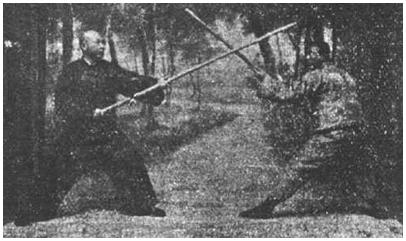
第三圖說明
EXPLANATION OF PHOTO 3
甲隨乙往外撥時甲鎗換式由上方灣刺乙足如圖是也
When B deflects outward, A changes his posture, stabbing toward B’s foot from above. See the photo.
乙隨甲刺足時速將足往囘退步乙鎗隨甲鎗往裏撥去乙鎗尖往下斜伸如圖是也
When A stabs toward his foot, B quickly draws his foot back, his spear going along with A’s spear, going inward to deflect it away, his spear tip extending downward diagonally. See the photo:

第四圖說明
EXPLANATION OF PHOTO 4
甲鎗隨時返刺乙面足往前上步雙手一氣協助鎗力如圖是也
A then stabs to B’s face, his feet stepping forward, both hands acting together to assist the spear’s power. See the photo.
乙見甲鎗刺來乙步往囘退步身側蓄勁雙手將鎗尖斜立向上方往囘抽勁如圖是也
When B sees A’s stab coming, he retreats, turning his body sideways to store power, and uses both hands to make the spear tip stand diagonally upward, drawing back. See the photo:

以上為散鎗甲刺完四鎗乙然後可上步還擊四鎗如甲刺相同甲換退步如乙撥法一樣為甲乙連環往復四散鎗
From the above spear techniques, once A has done his four stabs, B then can advance and attack with the same four stabs that A used while A changes to retreating and performing the same deflections that B has done, and A and B go continuously back and forth with the four sparring techniques.
用法日久鎗力敏捷
Drilling these methods daily over a long period, one’s spear technique will become quick.
你鎗扎,我鎗拉,你鎗不動,我鎗發,你鎗來似箭,我鎗撥如電,你鎗金鷄亂點頭,我鎗撥草尋蛇也不善
When your spear stabs, my spear pulls. When your spear does not move, my spear stabs. When your spear attacks like an arrow, my spear deflects like a lightning bolt. When your spear is doing the technique of GOLDEN ROOSTER FRANTICALLY NODS ITS HEAD, my spear does BRUSHING ASIDE THE GRASS TO SEEK THE SNAKE to render your technique ineffective.
[STICKING]
粘黏鎗第一路說明
STICKING SPEAR – EXPLANATION OF PART 1
初起式甲面東乙面西對立持鎗式與散鎗漁人撒網式一樣對鎗時與散鎗刺法两樣亦得提起精神此身法虛靈頂輕鎗尖刺去亦要輕靈敏活然後設己鎗從人鎗換式我鎗纏繞順式接接續續
In the beginning posture, A facing east and B facing west, they stand opposite each other holding their spears in the same posture of fishermen casting their nets as with the sparring techniques. The stabbing methods are the same as with the sparring techniques [though in a slightly different order]. As before, raise the spirit, forcelessly press up your headtop, and the spearhead should stab nimbly and lively. After a while you may ignore your own spear and adjust according to the opponent’s, your spear’s coiling movements going along with his posture, continuously connected.
第一式甲提鎗進步刺胸部
A first lifts his spear and stabs to B’s chest, advancing a step.
第一式乙隨提鎗粘連靠接甲鎗步乙退一步乙鎗向上斜直雙手持鎗隨身步望後粘黏抽勁如圖是也
B then lifts his spear and sticks, maintaining contact while retreating a step, his spear going up diagonally, both hands going along with the movement of body and step toward the rear, sticking while drawing back. See the photo:

粘黏鎗第二路說明
EXPLANATION OF PART 2
甲隨乙鎗往囘抽時遂上步粘繞繞直刺乙腿上
When B’s spear draws back, A steps forward, sticking and coiling, and stabs straight to B’s leg.
乙見甲鎗刺來縮蓄身退步乙鎗隨下連往外領去鎗不離開鎗勁要綿柔才能粘隨如上圖是也两鎗形皆斜下方
When B sees the attack from A’s spear, he shrinks away his body and retreats, going along with the attack downward and leading it away outward, maintaining contact. The strength of it has to be continuously soft in order to stick and follow. See the photo (Both spears are diagonally downward.):

粘黏鎗第三路說明
EXPLANATION OF PART 3
甲隨乙往外領鎗時甲上步鎗上刺膀尖刀要綿軟如圖是也
When B leads A’s spear outward, A steps forward and stabs up toward B’s shoulder. The spearhead should be used gently. See the photo.
乙隨甲鎗不離退步綿撥甲鎗閃過鎗鋒落空如圖是也乙鎗鋒向上
B goes along with A’s spear without losing contact and retreats, gently deflecting A’s spear away so the blade lands on nothing. See the photo (B’s blade is upward.):

粘黏鎗第四路說明
EXPLANATION OF PART 4
甲鎗自下轉裏上步又刺咽喉鎗不離鎗直刺如圖是也
A’s spear goes from below and turns inward, and he steps forward and stabs directly forward to B’s throat without the spears losing contact. See the photo.
乙隨甲鎗不離一綿速退步側身雙手往囘捋勁撥甲鎗鋒落空如圖是也
B goes along with A’s spear, and without losing contact even slightly, quickly retreats and twists his body, both hands drawing back with a rollback energy, deflecting A’s blade so it lands on nothing. See the photo:
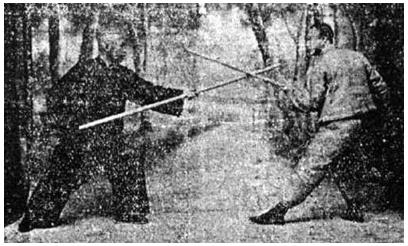
以上用粘黏刺完乙隨時不離上步還擊四鎗一鎗心二鎗腿三鎗膀四鎗咽喉如甲一樣刺法甲退步如乙一樣走法如前圖是也
After these four sticking stabs, B, without breaking contact, steps forward and does the same four stabs that A did while A retreats in the same manner that B did. See the previous photos [reversing roles].
[DISARMING]
太極採鎗圖說明
EXPLANATION OF TAIJI’S PLUCKING SPEAR
初立式甲乙對立左足在前鎗斜式第一式乙提鎗直刺胸部甲見鎗刺來時甲速將鎗如捋法望下採身法要合勁如中可將乙的鎗採落地下此為採鎗如圖是也
To begin, A and B face each other with their left foot forward, spears diagonal. B first lifts his spear and does a straight stab to A’s chest. When A sees the stab coming, he quickly uses his spear as in a rollback technique and plucks downward. For the body’s method, there should be a unified energy, and if A is centered he can make B’s spear fall to the ground. This is the plucking spear technique. See the photo:

太極挒鎗圖說明
EXPLANATION OF TAIJI’S RENDING SPEAR
太極斜刺甲腿甲隨時將鎗斜下左腿往前弓勁右足用勁蹬直以助两手两手以助鎗勁勇猛往外挒勁可將乙鎗脫手飛出五六丈遠此為挒鎗如圖是也
B does a diagonal stab to A’s leg. A then sends his spear diagonally downward, his left leg bending forward and his right leg pressing straight to assist his hands [In the photo he withdraws his left leg to stand on his right, which makes more sense.], the hands assisting the spear by fiercely rending outward. This can rip B’s spear out of his hands and send it flying many feet away. This is the rending spear technique. See the photo:

太極擲鎗說明
EXPLANATION OF TAIJI’S FLINGING SPEAR
乙鎗直刺甲膀甲鎗招起靠接乙鎗前手近處身法往外托勁两足蹬勁雙手向身前望外斜向上擲摔出去可以連人帶鎗擲出丈餘此非身手一家氣能皷盪勁如湧泉才可做到如圖是也
B does a straight stab to A’s shoulder. A’s spear lifts and draws in, sticking close to B’s spear with his front hand. His body props up outward, both feet pushing the ground, and both hands go forward, outward, diagonally upward, to fling away. This technique can connect to the opponent, lead his spear, and fling it many feet away. This is not just a matter of body and hand. When the energy can be roused like a gushing fountain, then it will work. See the photo:

太極鏟鎗說明
EXPLANATION OF TAIJI’S SHOVELING SPEAR
乙鎗直刺甲咽喉甲遂將身畧斜雙手掤鎗向身前上方鏟擲眼望上看仰之彌高亦要两足蹬勁可以將乙擲出往後退十幾步外人重有百斤如何能擲出丈餘此非邪道迷信功久自知人人皆可練到方信非說謊言也
B does a straight stab to A’s throat. A then slightly leans, both hands warding off forward and upward with the spear, shoveling ever upward, and both feet have to be pushing the ground. This can fling B away many paces backwards. How can this be if the opponent weighs two hundred pounds? This is not some supernatural skill. After a long time at it you will naturally come to know that anyone can train it until it is a reality and that these are not exaggerations. [See the photo:]

此四鎗皆二人對手單練使用的要法子甲乙無論先後皆可每一式一式單練各不相連以十二鎗叙完又有一路纏鎗
These four techniques are for both partner practice and solo practice. When practicing them, partners can do them in any order or one posture at a time, and in solo practice as well they do not need to be linked. After finishing the twelve techniques, there is also a coiling spear method:
太極左右纏鎗法
TAIJI’S COILING SPEAR METHOD – LEFT & RIGHT
乙為纏鎗圖
B performing the coiling spear:
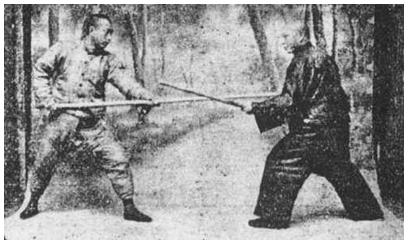
乙用纏鎗圖
B applying the coiling spear:

太極纏鎗一路說明
EXPLANATION OF THE COILING SPEAR
此鎗更有輕靈奧妙,內有千變萬化總歸一理,為纏鎗,外人看至一路式,不知裏藏八卦內含五行,散鎗內可用,粘黏鎗亦可用,擲鎗亦可用,知八卦五行十三鎗,天盤地盤內裏藏,練法要自然,用法要輕靈,捨己從人能粘連,進退上下相貫串,不丢不離纏繞之法如長江,目視曠野天無涯,腹內鬆凈如大海,手足相隨能進退,腰如車軸氣能盪,含胸拔背身內藏,以氣會意鎗剛强,至柔又至剛,同志細思詳。
This technique is still more nimble and subtle. Within it there are countless changes returning to a single principle – coiling the spear. Laymen observing it will see it as but a single method, not understanding that it contains the eight trigrams and five elements. The sparring techniques can be applied within it, as well as the sticking and disarming techniques. Understanding the eight trigrams and five elements of the thirteen dynamics spear, the realms of sky and ground are contained within it. The training should be natural and the application should be nimble. When you let go of your plans and simply respond to the opponent, you can be sticky. When advancing and retreating, the upper body and lower coordinate with each other. Never breaking contact, the coiling method is continuous like a long river. The eyes look to the horizon. Within the abdomen, it is as fully relaxed as the ocean. When the hands and feet coordinate with each other, you can advance and retreat. When the waist moves like a wheel’s axle, the energy can be roused. By shrinking the chest and pulling up the back, the body is containing inwardly. By using energy and focusing your intent, the spear technique is hard and strong. Attain hardness by attaining softness. Fellow practitioners, pay meticulous attention.
如鎗以意運氣練法,功久鎗桿上如有電力相似,與敵相接便知來意。不丢不頂,粘連走化神妙至矣。
If when practicing you use intent to move energy, then after training for a long time, your spear shaft will seem to have an electric current, and when dealing with an opponent you will then easily know what his attack will be. Neither running away nor crashing in, stick, connect, yield, and neutralize, and you will attain marvels.
祖師楊露禪軼事
AN ANECDOTE ABOUT [THE SPEAR SKILL OF] YANG LUCHAN
祖師楊露禪師,自得秘傳,心性和平,為人忠厚,家有餘資,與朋友疏財仗義,有一日某姓朋友,求楊老師借用銀洋一百元以為度用,明年奉還,露禪師故意戲曰,如借我錢自得一許,你可雙手握我鎗,將你挑上瓦房,你如占足不穩,你借無效,某乃許,如法作去,視師以意運氣將鎗一抖,某姓起上瓦房,心內驚癡,立如木人,身形前俯式,祖師笑為扶梯,某姓遂下曰,其驚不少,祖師笑曰,故與戲耳,遂付洋一百元,其人歡喜而去。
Yang Luchan obtained the secret teachings, and since then his disposition has been mild and his conduct toward others has been considerate. When there was extra money in the house, he was generous with it in helping his friends. One day a friend asked Yang to lend him a hundred silver coins to cover his expenses and said the loan would be repaid by the next year.
Yang felt in the mood for a practical joke and said, “If you borrow my money, consent to one thing. Grasp my spear with both hands and I will make you rise up onto my roof tiles. If you are not standing stably, you can take the money without having to repay it.”
The friend agreed, but on the condition that Yang actually pulled it off. Yang, using intention to move energy, gave his spear a shake and the friend rose up onto the roof. The man was amazed and stood there the way a simpleton leans forward. Yang laughed, calling for a step ladder to be brought.
The friend came down and said, “Well, that was quite a surprise.”
Yang laughed and said, “Just a bit of fun.” Then he gave him the hundred coins. The friend was delighted and went on his way.
楊健侯太師軼事
AN ANECDOTE ABOUT [THE SPEAR SKILL OF] YANG JIANHOU
昔西安有達官季四者嗜技擊而好學聞楊氏得武當秘傳至京延先生館其家從學月餘畧窺拳法鎗劍運用之妙時以靜勝柔克之說為談助先生之名因以益著時秦有王大力者號紅店客能舉五百斤日行三百里善大刀好大鎗藝冠秦中授徒五百餘聞季之言意不信也走求與先生較先生謝曰王敎師苦功積久吾不如也王以先生為怯固請之且曰太極拳則久聞之矣太極鎗亦可用乎先生不獲已笑頷之乃俱取鎗入院王則力刺先生胸先生側身捋之王扣鎗便按仍蹈虛王抽鎗囘先生乃乘其囘勢用鏟鎗式震之王不覺己鎗直如炷香自傷其顏仰跌六七步外起謝曰今而後知先生之神力也盡棄其學而學焉久而不怠遇高明能學不嫉王亦不愧為豪傑矣
Long ago in Xi’an there was a high official called Ji Si. He was obsessed with boxing arts and wanted to learn. Hearing that the Yang family had obtained the secret teachings, he went to Beijing and invited Yang Jianhou for a stay in his house. In just over a month, he learned a smattering of boxing methods and the subtleties of spear and sword techniques. During that time the main topic they discussed was winning by means of stillness and overcoming by way of yielding. Yang Jianhou consequently became increasingly well-known.
At that time, in Shaanxi there was a Big Saber Wang who was known as The Guest of Hong’s Inn. He could lift five hundred pounds and travel a hundred miles in a single day. He was superb with the big saber and great with the large spear. His skill was the best in Shaanxi and he taught over five hundred students. He heard Ji Si talk of Yang but could not believe him, so he went to Yang and challenged him to a match.
Yang refused and said, “Teacher Wang, as you have trained so hard for such a long time, I am no match for you.”
Wang accused him of being afraid and insisted upon a match, also saying, “I have long heard of Taiji Boxing. Can Taiji Spear be of any use?”
Yang could not keep from smiling at this and nodded that it was. Then he took up his spear and they went to face each other in the courtyard.
Wang made a powerful stab toward Yang’s chest. Yang turned his body sideways, performing a rollback technique. Wang covered Yang’s spear and then pressed down. Yang again led him into emptiness, so Wang pulled his spear back. Yang took advantage of Wang’s withdrawing momentum and applied the shoveling spear technique. Wang found himself surprised and lost control of his spear, which suddenly pointed up like a stick of incense and cut his face, and he stumbled away six or seven steps and fell on his back. He got up and apologized, saying, “Now and forever I know of your magical ability.”
He threw out all he had learned and then learned from Yang, training for a long time without slackening. He had met someone better and was able to learn from him without being jealous, thus proving himself worthy to be called a hero.
單人用功法
SOLO PRACTICE METHODS
同志好武實符講求體育適合衛生之旨練習工夫宜每早晨日將出時尋淸淨地點可得新鮮空氣將濁氣放出然靜心息慮雙手持鎗東西南北均可左手在前右手在後两足騎馬式第一式右手以意會氣將鎗直搠向前斜上方前足作弓式右腿直線足根不可欠起第二式將鎗合勁抽囘往下扣身法往下坐提頂懸襠為太極之練勁右手可以練二百式然後換式左手亦可練二百式左右之力可以平均身體一樣發達
Fellow practitioners, good martial arts lay stress on health. The ideal time to practice is every morning. Before the sun rises, find a clean place where you can get lots of fresh air so you can clear any bad air from your lungs. Calm your mind and cease your worries.
Both hands hold the spear. Any direction is fine – north, south, east, west, whatever. The left hand is in front, right hand behind. The legs are in a horse-riding stance.
1. Using intention to gather energy, the right hand sends the spear in a straight thrust forward and diagonally upward. The front leg bends to make a bow stance. The right leg straightens, but the heel must not lift.
2. Give the spear a closing energy and draw it back to cover downward.
The body principles are: sit down but lift the headtop and pull the crotch up. This is the strength training in Taiji. Do two hundred reps with the right hand, then switch and do two hundred reps with the left hand. When both hands have equal power, the body is developing uniformly.
又一練法
Another method:
可以找一茂盛樹林內每天練一次練法騎馬式雙手持鎗粘靠樹上直去一百式亦可上下刷勁一百式左右皆可練習不可用鋼勁可用粘勁工久樹枝可以搖動
Find a lush forest to practice this in every day. Get into a horse-riding stance. Both hands hold the spear. Making contact against a tree, do a hundred stabs, then also swish up and down a hundred times. Practice with each hand. You must not use an abrasive energy but a sticking energy. After training for a long time, the tree’s branches can be made to shake.
單練對練用功純熟
又變化各種秘法
有三轉九花金鷄亂點頭(身前後合勁)
遇敵必勝囘馬鎗(敗中取勝)
八步趕船追命連環鎗(足尖點地)
撥草尋蛇鎗(两膀左右分勁)
紛紛瑞雪梨花鎗(練此不易)
蛟龍擺尾掃地鎗(在腿腕)
太上壓頂鎗(此鎗自上而下)
圓轉如意鎗(從心所欲)
十三鎗外變出八鎗用功日久自得之
When the solo practice and partner practice have been trained to familiarity, there are also variations and various secret methods, such as:
[1] THREE SPINS AND NINE FLOURISHES and GOLDEN ROOSTER FRANTICALLY NODS ITS HEAD (the body forward and behind having a closing energy),
[2] TURNING-STANCE SPEAR, which when facing an opponent is sure to win (creating victory from a bad position),
[3] CHASE THE BOAT WITH EIGHT STRIDES and SURVIVAL-SEEKING CONTINUOUS SPEAR (toes touching down),
[4] BRUSHING ASIDE THE GRASS TO SEEK THE SNAKE (going side to side with both arms),
[5] SNOW FALLS THEN PEARS BLOSSOM (which is not easy to practice),
[6] FLOOD DRAGON SWINGS ITS TAIL TO SWEEP THE GROUND (aimed at the ankle),
[7] EMPEROR CRUSHES THE HEADTOP (the spear going from above to below),
[8] and CIRCLING AS YOU PLEASE (doing whatever you want).
Beyond the thirteen techniques, there are these eight, and with hard work over a long period you will naturally obtain them.
自上古三皇治世歷代用武莫不以鎗為先故鎗為長兵刃之祖劍為短兵刀之祖練武鎗劍不可不學鎗有銅鎗鐵鎗自古名稱甚多長短不一長有一丈餘的八九尺的惟太極鎗長七尺五寸今同志用七尺亦可鎗法忽上忽下忽收忽放出去如箭收囘如線眞有神出鬼沒之奇仙人難測之妙如鎗活活潑潑柔如長蛇飛舞時宛如梨花雪片紛飛眞我國國粹世傳之秘寶也
Since the time of the first emperors, warriors throughout history relied first of all upon the spear. Therefore the spear is the ancestor of long-bladed weapons as the sword is the ancestor of short-bladed weapons. If you train in martial arts, the spear and sword must be learned. The spear tips were made of bronze or iron. They have had many names since ancient times. The lengths have varied from eight or nine feet to ten feet, except the Taiji spear which is seven and a half feet, although nowadays people use spears of seven feet. The method of the spear is to suddenly raise and suddenly lower, suddenly gather and suddenly release, to shoot like an arrow and retract like a string. Truly it has the marvels of appearing like a spirit and disappearing like a ghost, and the subtlety of an immortal’s incomprehensibility. When the spear is very lively, it is as supple as a snake dancing. Sometimes it is just like the fluttering of pear blossoms or snowflakes. Truly it is the essence of our culture and a treasure to be transmitted through the generations.
鎗分採 挒 靠 去 捋 擲
The spear techniques divide into: plucking, rending, crowding, sending away, rolling back, and flinging.
–
雜說
MISCELLANEA
[1]
有人欲學拳,問我內功拳好,外功拳好,我說自古武聖人所傳之拳皆好,全在得傳與否耳。
Someone wishing to learn boxing arts asked me, “Are the internal styles good or are the external styles good?”
I said, “All martial arts passed down from experts long ago are good, and all that really matters is whether or not you are obtaining what was passed down.”
又問曰,武當拳好,少林拳好,我說你願學武當練太極可也。你願學少林拳練少林拳可也,隨各人所好而學可也。
He then asked, “Is Wudang Boxing good or is Shaolin Boxing good?”
I said, “If you want to learn Wudang, try Taiji, and if you want to learn Shaolin, Shaolin will do. One can learn whatever one thinks is good.”
有人問太極拳幾年學好,我說同志練拳,不可以共論也,老師傅傳拳一樣傳法,各人性情不同,有一兩年學好的,有三五月學通的,亦有十年二十年不明白的。好拳不在身之高低,又不在年歲之大小,全在各人聰明耳,我學拳十有五年,常常願求學兩位老師也。
Someone else asked me, “How many years does it take to be good at Taiji?”
I said, “When you train in boxing arts, you must not think of how long it will take. A teacher will teach the same stuff to everyone, but everyone is of a different disposition. Some get it in a couple of years or even a few months, while others still don’t get it even after decades. To be good at boxing, it doesn’t matter how big you are or how old you are, only how smart you are. I’ve been working at it for fifteen years now, but I’m quite often driven to seek second opinions from other teachers.”
[2]
楊家傳出的太極拳為正宗。
The Yang family transmission of Taiji Boxing is genuine.
[3]
學拳秘法
重拳重老師,眞傳自得之。輕拳輕老師,毋須枉費力也。
The key to learning boxing arts:
If you take it and the teacher seriously, of course you will obtain the real stuff. But if you are going to look down on it and the teacher, why bother with it anyway?
[4]
露禪師軼事
露禪師在京師時有一會點穴拳者,聞名欲較。及試其技,露禪師速抄其腕用抓筋法,敵手不能伸指,又隨上提敵前足離地。師曰勿負能。念你多年苦功,不然你骨肉斷矣。其人深敬服。
An anecdote about Yang Luchan:
When Yang Luchan was in Beijing, a boxer who specialized in attacking acupoints heard about him and wanted to have a match with him to test his skill. Luchan quickly took up the man’s wrist and applied a method of arresting the tendons so he could not point his fingers, then hoisted his front foot off the ground and told him: “Don’t look down on your talents. Think of all your years of hard training. Without them your body would now be broken.” The man quite esteemed him thereafter.
[5]
(一)王宗岳先師傳浙東河南,浙東早已失傳。河南陳家溝後傳楊露禪。繼傳至今五十年以內,會太極拳者多是楊家傳的。又說永年縣豈獨楊家耶,雖有好者,亦曾授業于楊班侯門下十餘矣。所以練太極拳無出於楊老師右者也。
Wang Zongyue taught in the eastern part of Zhejiang and in Henan. In Zhejiang it disappeared long ago, but in Henan it was passed on to Yang Luchan from the Chen family. In the fifty years from then to now, most who know Taiji Boxing got it through the Yang family. Also it is said, “In Yongnian county, is there only the Yang family?” Although there are good boxers there, they were taught by the dozen students of Yang Banhou. Thus all who practice Taiji Boxing have been assisted by Yang Luchan.
[6]
昔北京有一練貫脚壯者,踢跌蹶功十二年,與班侯先生較,其人攻擊,上使拳打,下用脚踢。班侯先生戱其人,用左右倒輦猴化之,及無退處,班侯側身先用高探馬以引其双手,復用如封似閉,將敵跌出丈餘,其人起曰,楊先生眞神技矣。
In previous days in Beijing there was a strong practitioner of Piercing Kicks who had practiced kicking and tumbling skills for twelve years. He had a bout with Yang Banhou. When he attacked, he struck with his fist above and kicked with his foot below. Banhou was amused by him and neutralized him with the technique of DRIVING AWAY THE MONKEY – LEFT & RIGHT, but without retreating, then turned his body sideways and first applied RISING UP AND REACHING OUT TO THE HORSE to draw in both of the man’s hands, then applied SEALING SHUT, making his opponent fall down more than ten feet away. The man got up and said, “Mr. Yang, you truly have a magical skill.”
[7]
(一)說太極不能使用。前北京天下英雄所聚處。人稱侯班先生為楊無敵。如說不能擲人,蓋功夫來到耳,勿說太極拳不能用也。
It is said that Taiji is useless. In the days when Beijing was the place where fighters from everywhere in the land congregated, people nicknamed Yang Banhou as “Yang the Invincible”. If you say you cannot cast opponents away, it is because you yourself have to keep working at it until you can, and you are not in a position to say that Taiji Boxing is useless.
(一)不要懼牛力。如內功不能勝大力者何必練拳?千斤落空無所用矣。
You should not fear powerful opponents. If you think internal skill cannot defeat great strength, why would you be practicing this boxing art? If you can guide his thousand pounds of force to land on nothing, it can do nothing to you.
[8]
董英傑傳拳秘法 練功 操練
用太極要知 天時 地理 人和
Dong Yingjie’s transmission of the secret to training boxing skills:
When applying Taiji, you should be aware of time, environment, and society.
天時法,對敵時自己早不面東,中不面南,晚不面西。自己不對日光為是。地理法對敵先觀地形寬窄高下。自己占底處相宜。人和法,雖較要客氣不必失義氣。
Time: When facing an opponent, do not face east in the morning, south at noon, or west in the evening, because you should not be looking toward the sun’s glare.
Environment: When facing an opponent, first observe the immediate ground, taking note of whether it is wide or narrow, tall or low, and it is best to possess the low ground.
Society: Although it is a dispute, you should still be polite and not find reason to abandon your sense of honor.
[9]
謹防敵人虛幌之手
Beware the opponent’s making feints.
[10]
太極分文武
太極能養身不能打敵,文功也。能打人不會養身武功也。軟太極法方是眞太極用法。能敎人養身又能對敵,修養使用兼全,為文武完全太極。
The civil & martial in Taiji:
In Taiji, if you can cultivate your health but cannot fight with opponents, you have achieved the civil aspect, or if you can fight with opponents but do not know how to cultivate your health, you have achieved the martial aspect. The way of softness in Taiji is the true method of application in Taiji, for while it can teach people how to cultivate their health, it is also supplies the ability to deal with opponents. Build both health and self-defense simultaneously, for it is both the civil and martial aspects that make for complete Taiji.
[11]
(一)練太極有靜坐養神法,行動活血法。
In the practice of Taiji, there are methods of both silent meditation to nurture the spirit and movement exercises to improve the circulation.
(一)人之强弱以氣血為主。楊老師的拳開展暢舒,最能舒筋活血。身體弱者,練楊老師的拳功效頂大。
One’s strength or weakness depends on one’s circulation. As Yang Chengfu’s boxing is unfurled and comfortable, it is superior for loosening the sinews and invigorating the circulation. If your body is weak, practice Yang’s boxing art and the effects will be great.
(一)前幾十年人人皆是輕武重文。若將讀書有半的功夫移練武術當可反弱為強。今國家提倡武術,人人從事體育,心開放了。以後定有不可限量武術。大家從此注重武術了。
Previously for many decades everyone had a low regard for the martial and a high regard for the literary. If they would have taken half the effort they put into reading and put it toward practicing martial arts, they would surely have transformed their weakness into strength. Nowadays the nation encourages martial arts and everyone is engaged in physical education. Their minds have opened to it. At this rate, martial arts will go on forever. From now on, everyone will see it as important.
[12]
(二)有此太極拳書即為證書。書皮裡可寫本人姓名。如是楊傳同志。有此書者楊老師無不盡力指導,一切歡悅敎授。
Possessing this book of Taiji Boxing certifies you. Within its covers can be written your name. It is like Yang is teaching you personally. For those who have this book, he is always doing his best to give guidance, always happy to instruct.
[13]
今太極拳各樣子甚多,同志難以分淸。敬告一法,可知無論何人傳的,能柔能剛能舒筋活血就對;還有一文武驗法,觀其兩膞皮膚甚軟,骨肉甚沉重就對,為文知法。論使用法,能用太極方法姿式不亂,從從容容將人跌出就對,為武知法。若用力亂打,雖勝為僥倖,定非眞傳,不足為法,同志容易辨認太極拳也。
Nowadays there are so many versions of Taiji Boxing and people have a hard time distinguishing which is authentic. Here is how you can know: no matter whose lineage it is, if it can be both supple and solid, and if it can loosen the sinews and invigorate the blood, it is real. You can also test them in terms of the civil and martial aspects. Examine his arms. If the skin is soft and the bones and flesh are heavy, it is real. That is the way you can tell according to the civil aspect. As for application, if he can apply Taiji techniques without his postures falling into disorder and discard opponents in a leisurely way, it is real. That is the way you can tell according to the martial aspect. If he uses effort and strikes in a chaotic manner, he can win only by getting lucky. That version is certainly false and worthless. See, you easily can recognize Taiji Boxing.
[14]
太極拳有分筋挫骨之手,有點血之手,有陰手,有陽手,有五行手,有入骨拳,有剝心捶,有眼虎肘,有貼山靠,有鴛鴦腿,有刀掌劍指,有刁拿手,有隔山打牛之能力。此非眞打牛而言,皮膚無痛而內受傷矣。
There are these skills in Taiji Boxing:
– Tearing the Sinews & Breaking the Bones
– Striking Acupoints
– Passive & Active Hands
– Five-Elements Hands
– Marrow-Penetrating Punch
– Heart-Removing Punch
– Spying-the-Tiger Elbow
– Too-Close-to-the-Mountain Bumping
– Mandarin-Duck Kicks
– Saber Palm & Sword Finger
– Slyly Seizing Hands
– Bypassing the Mountain to Strike the Ox
(This last one does not have anything to do actually striking an ox. The meaning of the phrase is to cause internal damage with no external sign.)
[15]
太極拳為內家拳,俗稱內功拳。拳術門頂厲害的是內家拳。如同志學成功之後,千萬留一分慈念,不可輕易用毒手打人,勿負先師遺敎也。
Taiji Boxing is an internal style of boxing. It is commonly called Internal Skill Boxing. Within the variety of schools of boxing arts, the internal styles of boxing are the most devastating. If you successfully learn this art, you absolutely must maintain a quality of mercy and must not rashly use deadly techniques to strike opponents. Do not dishonor what has been passed down from previous teachers.
[16]
太極拳術盛行於國中,今之學拳者,莫不以練太極為最高。但所學各人目的不同,有鍛鍊身體者,無論何人敎皆可。目的在學使用法,非高明者敎不可。
The Taiji boxing art is the national fashion. People who study boxing arts nowadays all think practicing Taiji Boxing is the best choice. Yet students all have their own agenda, and if your aim is to exercise your body, you will get that far no matter who your teacher is, whereas if you want to learn methods of application, it will not work without a qualified teacher.
[17]
鍊太極拳能轉弱為強,確有反老還童之功。欲拳速成,謹忌煙酒色宣有節,起居定時。各種損身嗜好不可多有。
Practicing Taiji Boxing can transform weakness into strength. It truly has the effect of reversing age into youthfulness. But if you want to succeed at it quickly:
– sincerely forbid yourself smoking, alcohol, and sex, and be determined in your restraint,
– maintain a daily schedule,
– and any hobbies that diminish your vitality must not be engaged in often.
[18]
傳拳始自武當少林两派,至今還是分門別戶的,同是少林寺侍出分為餘派,武當山傳出的,至今分派亦不少,若說合一,實所不能作到的,若就太極拳而論槪多數是楊祿禪師以後傳下來的,今竟分東派西派,各自贊美,初學人是難分淸的,我亦說我的拳好,究竟那個好,理想知道各姿式不同,有說長力的,有說長巧的,無論如何,太極拳理不能两說也,不得眞傳,不知所以然也。
The boxing arts that we have now all began with the two main branches of Wudang and Shaolin, which are still so different from each other. One feature that is the same between them is that they have each branched off into many further styles, but to suggest they were united as a single art would really be more than we can say. If we narrow the discussion to Taiji Boxing, most versions have come down through Yang Luchan’s transmission, which has nowadays split into branches east and west. Each says it is the best and beginners have a hard time being able to tell. I also say mine is best, but ultimately which one is? The best thing to do is to make yourself aware of the postural differences between them. Some say their version is more powerful while others say their version is more sneaky. It makes no difference, for Taiji Boxing theory cannot be split into different branches. Although if you do not obtain the real transmission, you will not understand this.
[19]
(一)學拳之法有二,作朋友年歲相當亦可學拳,拜老師亦可學拳,有恒心皆可學拳成功也。
There are two ways to learn the boxing: work with friends your own age or do obeisance to a teacher for instruction. As long as you have perseverance, you can learn it successfully in either case.
[20]
(一)拳術敎不敎,全在學拳人,不在老師,略如言之,近人盛知太極好,有心想學,又恐老師不眞傳,未入門先懼三分,老師雖欲傳,烏何能哉,多學家,半途而廢,同志祇知咎其師不傳,不知問其自己不學,以為說老師不傳者戒,比仿劉備欲請孔明,未審肯出山否,初請,再請,三請,孔明欲不出,安得能乎,以為學者法,願同志普及太極拳者慮。
In boxing arts, what is taught or not taught is entirely up to the student rather than the teacher. The reason is simply this:
Everyone these days understands that Taiji is worthwhile and they have a mind to learn it, but they worry the teacher might not have the real stuff and before they have even made it through the door, they are already doubting a third of it. And so even if a teacher wants to pass it down, how would he be able to? Most students only go halfway and quit anyway, then only think to blame their teacher for not teaching and never imagine a need to examine their own neglect of learning. Yes, for those of you who claim your teacher did not teach you, this is an admonishment. It is like Liu Bei wanting to hire Zhuge Liang before asking if he was willing to leave his mountain or not. Liu Bei invited him, then pressed him a second time, and a third time. If Zhuge Liang really did not want to leave, what could Liu Bei have done to obtain his services? This is what students are like. I am hoping that fellow practitioners who are spreading Taiji Boxing will consider this point.
[21]
(一)學一種好東西,是要費點精神的。
Learning something well requires putting some heart into it.
[22]
(一)看書得到易處,莫託言己能,勿負作者苦心也。
When you gain something from a book and it changes you, do not hold it up as something coming from your own experience. Give credit where credit is due and please do not disrespect the author and the pains he took to write for your sake.
[23]
楊老師傳拳很公開的,授人同是一樣敎法,何以有優劣不等,蓋人人性質不同,聰明不同,授法悟通與否不同,蓋太極理甚深,非一日能懂,陞階有級,老師授法,一叠一叠來的,若未學到奧妙,半途而廢,若說老師不眞傳,誠為謬說,日淺功淺,就說出金石之言,亦不懂的,慢慢繼續進學,莫有不敎之理也。
Yang Chengfu will teach boxing to anyone and teaches everyone the same. So why do some turn out better than others? Because everyone has a different nature, a different degree of intelligence, a different capacity to understand the principles. Also because Taiji theory is rather deep and takes more than one lesson to grasp. Since progress is a step-by-step process, Yang teaches in a step-by-step manner. If you only go halfway and quit before learning the essence of it, to proclaim that the teacher does not have the real stuff is truly an absurd assertion. If you put hardly any time or work into it and then demand it pay off with glittering results, you simply do not understand. By gradually and continuously advancing in your learning, there will not be a notion of neglect in the teaching.
[24]
楊老師有一日行樂,演使用法,與人王保還搭手,用按法,將其人跌出三丈餘外,眞有奇觀,老師之使用法,與敵人搭手,敵人足下如無根,即站立不定,看楊老師面貌極從容,手足極輕靈,只以抬手,敵跌出如射箭之速,楊老師的拳,眞妙極了,人人莫不敬服。
Yang Chengfu one day felt like surprising us while demonstrating applications. Having crossed hands with Wang Baohuan [see list of Yang’s students], Yang applied the pushing technique and Wang stumbled away more than thirty feet. It was indeed a wondrous sight. In Yang’s method of application, when crossing hands with an opponent, the opponent’s feet seem to find no footing, which compromises his ability to stand. Take a look at Yang and you will see his face is completely calm and yet his hands and feet have tremendous dexterity and agility. He only has to lift a hand and the opponent will stumble away fast as an arrow. Yang’s boxing skill is really amazing. Everyone strongly admires him.
[25]
太極本為內家拳,如姿式正確,內理明白,即是太極拳,如姿式不正確,內理不明白,雖姿式類太極,與外家拳無異也。
Taiji is fundamentally an internal boxing style. If you are doing the postures correctly and understand the internal principles, it qualifies as Taiji Boxing. If you are not doing the postures correctly and do not understand the internal principles, then although it may look like Taiji, it is no better than an external style.
[26]
自古之拳,定不傳得寶,忘師之人,日後能不忘師傅,定得眞傳,可無疑焉。
It is certain that boxing methods from ancient times have not been passed down faithfully. People may move on from their teachers, but if as time passes they are still able to remember what their teachers have passed down, it is certain the true transmission will survive.
[27]
(一)練太極拳,學使用法為必要,同志欲鍛練身體者,亦必學使用法,如不學使用法,無趣味,多有半途而廢者,以致有阻身體强壯進步,如學會使用法,並非無故打人,可與朋友研究妙理,你打我化,我打你應,滔滔不絕,各種變化,生生不己,知道太極拳有無數變化,手舞足蹈之樂,日日幸趣增加,繼續不忘之樂,年年練習,身體由此而强壯,練身必學使用法,而况有心對敵乎,所以同志練太極拳,必定學使用法可也。
To practice Taiji Boxing, learning the applications is crucial. Even if you are someone who is only doing it to exercise your body, you still need to learn the applications, because if you do not learn the applications, you will get bored with it, like most of those who stick with it only halfway and then quit, with the ironic outcome that you will also have abandoned your body’s chance to be developed by the exercise. If you learn the applications, it is not for the purpose of fighting, but so that you may investigate the subtleties of the theory with your fellow students:
You attack me, I neutralize it. I attack you, you adapt. There is a ceaseless flow of all sorts of transformations manifesting endlessly…
When you understand that within Taiji Boxing there are countless transformations, the joys of moving your hands and feet in this way will become more intriguing by the day, a constant and addictive pleasure. Then after years of practice, the body will be strong and robust. Thus building up the body requires learning the applications. And of course it is even more important if you do also have it in mind to deal with opponents. Therefore to practice Taiji Boxing, it is essential to learn the applications in order to get it right.
[28]
(一)練太極拳提倡武術
(一)練太極拳轉弱為强
(一)練太極拳發育體格
(一)練太極拳多活十年
Practicing Taiji Boxing:
– promotes martial arts,
– transforms weakness into strength,
– develops the physique,
– and adds years to your life.
[29]
(一)此書前十三式,七十八個姿式,九十四個練法圖,同志初學拳,按圖能以學拳,學會就懂的用法,此書好極了。
The Thirteen Dynamics solo set in the first half of this book has seventy-eight postures [in total] and ninety-four photos [fifty-eight distinct photos, one hundred twenty-two in total, leaving “ninety-four” to make no sense at all]. My fellow practitioners, when you begin learning the boxing, you can learn by referring to the explanations for each photo. By learning in this way, you will immediately understand the function of each posture. This book is great.
(一)此書後三十七圖,皆二人對敵實習法。
The thirty-seven application photos in the second half of this book all depict methods of practicing [the postures in the solo set] with a partner.
[30]
(一)同志練拳,無論武當,少林,成功後,切不可目中無人,妄自高傲,常言人外有人,天外有天,能人背後有能人,理之當然也。
When any of you train in boxing arts, be it Wudang or Shaolin, after you have succeeded in it, be sure not to forget about other people and become presumptuously proud. It is often said that “there’s always somebody better” and “after every skilled person you meet, there’s another one”. This truth is simply the way of things.
[31]
自古拳術一門不以錢財為重,要以義氣當先,與老師三五百元亦可,不與老師一文錢,老師一樣喜歡的,朋友之情始終如一。
In boxing arts as a whole since ancient times, wealth has not been considered to be important. Honor is the priority. It is enough to give a teacher a few hundred bucks, but even when there is no offering of money, the teacher is equally pleased. What is constant is a sense of comaraderie.
三人同行必有我師,十室之邑必有忠信,學太極同志,皆我師也,朋友講論,全在自悟。
Confucius said, “When several of us are engaged in the same thing, I am certain to have a teacher.” He also said, “In a town of only ten homes, there is sure to be sincerity.” All students of Taiji are my teachers, for you are the friends I discuss it with. This is entirely a matter of personal realization.
[32]
有說一力强十會 (有禮)
我說一巧破千斤 (不錯)
There is a saying: “An effort will succeed in a dozen encounters.” (This is reasonable.)
My saying is this: “One skillful moment defeats a thousand pounds.” (This isn’t bad either.)
[33]
原譜與解說分佈書內,似乎次序紊亂,此次作書均分放在相當地點,學拳同志得意處豈淺鮮哉,講義在前後,原不可拘也。
The original manuals had explanations dispersed among the contents rather arbitrarily. In this book they are divided up in a balanced way and correspondingly placed. In learning boxing arts, when you grasp the concepts, that is nothing insignificant, and so the explanations of ideas throughout really should not be allowed to get in the way of your understanding.
[34]
蓋聞欲得非常之寶者,必有非常之功用,求非常之功用,必有非常能識之人指導之,昔有趙璧,無和氏不能知其寶,雖有千里馬,無伯樂誠難知其奇,天地之大,珍寶繁多,視物不能及師曠之聰,可不惜哉,欲求寶者,至在目前,猶恐不視耳,譬學體育者不學我國寶,化數千金而赴歐美者,豈不舍近求遠,然而不知國寶,勿怪之哉,余今為强國計,今為同志習體育計,欲得國寶,敬告諸君練太極拳是也,練太極身體與精神平均發大,延年益壽,百功庽焉,而且防身又能對敵,此拳益處,筆難盡述,練後自得之,太極拳可稱非常之寶,非他拳之可共論也,願同志諒之。
I have heard it said that if you want to gain an extraordinary treasure, it will require extraordinary work, and if you seek to do extraordinary work, you need to have an extraordinarily capable and knowledgeable guide. Long ago, there was the jade disc owned by the state of Zhao, but without Bian He, we would not have been able to know of such a treasure, and although there was the Thousand-Mile Horse, without Bo Le to point it out, we would never have heard of its talents.
The world is vast and its gems are many. But when we see people incapable of grasping the wealth of knowledge a teacher has to share, what a pity it is. Those who wish to seek this treasure nowadays seem to fear that it is invisible, for instance when a student of physical education does not study our cultural treasure but instead exchanges all his money and goes to Europe or America to study it. How is that not a case of abandoning what is near to seek what is far? And so if you do not understand our cultural treasure, do not find fault in it.
Nowadays I plan to strengthen my nation, and nowadays you all plan to train in physical education. If we wish to obtain our cultural treasure, I advise all of you to practice Taiji Boxing. By practicing Taiji, the body and spirit will be equalized and express powerfully, it will extend your life and youthfulness, and there are so many skills contained within it, including the ability to defend yourself and fend off opponents. The benefits of this boxing art are too numerous to write down. After you have practiced you will automatically gain them. Taiji Boxing can be deemed an extraordinary treasure. Not all other boxing arts can be described so, and I hope my comrades will pardon me for saying it.
–
–
–

